
FEATURING: LOW CONSPIRACY | WARREN CHANG | SAN JOSE FOOS | ANNMARIZ Silicon Valley’s Innovative and Creative Culture ISSUE 13.4 FAll 2021 C PROFILES CONTENT MAGAZINE, SAN JOSE $14.95
“Duhkha” by Francisco Zarate


Cultivator
Daniel Garcia
Editors
Elizabeth Sullivan, Grace Olivieri
Katherine Hypes, Maddison Cleeland
Virginia Graham
Community Partnerships
Kristen Pfund
Interns
Jesse Garcia
James Garcia, Sannie Celeridad
Leopoldo Macaya, Stan Olszewski
Veronica Lechuga, Arabela Espinoza
Peter Salcido, Mark Chua
Writers
Johanna Harlow, Michelle Runde
David Ma, Demone Carter
Taran Escobar-Ausman, Albert Jenkins
Brandon Roos, Esther Young
Katie Shiver, Sonya Herrera
Publisher
SVCREATES
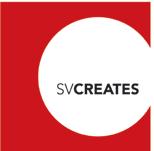
THIS ISSUE IS SPECIAL TO ME. There are several articles that I have had to bump from other issues for various reasons—COVID delays, articles not completed, photos unable to be scheduled. Therefore, I am excited to see these stories finally being told.
I have wanted to profile the artisans of the San Jose lowrider community for years, because there is misinformation about who they are and what they are like and a lack of representation of their creativity in the larger arts community. And being a kid from the East Side, it is part of my culture I wanted to celebrate. One of those bumped features was a piece on the car club Low Conspiracy. Just as we began to put the feature together, cofounder Jose Martinez unexpectedly passed away on March 12, 2021. And, what I thought would be a profile and interview with him about his 45 years of supporting and creating a South Bay car culture has become a memorial of a local pioneer. We are honored to have this issue reflect on the club that Jose “All Nighter” Martinez led. Though we are not a car magazine, we are a creative culture magazine, and Martinez’s spirit, talent, and entrepreneurship represent the ethos of our region and our publication. All of the people presented in this “Profiles” issue also emanate that same ethos—from DJs to illustrators, to bands, to dance crews. We are honored to introduce you to them and to dedicate this issue to the life and family of Jose Martinez.
Thank you, Daniel
Garcia
THE CULTIVATOR
IN
Google Downtown West
ISSUE 13.4 “Profiles” Fall 2021
C
CONTENT
To participate in CONTENT MAGAZINE: daniel@content-magazine.com Membership & sponsorship information available by contacting kristen@content-magazine.com THIS ISSUE
Flipside
CONTENT MAGAZINE is a quarterly publication about the innovative and creative culture of Silicon Valley, published by .
Low Conspiracy | Warren Chang |
|
Lovers
501(c)(3)
Photographers

Support Local Creatives CONTENT-MAGAZINE.COM 9 9 years 56 issues 800+ artist profiles
CONTENT
PROFILES 13.4
Fall 2021 San Jose, California
CULTURE
8 Google Downtown West, Alexa Arena
12 San Jose Foos, Jorge Gomez
ART & DESIGN
16 llustrator, Annmariz Milagros
20 Artist, Francisco Zarate


26 Artist, Kylee D. Dougherty

32 Painter, Warren Chang
38 Low Conspiracy Car Club, Sergio Martinez & club members
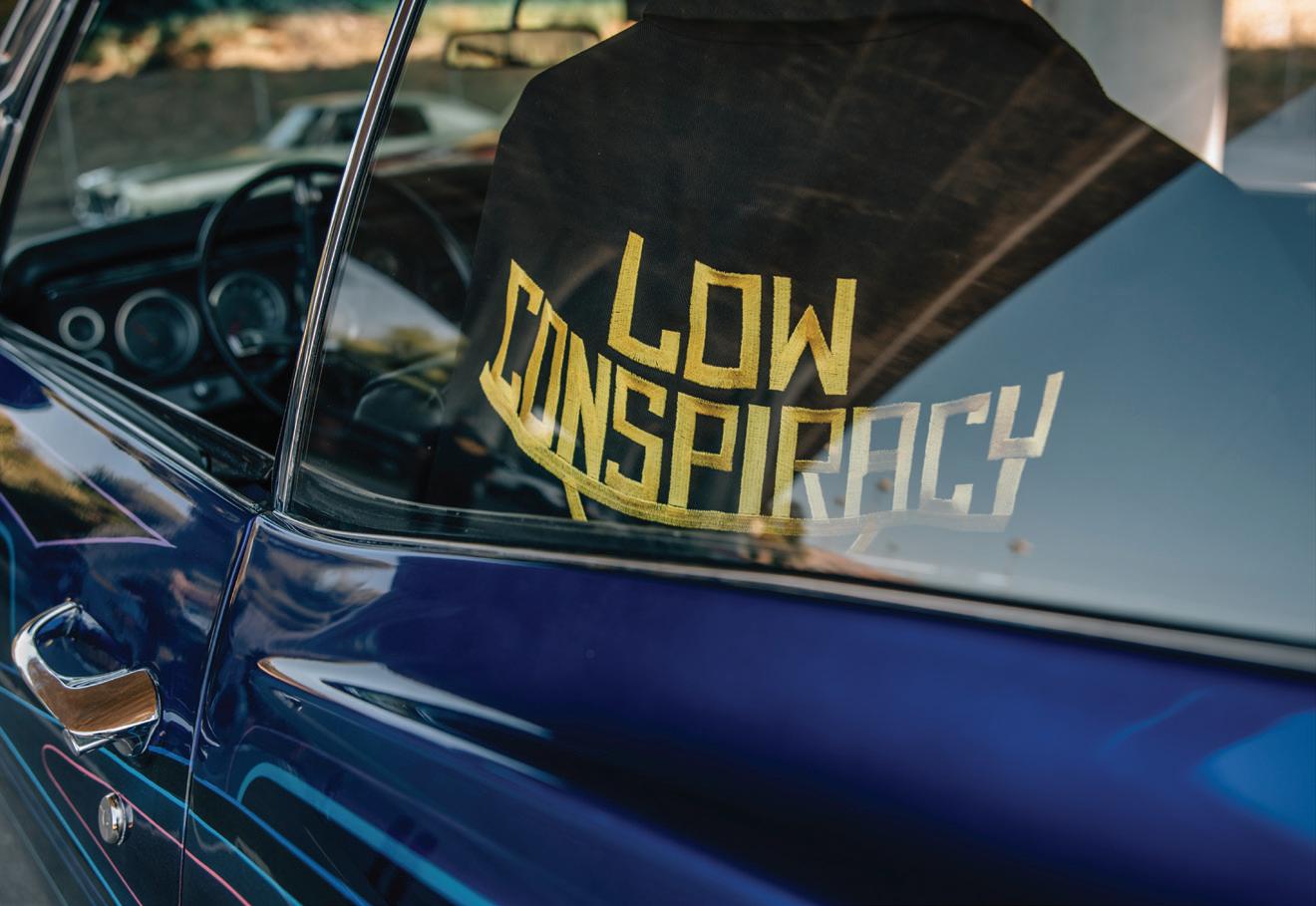
STYLE
46 Au La La Design, Au Nguyen
50 West Valley College Fashion Designers, Class of 2021
56 West Valley Fashion Editorial, Mark Chua
MUSIC & DANCE
66 HeadHunter Crew, Kerge, Scarface, Adriaddict, & Dre Hood
70 Flipside Lovers, Anthony Perez & Stephanie Ramirez
74 Barely Funktional, Pops, Hanz, Shakila, Lysn, & J-Fed
78 Album Picks, Needle to the Groove
80 Contributors

All materials in CONTENT MAGAZINE are protected by United States copyright law and may not be reproduced, distributed, transmitted, displayed, published, broadcast, or modified in any way without the prior written consent of Silicon Valley Creates, or in the case of third party materials, the owner of that content. You may not alter or remove any trademark, copyright or other notice from copies of this content. For further information, or to participate in the production or distribution, please contact us at editor@content-magazine.com
CONTENT magazine’s production is powered by
Low Conspiracy, pg. 38
Warren Chang, pg. 32
Annmariz Milagros, pg. 16
Francisco Zarate, pg. 20
WEST VALLEY COLLEGE
CREATE CULTURE CHANGE
APPLY TODAY!
westvalley.edu/art-design @wvccilkersoad
Certificate, associate’s degree and transfer programs accredited by the National Association of Schools of Art and Design.
DESIGN: Architecture, Interiors, Fashion, and UX
PERFORMING ARTS: Music, Dance, Film, and Theater
VISUAL ARTS: Studio and Art History
West Downtown Google
When Alexa Arena commutes to San Jose from her home in San Francisco, she often takes Caltrain.
“The good news is when you’re sitting on a train, you’re not gonna do a phone call or a video call,” said Arena, Google’s senior director of real estate development, in an interview with San José Spotlight. “So you have, frankly, the time to read and to make sure that you digest information.”
For the past three years, Arena was a central leader in negotiating the tech giant’s Downtown West project for San Jose, an 80acre office and housing complex that’s been called a city within a city. The complex will be located near Diridon Station, a transit hub that San Jose leaders hope will become the Grand Central Station of the West, particularly following the arrival of California’s long-awaited high-speed rail.
But for now, the station mostly serves VTA’s bus and light rail, as well as Caltrain, which runs from San Jose to San Francisco’s SoMa neighborhood. The commute provides the tech-real estate exec with a quiet time
that’s often missing from Silicon Valley’s fast-paced rat race lifestyle. “In our meeting culture—that I think has taken over the world—it’s hard to find those times,” Arena said. “You also end up in an experience on trains, in particular, where you see so much outside the window. So it does give you that mental space just to reflect.”
Arena, 44, was born in Dallas but moved with her family every few years during childhood. She has also lived in Baltimore, Chicago, Boston, and New York City.
“I think that versatility of locations and experiences definitely did a lot to give me a sense of how each culture and community is unique,” she said, adding that she moved to San Francisco 13 years ago following advice from a mentor at the Harvard Housing Institute. “He had recommended the West Coast because it was just so much more open to some of the thinking around community building and how we think of the physical environment not as a set of buildings, but as a composition of how you bring neighborhoods to life,” Arena said.
Written by Sonya Herrera
8 Profiles 13.4
Photography by Daniel Garcia realestate.withgoogle.com Twitter GoogleInCA
This
How Google’s downtown megacampus will transform San Jose’s art landscape
article was produced in a joint partnership between San José Spotlight and Content Magazine.
The executive was working in Lendlease’s California development arm when she got connected with Google. She said the company exemplifies the type of building that first inspired her to enter the real estate industry. “It was really about community and neighborhood-making versus buildings, and that intrigued me,” she said. Arena was attracted to the tech giant’s team-oriented approach to project planning.
Arena has reflected on the work it’s taken to push the massive Google project past the finish line—Downtown West was approved by the San Jose City Council in May—and the work that remains. It’s been three years since the council passed an agreement and sold several parcels of public land to the tech company for its new megacampus. Arena said she’s excited to see the project’s next stage of evolution.
“The openness of the dialogue after the MOU [memorandum of understanding] vote was really immensely appreciated,” Arena said.
Prior to the project approval, activists worked strenuously to prevent the sale of land to Google, with some chaining themselves to the chairs inside San Jose City Hall in protest.
The proposed tech campus includes 7.3 million square feet of office space, 4,000 housing units, 15 acres of parks, and a 30,000- to 50,000-square-foot community center. The project also features 500,000 square feet for retail, cultural, arts, and education uses. A quarter of the project’s housing units will be affordable.



The most challenging aspect of planning, Arena said, was figuring out how to wrap the complexity of the project around the needs of the community. “We could not have achieved this project and its goals without deep, lasting partnerships with people in the equity community, with people in the arts community, with people in the environmental community,” she explained. “You can’t do a project of this complexity, with the myriad of goals that we really want to achieve,
without a partnership mentality and a co-creation mentality.”
The pandemic, too, introduced challenges that Arena said residents faced with surprising aplomb. “It shows people in the community, their dedication to the outcomes and the objectives, that we all rolled up our sleeves and sorted through how to work through that together,” she said.
Many residents wonder how the project will blend with the rest of downtown. Arena said the key to answering that question lies 40 feet above the sidewalk. “We often talk about the first 40 feet in real estate, because that’s what you actually experience,” Arena said, adding that the developers aim to create a ground-level experience where someone is steeped in San Jose’s distinct cultures. “It is a pretty incredible culture around festivals, around pockets of San Jose, but it’s spread out. And so if we’ve gotten it right, we can bring that community together around that first 40 feet and be like, ‘This is only gonna happen in San Jose. I know I’m in San Jose, I’m
9


“It was really communityabout and neighborhood-making versus buildings, and that intrigued me.”
10 Profiles 13.4
-Alexa Arena, Google senior director of real estate development
Illustrations provided by Google.
not in a generic city’s downtown,’ ” Arena added. “It’s going to take a lot of partnership to get there.”
Central to that partnership is the fate of the area’s artists, many of whom gravitate around downtown through hubs like Local Color. Arts groups like SVCreates met with Google executives prior to the City Council’s approval of the development, and Arena said that meeting informed many of the project’s design guidelines.
“Our worst-case scenario is that the ground plane becomes too expensive to invite artists in...we absolutely don’t want that to happen,” she said. “We’re thinking [about] how to optimize the whole of the place into the right type of ecosystem that defines an authentic city...the importance of public art is a component of the project, so it’s accessible to everyone who comes o the site.”
The project’s design guidelines include prohibiting art that causes environmental disruption within the riparian setback along Los Gatos Creek or the Guadalupe River. The guidelines also call for creating art that evokes “a sense of destination to areas of high traffic and high vis-

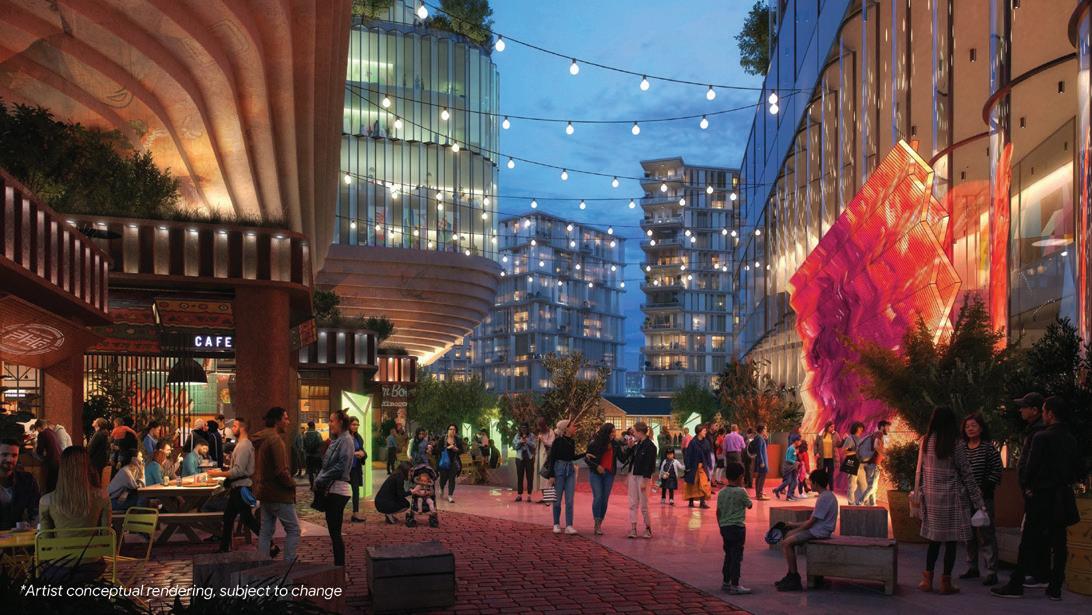

ibility, to help shape gathering places and to be a part of the place making of destinations such as a cafe, an event venue, or programmed activities.” Arena said a committee of arts advocates and residents from all over San Jose helped inform the design guidelines and requirements for public art displays.
“There’s a dedicated budget to free programming; oftentimes that will be art: performance art, other things going on, music, in those open spaces,” the Google executive said. “The entire goal of the free programming is to invite in [the] community and to make it feel like it’s a place where you don’t have to come and buy something to be a part of.”
Local Color had planned to host an artist studio in one of the buildings on the project site. However, the facility never opened, due to Santa Clara County’s COVID-19 health guidelines, according to Carman Gaines, Local Color’s member relationship manager. Arena said Google wants to keep artists and other cultural leaders working in the downtown area. “There’ll be some movement, but it is absolutely about the stability and the growth of net-
works like them who are really important to helping our arts and cultural community thrive,” she said.
Sculpture and theater are Arena’s favorite art media. The three-dimensional aspect of sculpture allows the public to experience the work and each other in a unique way.
“Art is a way to really connect Googlers and Google and society...to make us feel like we are part of something larger, to get us in conversation, to give us a shot at alternative ways of thinking,” Arena said. “Google needs art in the same way our culture needs art.” Google wants to capture the culture of San Jose in its public spaces, Arena said, and art is central to its vision of a vibrant downtown.
“San Jose has got this incredible spirit of entrepreneurship, celebration, creativity, diversity,” she said. “The goal of the downtown is to bring that all together, to access it with frequency, to feel like every weekend you can come and discover something new.” C
11
“NoteveryonehasthesameviewpointofSanJose.”

12 Profiles 13.4
-Jorge Gomez
@
SanJoseFoos
If San Jose Was An Instagram Account
WHAT EXACTLY IS SAN JOSE FOOS?
Once a simple meme account for cracking jokes, this unconventional Instagram page has since morphed into a bit of an amalgam. Skirting the clean, cohesive feeds and polished poolside shots presented by your standard social media influencers, San Jose Foos scatters in a number of directions. It’s Nextdoor network meets photojournalism with local facts, wisecracks, and quirky sightings tossed in for good measure. It’s a bunch of odds and ends you can’t quite tack down—and perhaps that’s exactly the point. Conscious choice or not, the page’s creator, twenty-something Jorge Gomez, mirrors the messy glory of city life—and for an account dedicated to South Bay community, that’s a good place to be.
“I wasn’t expecting any of this,” chuckles Gomez, referring to the 48,000-plus followers the account gained over the past year and a half. “But it kind of grew into this thing, and it evolves, and it wrestles with itself on what it’s supposed to do.” He takes a swig of coffee and pauses to survey his neighborhood cafe. Roy’s is in fine form this morning as Japantown’s gas-station-turned-coffee-shop bristles with espresso junkies queuing for their next fix.
Written by Johanna Harlow
Photography by Sannie Celeridad svnjose.com Instagram sanjosefoos
“I love this city,” Gomez comments as he returns to the conversation. That’s not some weightless statement either. A photographer and videographer by trade, Gomez’s own personal Instagram is a visual love letter to San Jose, complete with South Bay cityscapes, iconic landmarks, and urban dwellers. (Though, let the record show, he insists there’s no rhyme or rhythm to his photo choices).
“It’s not really planned out or anything,” he says with a shrug. “I’m just a dude. We’re just hanging out.”
But back to San Jose Foos. When the account first started gaining traction, Gomez started brainstorming ways to use his platform for the good of the community. “I realized there was
13
probably more potential in it,” he says. With the pandemic in full force and local businesses floundering, he decided to raise support with shoutouts and fundraiser campaigns.
To this end, Gomez enlisted designers and printmakers as well as built an entire online marketplace called SVN JOSE to offer fundraisers, funneling 100 percent of the profits right back into worthwhile groups and causes. That includes businesses like Cinebar, after the beloved dive went up in flames. That includes City Peace Project, a nonprofit trying to restore gang-damaged communities with a focus on youth; Good Cult, a collective and clothing brand; and Batman of San Jose, a masked man who seeks to raise resources for and defend the rights of San Jose’s houseless.
Why?.“Benevolence,” Gomez says. “Everyone thinks we’re in a drought—of everything—the drought of money, of following, of success, whatever…you want in life. Everyone wants to be given to, but they don’t want to give out…I want to prove that it’s actually more beneficial to give.”
Today, the San Jose Foos account also extends to local news—but more intriguing still are the takeovers. By allowing different people or businesses to post on the page for a week, Gomez hopes to showcase the many perspectives of our city. “It kind of proves the point that not everyone has the same viewpoint of San Jose,” he explains.


It reminds us that when we home in on just one piece of our city’s identity, we miss out on a larger, much more colorful patchwork of communities and perspectives. But Gomez won’t stand for that. “I was just like, ‘Nah, look. Here’s someone showing off what they do. Here’s someone else showing off something completely different.’ But guess what? We all live within a couple miles of each other.” He’s figuratively handed the keys of the account over to everyone—from Cola, a mu- sician who also manages a homeless shelter and runs a vending machine side-hustle;to Alex Knowbody, an east side photographer and lowrider aficionado; to Tanita, an Indian American immigrant, San Jose International Airport engineer, and dedicated foodie.

Profiles 13.4 14
Whenever naysayers try to tell Gomez that “outsiders” have no place in the conversation on San Jose and its identity, he calls BS. “San Jose is a melting pot,” he says, pointing out that nearly 40 percent of the people who live here were born outside the US. That percentage beats out Los Angeles and even New York. “There’s a lot going on here that we don’t always get to see.”
“I get critiqued heavily,” Gomez adds with a chuckle. “You gotta be kind of weird like me to be like, ‘Nah, I’m just gonna keep posting’…It’s not easy though. The internet’s a weird place.” He intends to stick with it. And for the account’s next evolution, he’d like to focus more heavily on original content. “I’d rather take the time to do more meaningful posts about you and your business, or you and your art,” he shares, “as opposed to reposting on the story because that kind of devalues it.”

Gomez likes to keep a low profile, and you probably won’t recognize him hanging out at your local coffee shop or taqueria, but just know your friendly neighborhood “dude” is out there somewhere, championing San Jose in all its wacky, random greatness. C
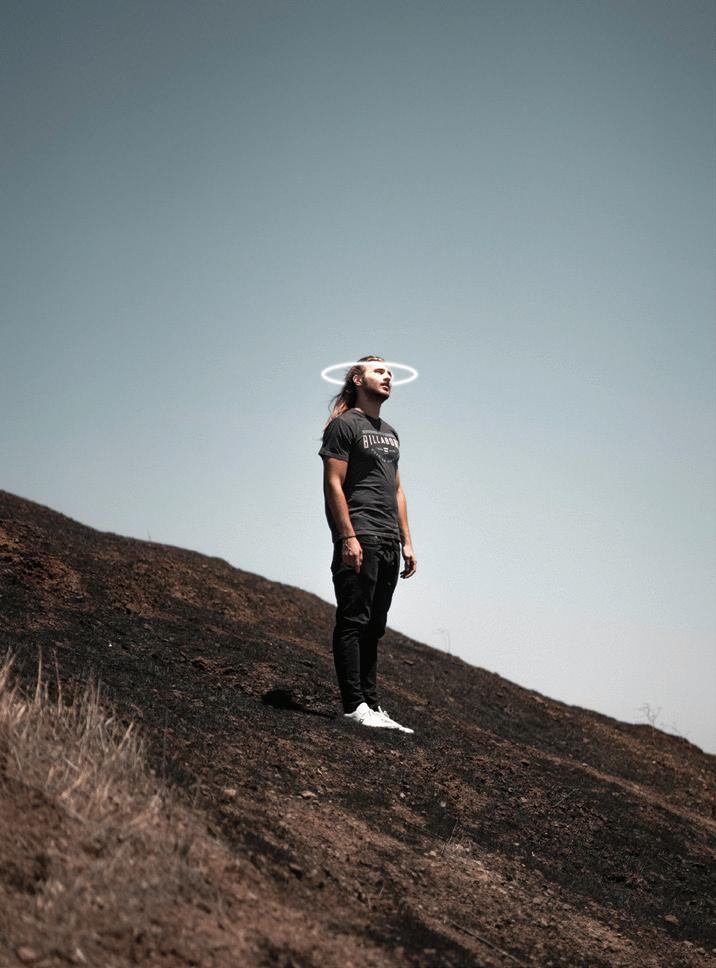
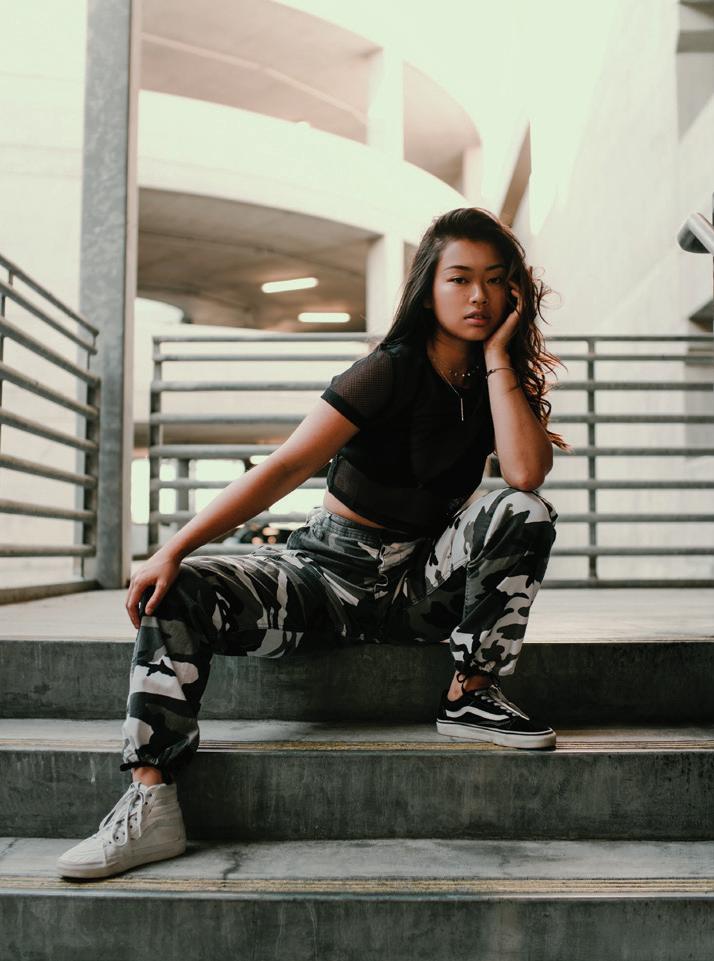

Above photography by Jorge Gomez 15

Profiles 13.4
“I wanted to create things I’ve always wanted to see for myself.”
16
-Annmariz Milagros
Written by Esther Young
Photography by Veronica Lechuga
Milagros
Annmariz Milagros is the illustrator behind the luscious, juicy, body-positive femme characters brightening these pages right now. And she does it all in the name of self-love—a journey we all could use a little push through.

She comes from a big, artistic family. They all lived in one house, where the TV was always on and usually showing cartoons. Her favorites included Power Puff Girls, Total Drama Island and lots of anime. She surrounded herself with Sanrio stationery and in her free time she would google “anime girls” to trace the eyes of Sailor Moon and the like.
Imagining new characters was the hobby she took everywhere. In elementary school, she started a comic with two of her cousins. They cast themselves in random storylines which, looking back now, she can’t make sense of. “Did we really think this is how the world works?” she laughs, but the joy of creating characters based off herself and those around her stuck. In high school, she would tear off half sheets of paper, write the date, and draw out what happened to her that day. Her friends knew about it, so “I’d draw my crushes without their faces,” she giggles.
In college, Annmariz pursued early childhood education before switching to art. She
plump asses galore, they reflect inner dialogues you just might relate to.
transferred from Mission College in Santa Clara to Long Beach State, where she joined a community of artists with interests similar to her own—illustration, character design, and storyboarding. Her goal at the time was to be picked up by a company. But gradually she realized: “I loved my style.” Freelancing freed her to “transform it as I go.”
Another awareness was coming into focus— why her characters looked like her. “I didn’t see anything that represents me,” she says. “I’m brown and big. I wanted to create things I’ve always wanted to see for myself.” She knew among her artist community on Twitter that there were others who wanted to see themselves related in cute, erotic art too.
These sweet and naughty, sexy and peachy girls do it all: thighs and plump asses galore, they reflect inner dialogues you just might relate to. Annmariz’s 2017 zine series Peach Gorl was inspired by all the blessings and curses of major life transitions: a break-up and adjusting to life on her own in the Long Beach area.
“It was scary being vulnerable with people, but also very cathartic,” she says. “I felt like I needed to purge out.” And if the purging didn’t change up her style some, well, what’s the point of being an artist? Most of her illustrations used
honeysoakedpeaches Tiktok honeysoakedpeaches
honeysoakedpeaches.webflow.io Instagram
17
Questions

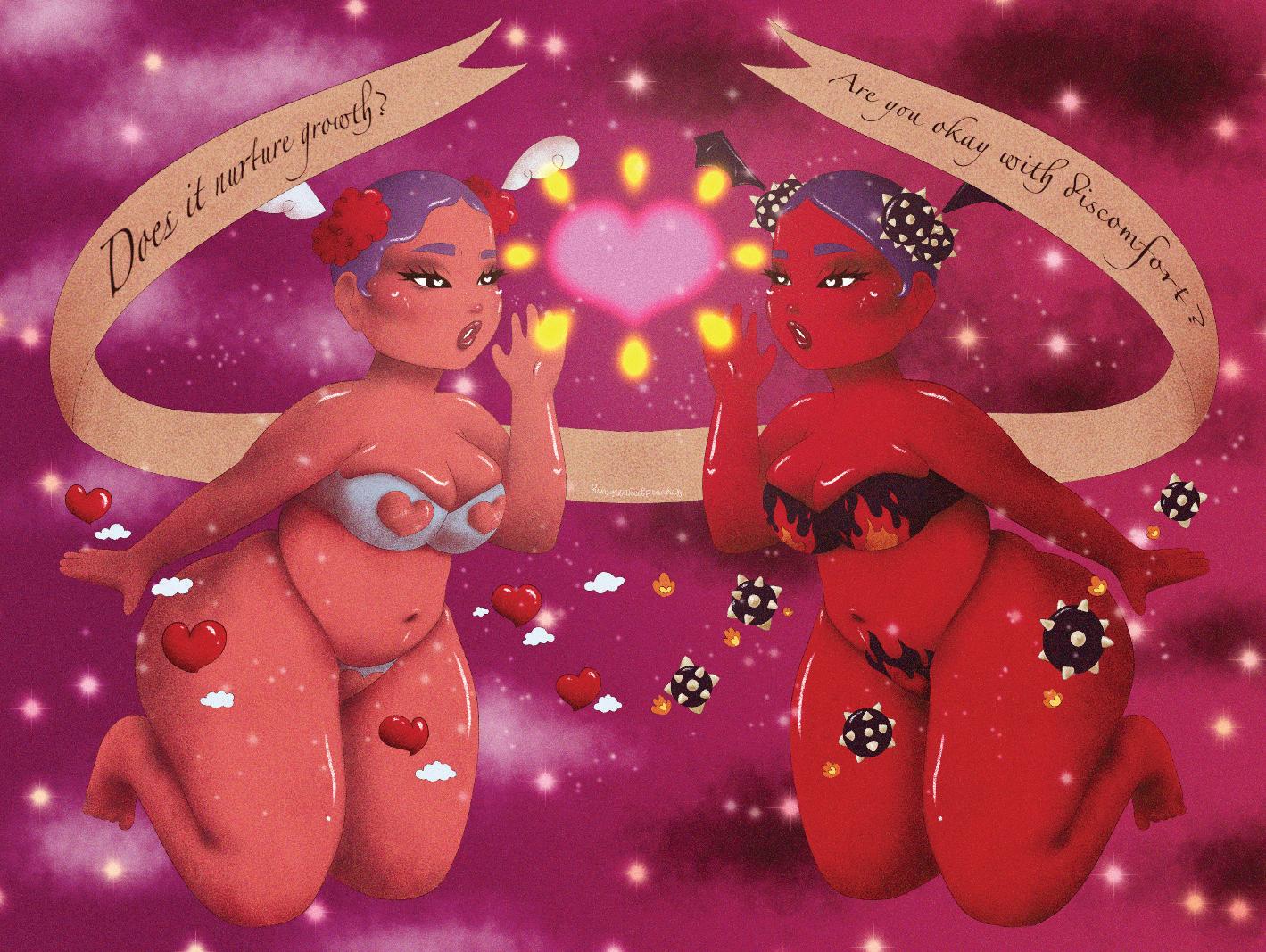
Profiles 13.4
“I didn’t see anything that represents me. I’m brown and big.”–
-Annmariz Milagros
Charcuterie BB
18
to be in black and white, but “during that time, I saw more color popping out…then all the color popping out!” Her characters started to end up with pink hair—“I’ve always wanted pink hair!”— and her new color palette was guided by bright joy.
On the weekends through school, Annmariz worked as a caricature artist at the Aquarium of the Pacific in Long Beach. For two years, she finessed her skills as an artist and as a retailer. “Especially on slow days, a lot of my day was trying to reel people in,” she explains. Once a family agreed to have their portrait done, “you had to draw as quick as you can.” She learned to finish a drawing in under three minutes; with color, under five. All the while, she interacted with the clients, asking about their day and making them laugh.
After graduation, the effects of the pandemic drew her back to family for a year. She stayed in her hometown of Milpitas, taking space during quarantine to grow her presence on social media. She also began taking commissions. “I’m still striving to diversify my characters,” she says. As she evolves, she believes her style will too. Eventually, a search for more freelancing opportunities drew her back south.
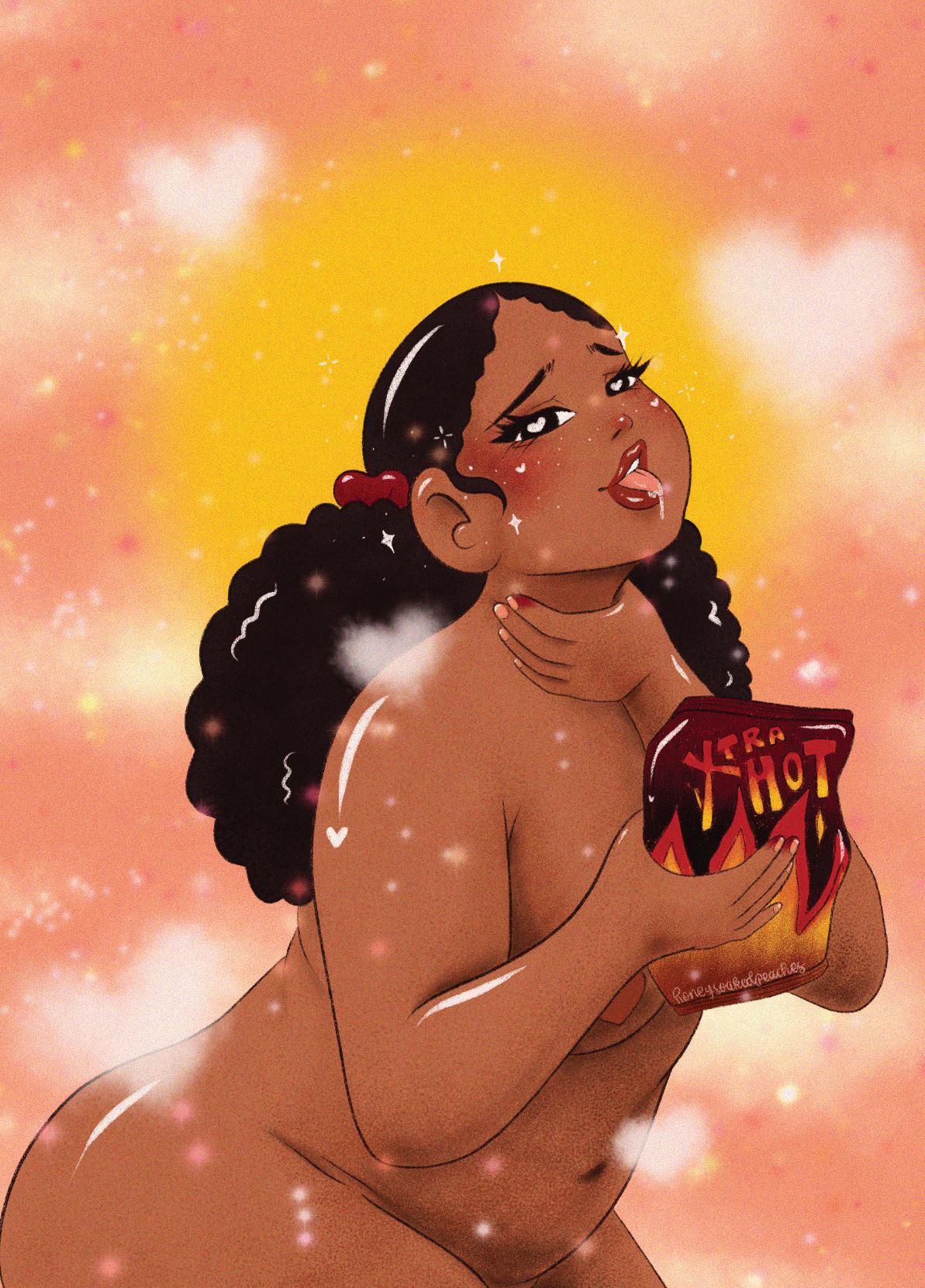
Now back in Long Beach, where she lives with her partner and a couple of their friends, you’ll find her crafting her dream day by day. She hopes to have her own studio space and meet more fellow artists working in her niche. “I’m a more introverted person, so I’m very thankful for Instagram,” she says. Online, she’s able to spark some of these relationships through mutual follows and story reactions. “I didn’t think I’d be in contact with other artists making big girl art.”
As a true morning bird, her perfect day begins with a few hours at the gym (followed by her breakfast of choice—milk and cereal), but “then it’s commissions and requests till early evening.” While she’s working, the highs and lows of her mood cycle her through playlists featuring badass female artists like Megan Thee Stallion, Nicki Minaj, Ari Lennox, H.E.R., and Jhené Aiko.
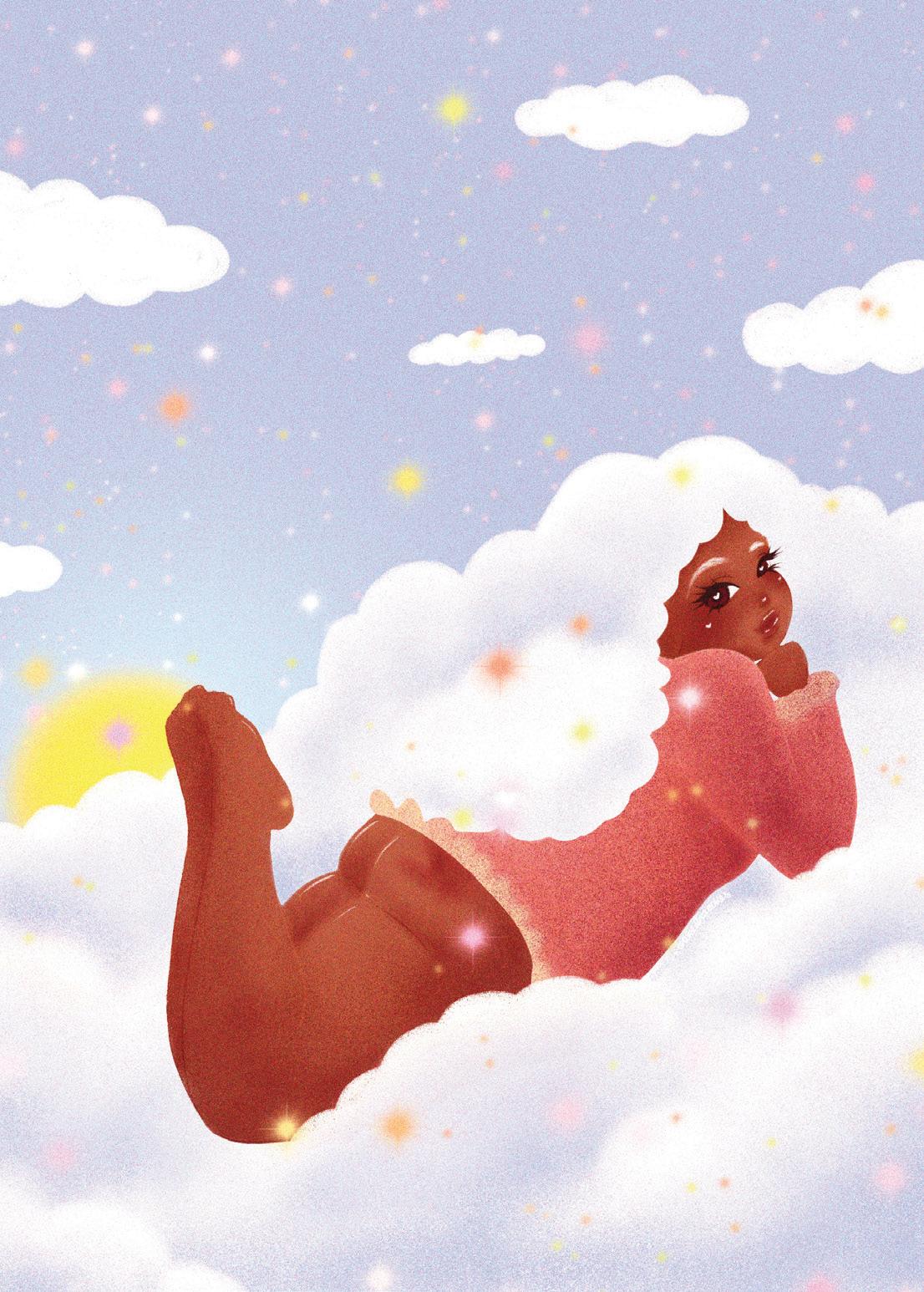
Reflecting on herself five years ago, she states, “I would’ve been shocked I’m putting myself out there like that!” Yet, looking back shows her the power she’s carried all along. C
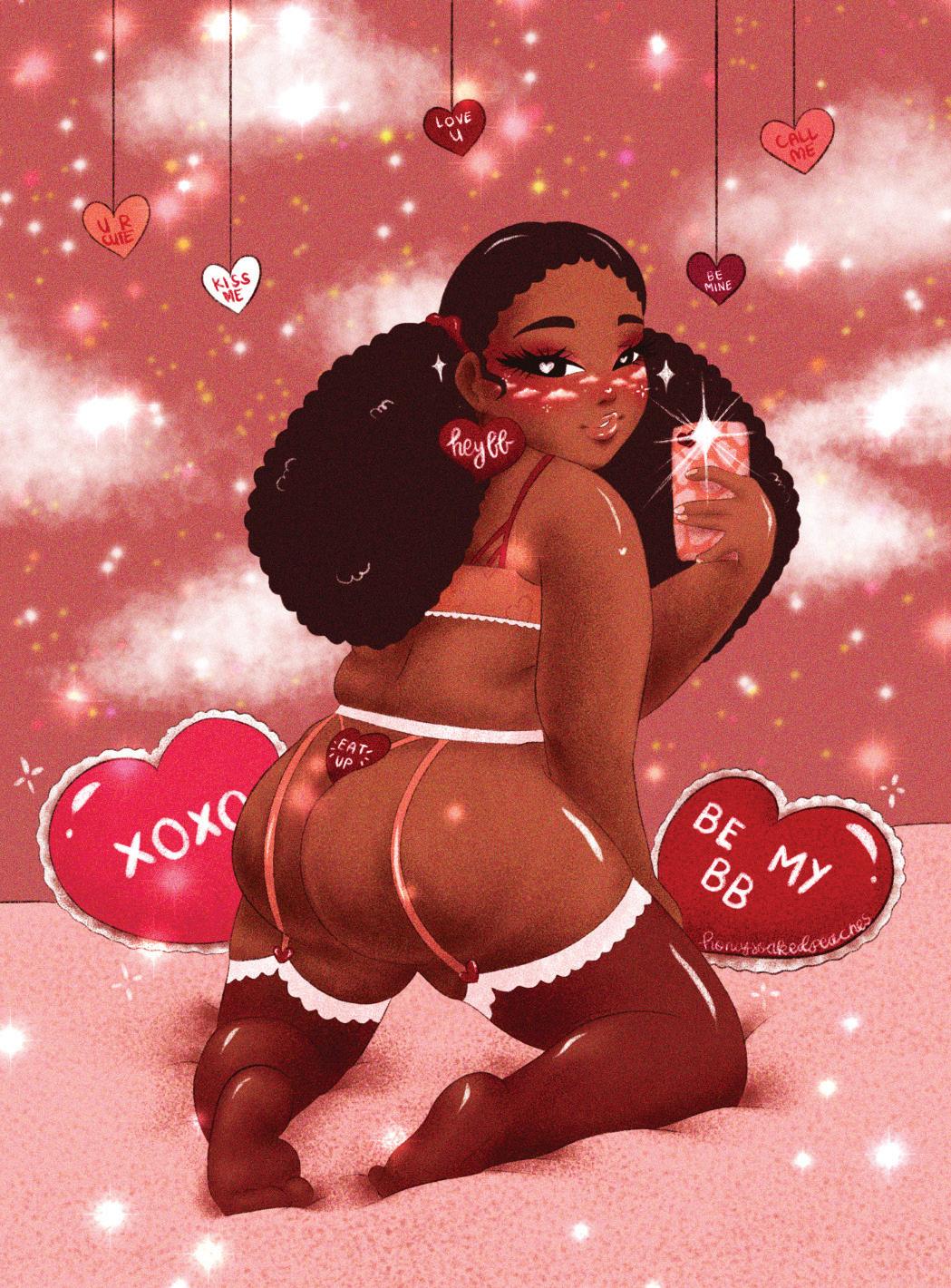 Top Left: Head in the Clouds
Top Right: Saint Honey, Patron Saint of Hot Chips and Choking Above: Be my BB
Top Left: Head in the Clouds
Top Right: Saint Honey, Patron Saint of Hot Chips and Choking Above: Be my BB
19
FRANCISCO FRANCISCO
Z
For artist Francisco Zarate, art is about making the most of the present moment. While one may believe the present moment to be apparent and discernible, Francisco’s art inhabits an esoteric in-between world, where what is being communicated may only be perceptible by those who share the same dream or hallucination. However, upon further meditation, his fantastical and disembodied visions speak more to reality and our relationship to the unknown than may appear at first glance. When he speaks about his art, it is apparent he views each piece as its own living and breathing entity. Once a piece is complete, his characters, and the subconscious world they inhabit, become something separate from their creator. Francisco creates surreal, dream-like worlds, where pudgy, naked men and women take naps on insects, ride atop fish and chickens or upon large snails with human faces. In many drawings, these same characters are worshipping and stacking giant heads of men or holding onto large snakes with human heads. Though Francisco says these visual worlds are still being fine-tuned in order to make his visions relatable, they already communicate a rich and vibrant allegorical narrative that navigates our inner struggle between our ego’s desires and the reality of our impermanent reality.
Francisco, 31, is an East Side San Jose native who received a bachelor of fine arts from San Jose State University. By day he works in the optical field and explores his craft during his free time. As a child he was always doodling and his mother allowed him to draw during church, as long as it was portraits of those at the lectern. By college, he had started to develop his characters and visual motifs in the margins of his notes, slowly bringing them to life with different poses learned from his life-drawing class. These characters have now come to form the crux of his artistic vision.
As Francisco’s dream worlds came to life, his characters became consistently nude and identical in features, which made them timeless and familiar across different pieces. As Francisco relates, “I wanted the characters to… not have a distinct wardrobe to date them or attach them to any cultural reference. I like how that detaches them from our world while simultaneously giving a feeling of familiarity, foreign but familiar.” You can see Robert Crumb as a strong influence in the pen and ink styling of facial features and exaggerated body parts. Francisco’s characters, however, take part in their activities with an aloofness that actually makes the surrounding scenarios all that more surreal and otherworldly. Francisco’s deep connection to his characters is rooted in “their

Profiles 13.4
20
Francisco
 Written by Taran Escobar-Ausman
Photography by Avni Levy Instagram tranquilpurple
Written by Taran Escobar-Ausman
Photography by Avni Levy Instagram tranquilpurple
21
offers a unique perspective on humanity’s relationship with the unknown, expressed through a surreal world with pen and ink.

Profiles 13.4
“Ultimately these symbols are a representation of mortality and what lies beyond that, accepting and understanding our finite life and our inability to grasp, or comprehend, the concept of infinity.”
–Francisco Zarate
22
Invincible

Caught 23


The Frog
Profiles 13.4 24
Mantodea
blasé and accepting attitude towards what is occurring around them. I think it’s their lack of anxiety and worry that I find appealing, especially when contrasted with my own high-anxiety existence.”

Other recurring cast members in Francisco’s work are bulbous-like objects that can take on different shapes and become companions to the humans who often carry them around, mutilate them, or take them apart. In Francisco’s view, these symbiotic objects represent the ego and his characters’ attachment to these objects mirrors humanity’s attachment to an eternal soul. “The bulbous objects are a physical manifestation of that constant struggle between the ego and nothingness.”
The question of mortality and our relationship to the infinite plays a central role in Francisco’s visual conversation, where he incorporates religious iconography from Catholicism, Buddhism, and various sects of Hinduism in order to meditate on the fear of the unknown. Francisco recognizes the stillness of religious relief sculptures and their meaningful potency: “There is symbolism in just frozen stances and motions that have meaning on their own. My characters are occupying the space in a similar way to those reliefs.” In one of his pen and ink pieces, a three-headed snake poses with three identi-
cal human heads, which alludes to the Hydra of Lerna who guarded the gates to the underworld and would grow two heads for every head cut off. Each of the heads in the drawing are also adorned with piercings and their own amulets. The middle head, however, possesses a third-eye of clairvoyance and also wears a skull necklace, a link to the Hindu goddess Kali, worshipped by the Kula, a sect of Tantric Saivism, as the “mother of the universe” and the destroyer of all evil. It is a strong piece with intricate and dense line work. It immediately engages the viewer on a personal and spiritual level because of the mixed symbolism. As Francisco explains, “Ultimately these symbols are a representation of mortality and what lies beyond that, accepting and understanding our finite life and our inability to grasp, or comprehend, the concept of infinity.”
Francisco’s artwork is a prime example of how art can mirror and give meaning to the internal narratives of the human condition. His work is all that more exciting as it communicates these narratives in a unique and profound style, which is just at the point of rising to the next level where his technique matches his vision. “The latest works are exposition for what I can do, and hopefully, now I can present my vision in a relatable way that demonstrates my ideas concisely.” C
25
K Y L E E
D O U G H E R T Y
Discovering Her Art Arsenal
If you walked through San Jose’s airport between November 2020 and May 2021, you saw the “Holding the Moment” exhibition, which showcased artistic responses to COVID-19. High school senior Kylee D. Dougherty was one of the featured artists. She originally created her “Hide in the Bath” oil painting two years prior in her AP sophomore art class for the Downtown Doors competition, where selected high schoolers display their art throughout downtown. But Kylee’s painting of a girl, fully clothed and lying folded in a bathtub clutching a stuffed animal, seemed fitting for the COVID-19 prompt.
Before that, Kylee was honored to be chosen for San Jose’s 2019 POW! WOW!—an annual worldwide event held in over a dozen cities where local and visiting artists spend one week creating public art. Two five by ten canvasses were set up for Kylee and her fellow artist to incorporate their unique spin and create one cohesive image of two women on golden rolling hills under a big, middle-America-esque sky. Kylee had never painted anything that big before. Her half of the painting has a meticulous farmhouse overshadowed by the side profile of a larger-than-life blond woman in a hat and overalls who stares off into the sky. Kylee, also a blond, is often the model for her own renderings.
Kylee will tell you that even though she believes in herself, she’s not sure why other people believe in her. She credits her hard work and steady practice over talent or stroke of genius. Her first exposure to visual art began when she was in fifth grade. She explains how she first gravitated to realism because it’s “easy to look at and be impressed,” speaking to the need for validation that comes with being young. After the structured art classes she experienced from elementary school through her sophomore year of high school, she found more freedom at the Arsenal, an art school in San Jose. Since then, she has been “making art more for herself and less to impress people.”
The next step for Kylee will be to move across the country to attend the Art Institute of Chicago. She worked through her fears about moving through her show entitled “Everywhere You Go,
Profiles 13.4 26
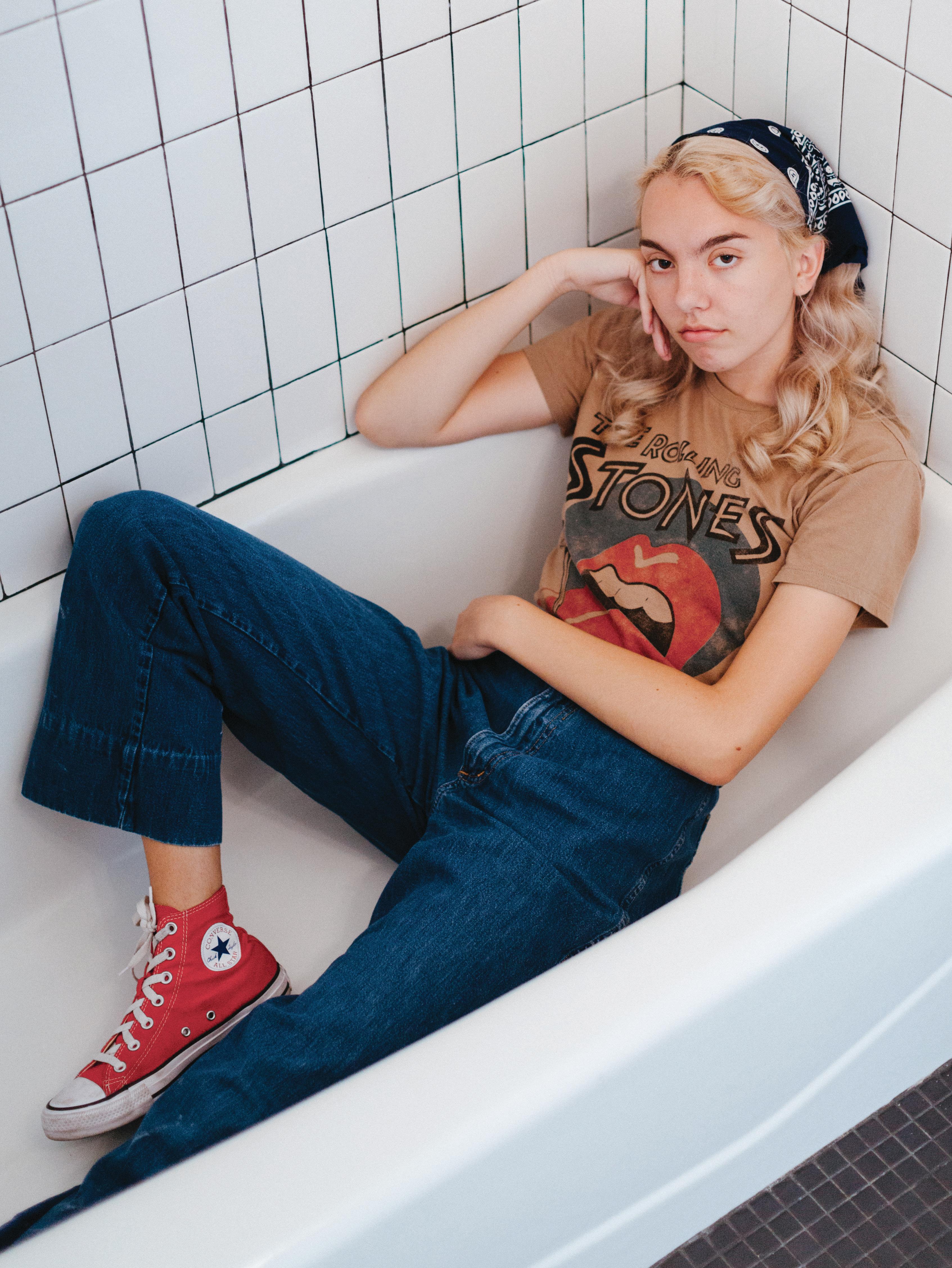 Written by Katie Shiver
Written by Katie Shiver
27
Photography by Arabela Espinoza Instagram kyleeddougherty

Hide in the Bath Profiles 13.4 28

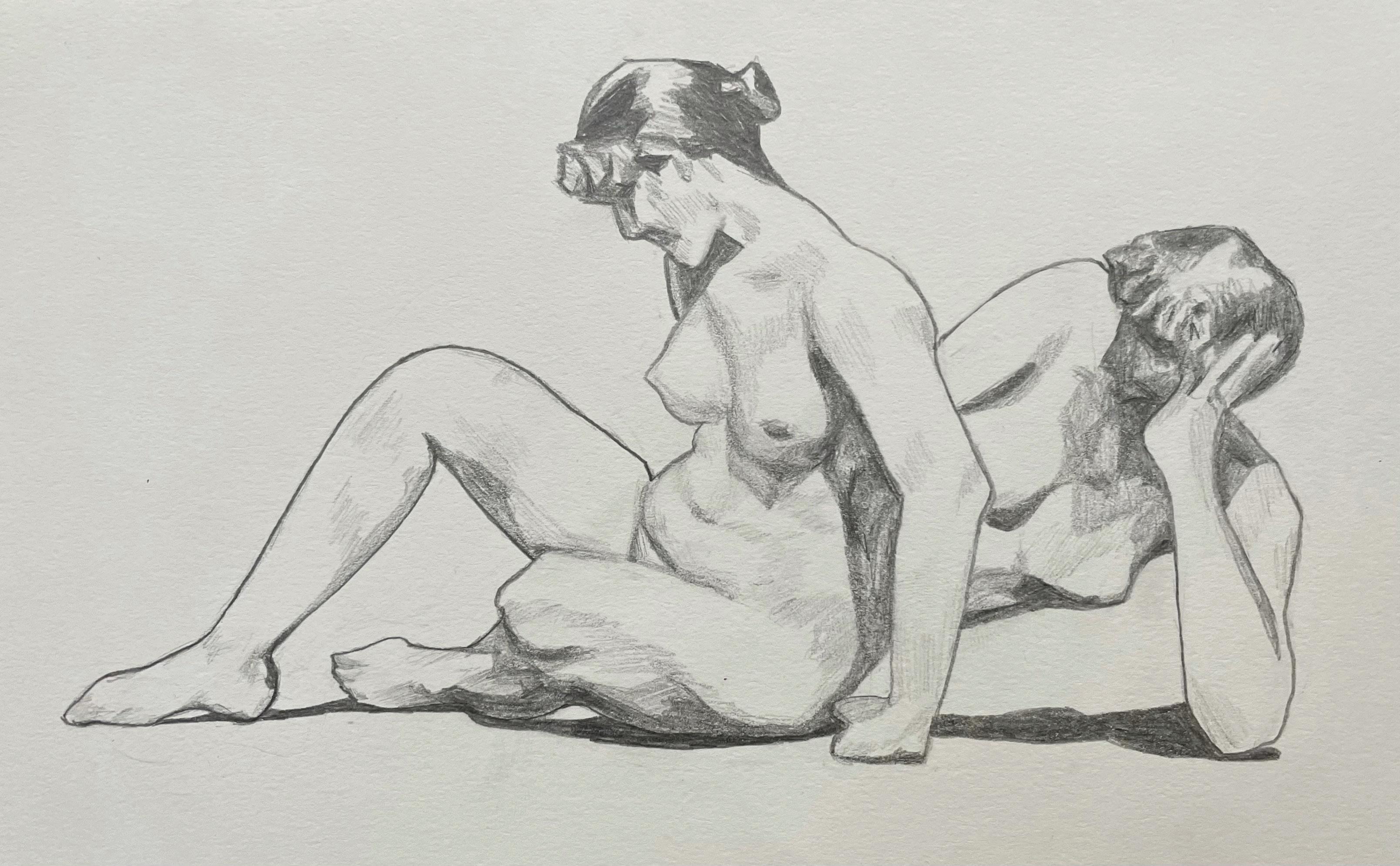
Post-Romance (man) Post-Romance (woman) 29


Myself (within myself) Within Myself (without myself) Profiles 13.4 30
Without
You Will Always Be There,” an idea that translates to her as “I’m the source of all my problems.” She said that it was the first time she’s worked with a concept and that it finally felt like she had something to say in her art thanks to the introspection that COVID19’s isolation forced.
This eight-piece show was a self-portrait with four inverse pairs of repeating images. Each pair represented a different fear, and the two inverse sets of images represented two states of being: two potential paths and answers to each fear. One fear of moving is about losing connections, especially to her younger brother— she’ll go from seeing him every day to living over two thousand miles away. She represented this with images of their two hands coming closer together, and, on the inverse section, of their hands drifting apart.

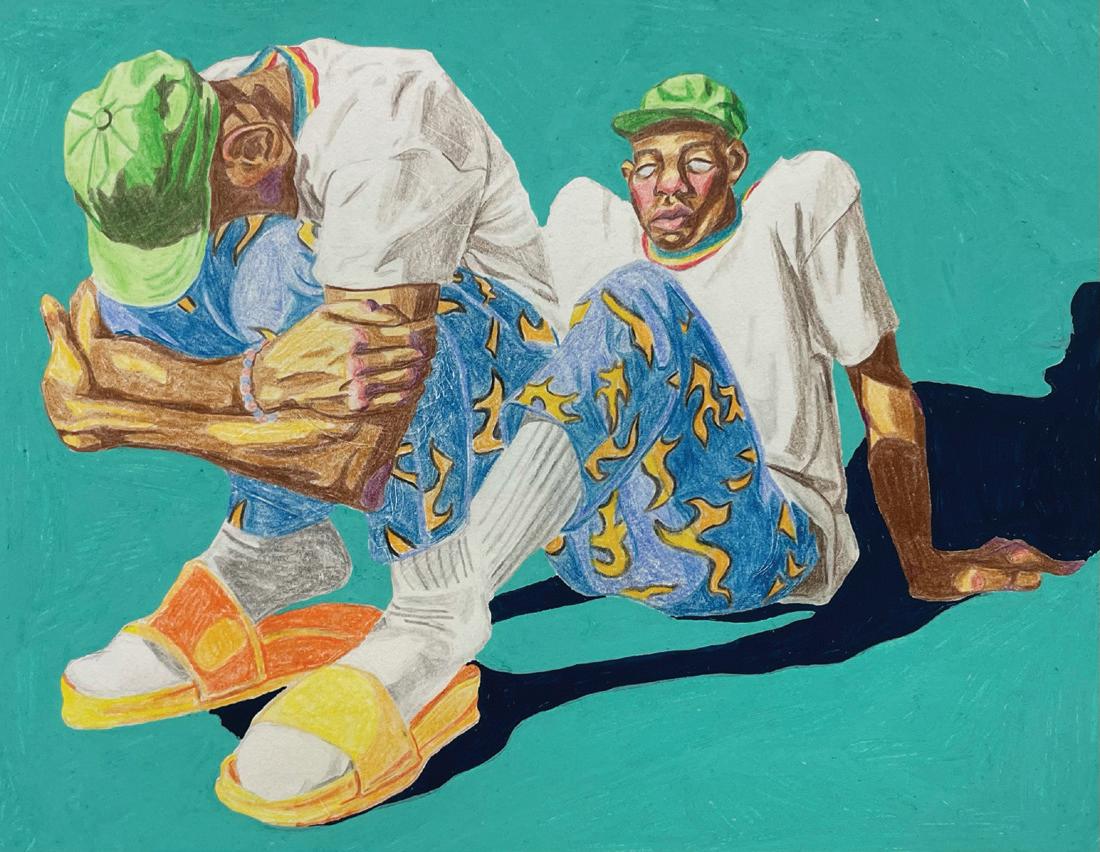
Another fear Kylee has is of how she’ll cope. She pondered through her brushstrokes: am I moving to solve my problems? For this image pair, one side—a repeating face whose expression does not change in front of a changing background—represented the option to continually be moving to deal with her problems. The other side—a repeating face with a changing expression while the background stays the same—represented staying in one place and dealing with her problems.
What does Kylee want to do next with her art? “I just want to keep doing it,” she says. She’s afraid of making art her career, because she doesn’t want to put pressure on her art. “I’d be happy if I just make [art] for me, and humbly work as a server” to pay the bills C
Tyler, the Creator
31
Within & Without pt II
“I’m really coming to terms with what it [means] to be a fine artist—and trying to strike a fine balance between the reality of being a fine artist and the ideal of being a fine artist.”

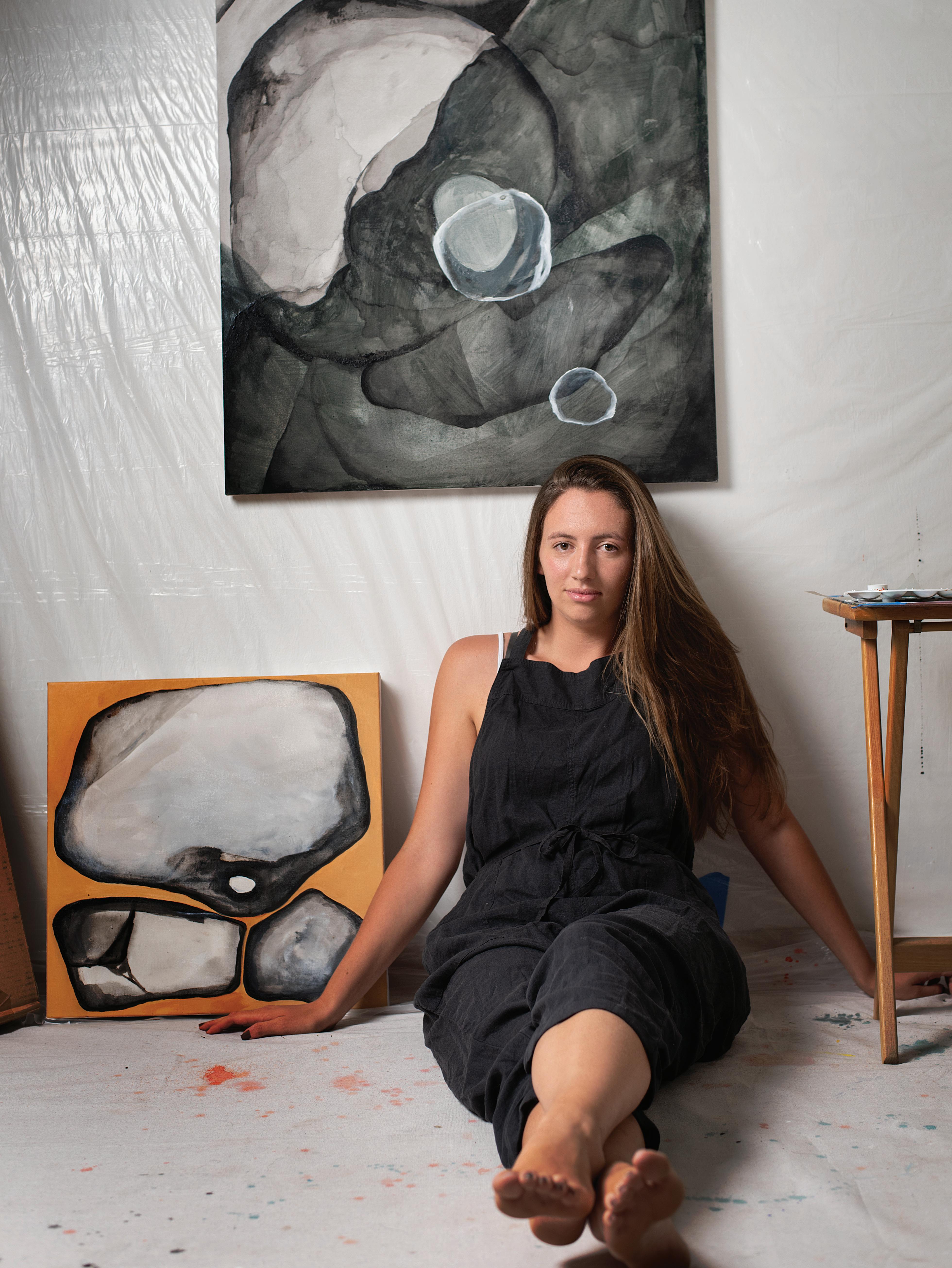
Profiles 13.4
32
–Warren Chang
Written by Johanna Harlow
Photography by Daniel Garcia warrenchang.com Instagram warrenuchang
Warren Chang
What makes art “contemporary”? Is it a unique approach to covering the canvas? Or is it more about the dialogue a piece inspires in our present age? For Korean-American painter Warren Chang, it’s the latter. Though the neoclassical techniques and earthy colors of Chang’s oil paintings evoke the gravitas of the Old Masters, this artist’s autobiographical focus steers him clear of Baroque-era depictions of courtiers and merchants.
A painting of a bearded homeless man, for example—his Coke and cigarette likely all he’ll have for lunch today—isn’t exactly a narrative covered by Vermeer or Velázquez. But the Monterey-based artist’s honest portrayals of the modern experience are deeply and insistently human. Take the disheveled drifter of Chang’s Hard Times: Portrait of Bill. If you brushed by this man, in the flesh on the street or through the paint of the portrait, he would remain faceless. It takes that second look to locate his sad eyes, shadowed beneath the bill of his weather-worn hat.
It’s an undercurrent that weaves its way through many of Chang’s pieces. Take his farmworker paintings, which make visible the often-overlooked fieldworkers laboring across Monterey County farms near the artist’s home. Chang featured a number of these rural renderings in a 2019 exhibit at the New Museum of Los Gatos entitled Voice of the Fields, and then again this year in his Social Realism in California exhibit at the Triton Museum of Art—this time alongside depictions of drifters and Black Lives Matter protesters.
There’s a sincerity to Chang’s dedication to painting the truth. “When I’m painting something that exists in my own life, something that I know because I’m living it, I’m being very honest and truthful about the subject matter,” he explains. Perhaps unsurprisingly, he has found inspiration cracking the spines of Steinbeck’s novels. The Monterey author, like the artist, was not one for pulling punches. Instead, he waded right into the lives of the region’s underprivileged.
Chang is also open about his choice to become a full-time artist after growing disenchanted with working as a commercial illustrator, back when he designed paperback book covers in New York. “As an illustrator, I was pretty much a journeyman,” he shares. “I was not used to selecting my own subjects because if somebody wanted me to paint a Roman market scene, that’s what I would paint. If someone wanted me to paint an ad for Davidson whiskey, that’s what I would paint. If someone wanted me to paint a romance couple for their book cover, that’s what I would paint.” He
-
Candor on Canvas
33


Profiles 13.4
Checkers, 34 x 40 inches, oil on canvas, 2014
34
2020, 26 x 30 inches, oil on canvas, 2021


Essential Worker 32 x 24 inches, oil on canvas, 2020
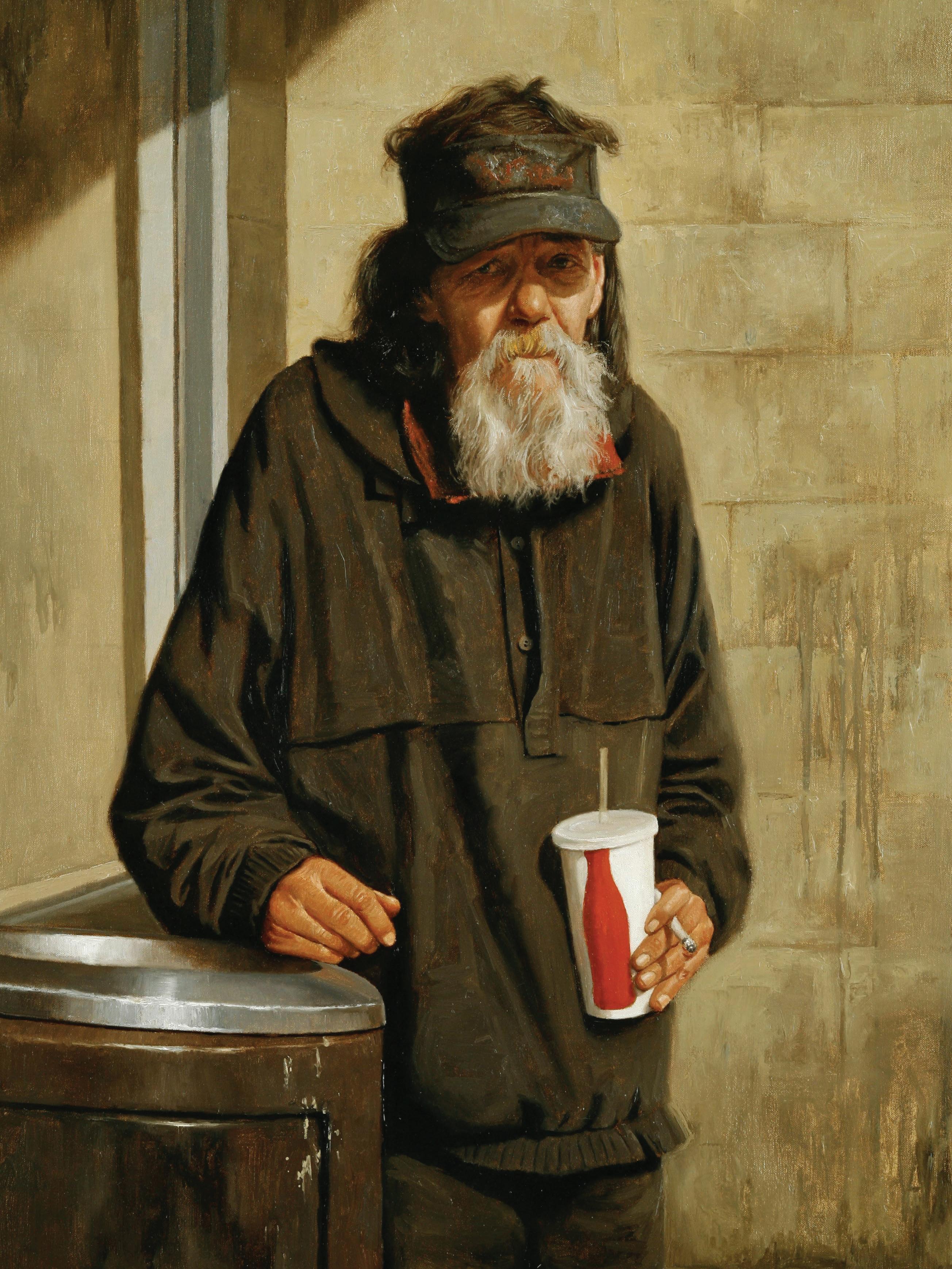
Hard Times, 36 x 24 inches, oil on canvas, 2010
takes a moment to consider his next words before saying, “I never had to think. Someone else was essentially doing the thinking for me, and I just painted for them.” As the paperback book market gravitated toward digital and photographic art in the late 1990s and Chang’s associates began familiarizing themselves with Photoshop, he knew he would need to make a change if he wanted to continue painting. “It’s common for illustrators to transition to fine art. That’s not such an unusual story,” Chang admits. But by no means did that make his vocational leap any less daring—especially with a wife and a baby to provide for. “It was such a huge change to do that. Financially, it was also a huge change. In 2002, I was so poor. I mean, I don’t know how we lived. I don’t know how we survived.”
To make ends meet, Chang turned to teaching. He continues to teach art classes to this day and finds he takes away even more from his sessions than his students do. “When you’re teaching, you’re forced to verbalize all your concepts…you’ve got to be able to communicate exactly how it is that you painted that,” he explains. “You’re reinforcing to yourself how to paint. It’s basically proving to yourself that your methods are sound.”
Today, Chang’s narrative paintings have gained him several solo exhibitions with art museums and earned him representation by Carmel’s Winfield Gallery. Among some of his most popular work with art collectors and museum curators are his farmworker pieces. To stand in front of these paintings and truly take them in is to recognize these workers in their toil—it is to acknowledge the humanity and experience of the “downtrodden and disenfranchised.” You feel the midday heat
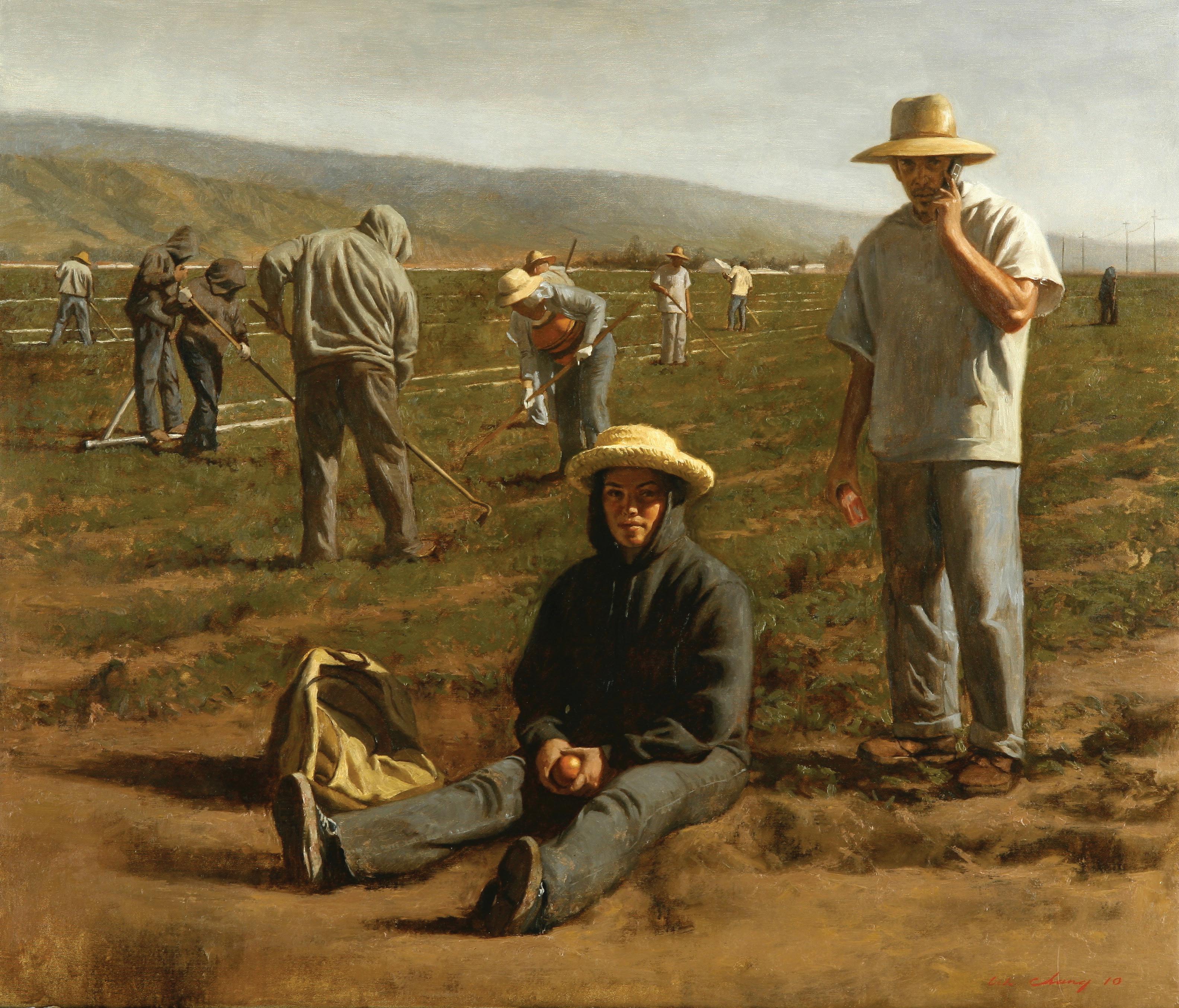
through the stark sunlight and shade-less stretches of dry dirt. You become more mindful of the aching hands, bent backs, and dusty bodies your vegetables required before they arrived in clean, straight rows on your grocery store’s produce displays.
For a glimpse into Chang’s personal life, you’ll also want to explore his interior paintings. Finding the “artist’s environment to be rich in character,” the painter depicts his home and his studio, his wife and his son, his students and his models. With that trademark candor, Chang admits he sometimes wonders if people connect to these private scenes. However, “unusual as it is to see a family portrait painting of myself as an Asian-American painting in my studio with my wife (who is from New Hampshire)…the fact is, it’s me,” he concludes. “This is the life of a real American artist. And whether you can relate to it or not, it’s the honest-to-God truth.”
There’s an old documentary called “Artist in Transition,” which features Chang not long after his departure from the world of illustration. As he voices his hopes for the future, the 2002 Chang— his eyes still young, his salt-and-pepper hair still more pepper than salt—reveals the freshness and uncertainty of this new chapter. “I’m really coming to terms with what it [means] to be a fine artist—and trying to strike a fine balance between the reality of being a fine artist and the ideal of being a fine artist,” he shares. “Or what I want to do and what the world will allow me to do.” He has no idea the places his paintings will take him, nor of the museums and galleries and collectors waiting to embrace him. But his dedication and compassion for the human condition, in all its grit and glory, will pave for him an unforgettable journey. C
37
Fall Tilling, 34 x 40 inches, oil on canvas, 2010

Profiles 13.4
Conspiracy
Low
Written by Johanna Harlow
lowconspiracycc Facebook lowconspiracy.carclub Car Club 38
Photography
by James Garcia Instagram
East San Jose was arguably the hub of the lowrider golden age during the late ’70s and through the ’80s.
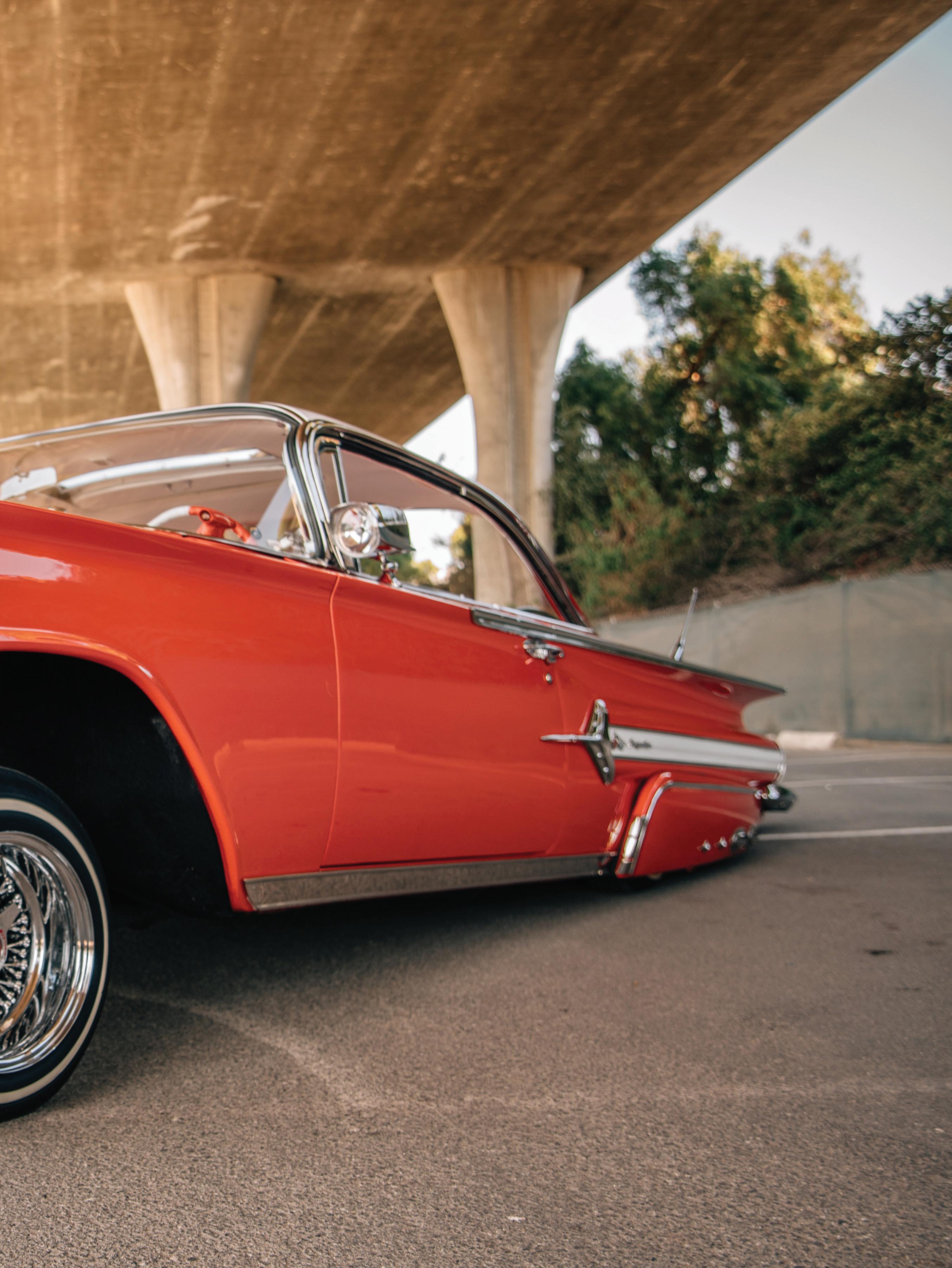
39
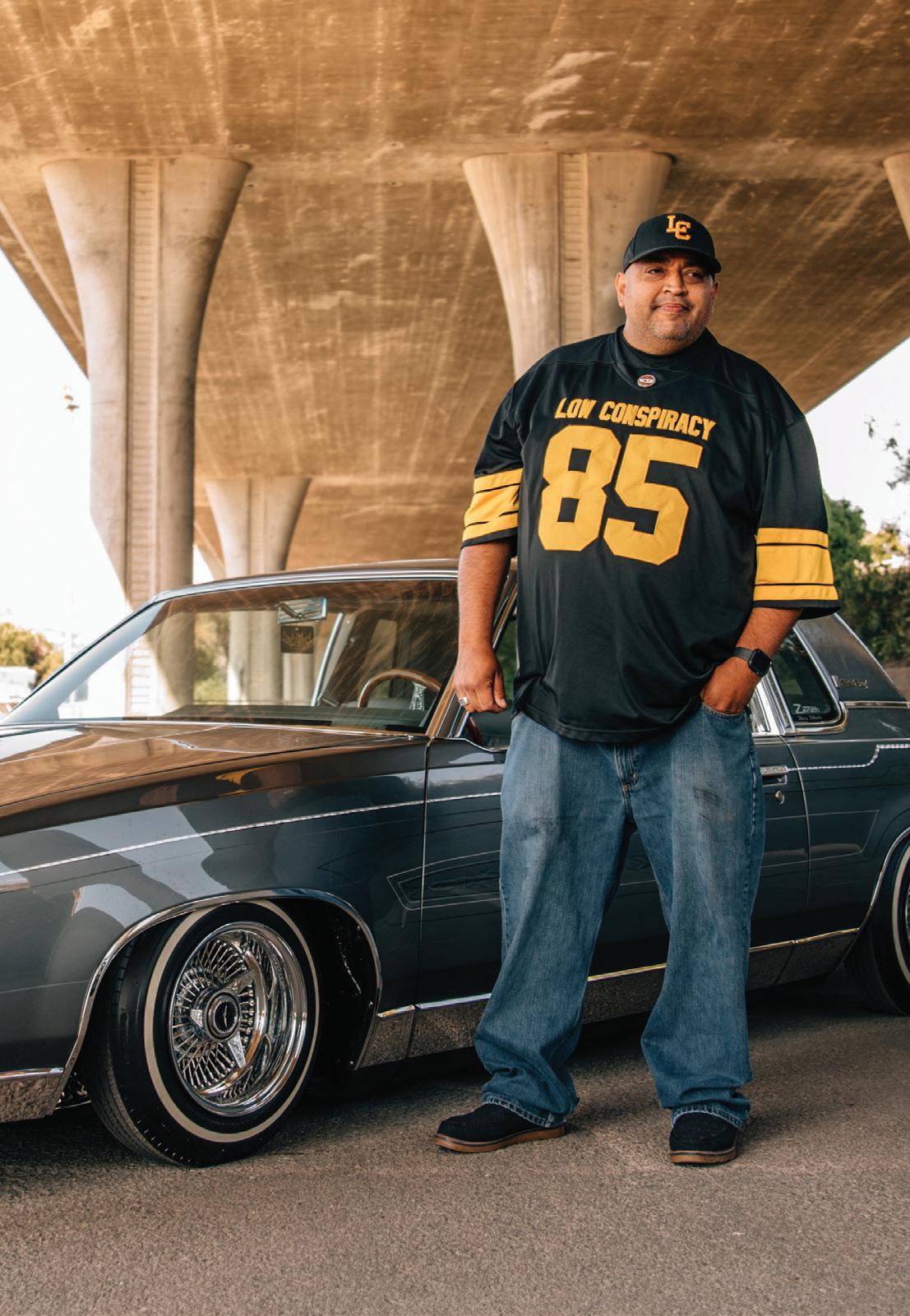
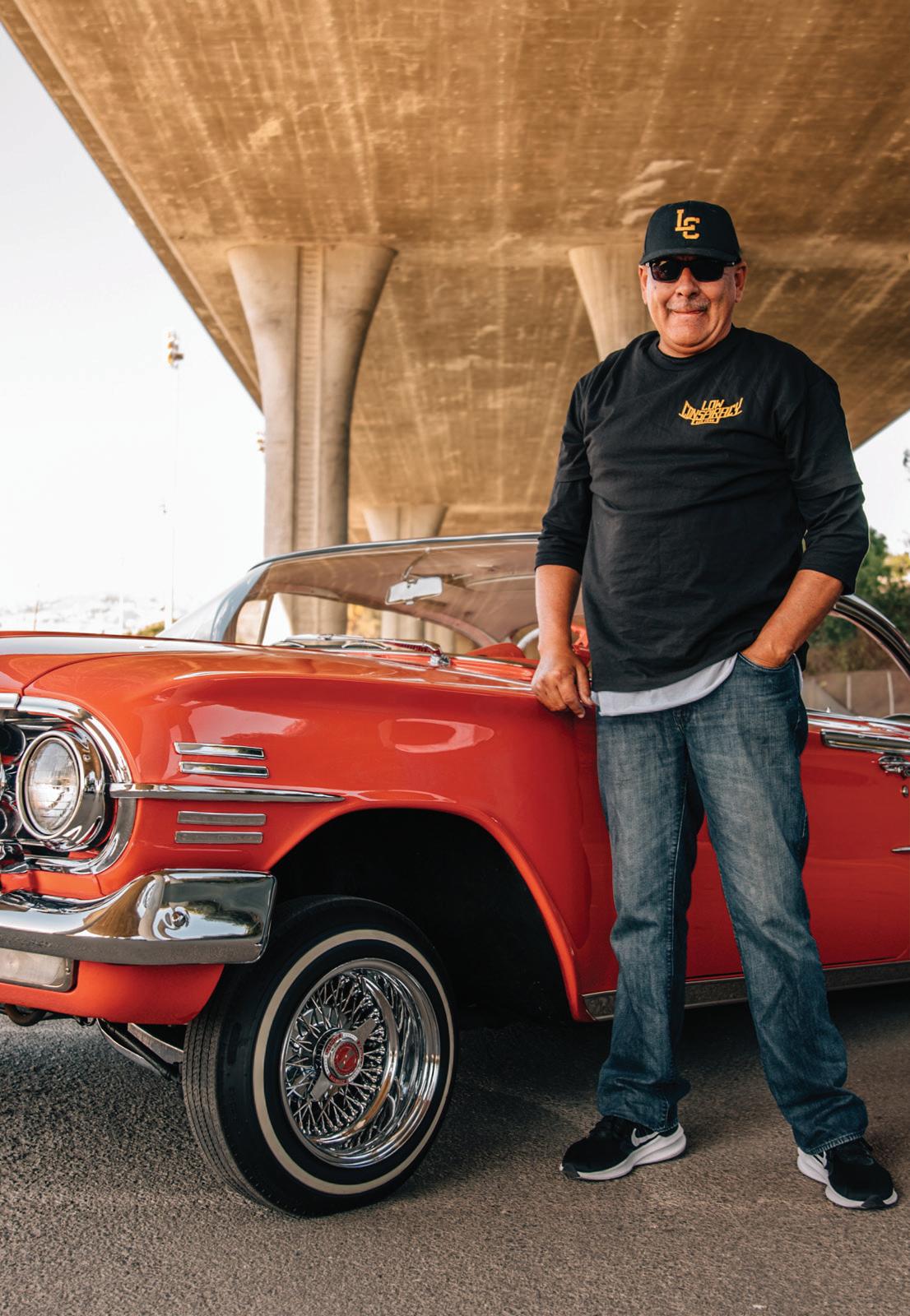
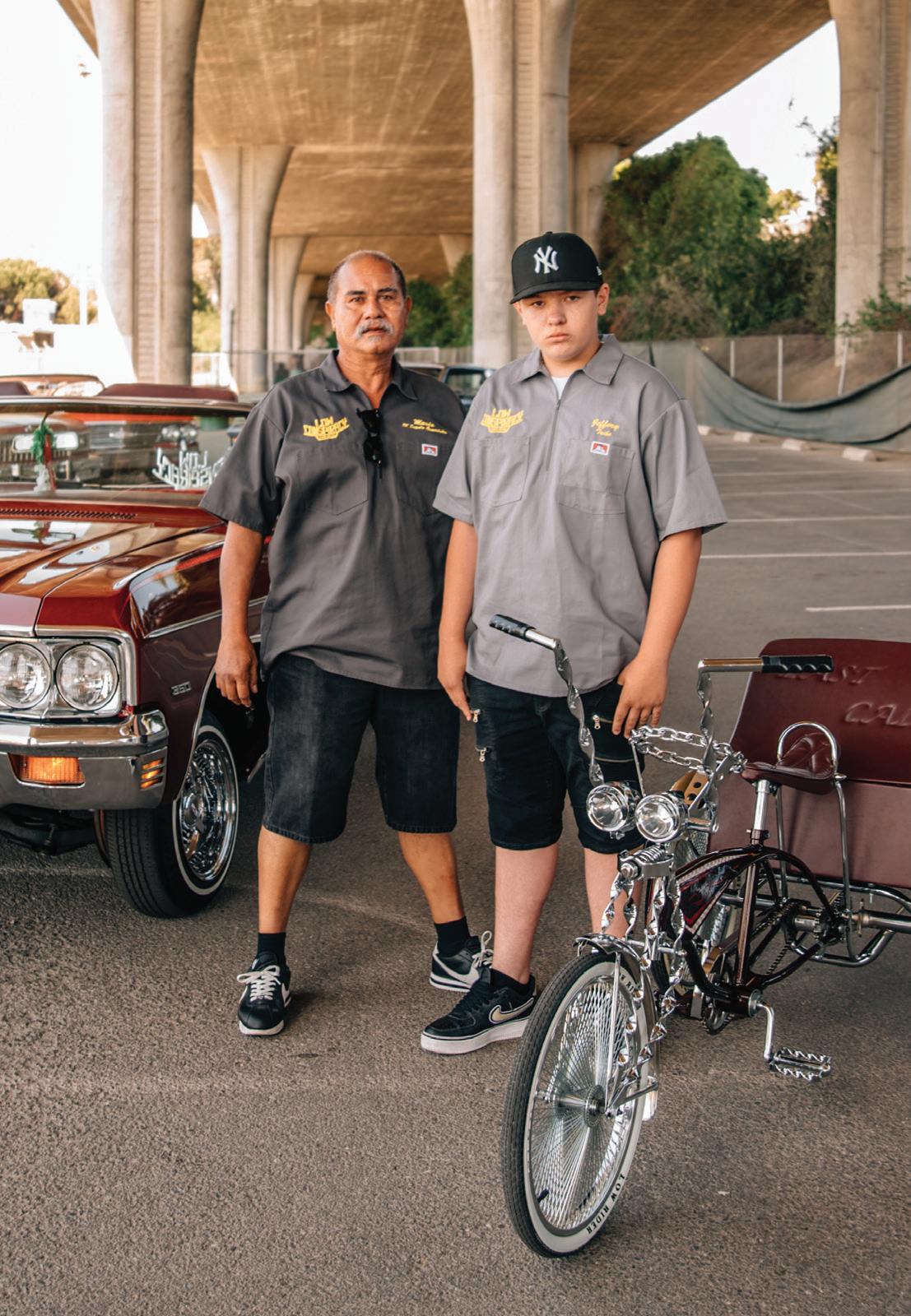

40 Profiles 13.4
Clockwise: David Lopez 1985 Cutlass; John John Ponce 1960 Impala; Mario & Jeff Navarro 1970 Impala; Robert & Yvonne Diaz 1962 Impala
It’s one of those slow afternoons, and a few lowriders from the Low Conspiracy Car Club have gathered at the garage of current head Sergio Martinez. Surrounded by vintage car prints, show trophies, and shelf upon shelf of model cars, members reminisce over slices of pizza on the organization’s 40-plus years of history.
These memories are bittersweet, reflections trigged by the recent loss of José “All Nighter” Martinez, president during the club’s first decade, and later in life, a regular judge in Lowrider Magazine ’s car shows. Last week, the club honored him with a memorial cruise down Santa Clara Street. Now, as they pass around old photos and magazine clippings, a few of the older auto aficionados reflect on the club’s deep impact on their lives.
“It starts out as a hobby and turns into a lifestyle,” muses Abel Hernandez (a retired member of the club, but one of the 10 original high schoolers who first brought it to life back in the ’70s). Sergio smiles his agreement, the Impala symbol tattooed on his arm proof to his friend’s statement. That same mindset holds true across the club. It’s evidenced in the matter-of-fact way club members can rattle off the painters and modifiers behind their cars with the level of pride art collectors reserve for listing the masters framed on their walls.
There’s no argument that these cars are drivable art. “You’re not going to take a family vacation with those,” Abel comments with a chuckle. Sergio nods, “I kinda made mine a trailer queen and chromed everything.” If you’ve witnessed members’ painstaking attention to detail, you’ll understand why. For starters, there’s the handmade Zenith wire wheels with plated spokes in chrome and gold. There’s the big-bodied builds (practically with a couch in the backseat). There’s the hydraulic suspension (some with the power to raise up on three wheels or jump). Occasionally, there’s hidden murals tucked inside the door jams (ready to flash whenever the driver enters or exits the vehicle).
And of course, don’t forget the wild paint jobs—a factor which happened to be José’s specialty. “Anybody can paint,” José’s wife Lisa Martinez says. “But you have to be an artist for it to really come out. They used to call them rolling canvases.” It’s not an exaggeration. If you want to win a car show, you play for keeps. Flashy flourishes of sparkles, patterns, and pin-striping get you on the podium. Or as Lisa puts it, “Go big or go home…Make it so that when it drives down the street, it gives people a headache it’s so bright.”
At times, lowrider painters have been
known to take a little creative license. “Sometimes you tell them what you want, and they know that’s not going to look good,” Sergio explains, gesturing at his ’78 Grand Prix’s sunset-style two-tone fade from tangerine to scarlet, a coat accented with crisp yellow pinstripes. “I didn’t want orange on there—but he put it on there. When he told me, I wasn’t happy. And then I saw it…and I went back to him and said ‘Put more on.’ ”
“Carlos [Lima] did that to me, too, with my truck,” Sergio adds. “I wanted different colored flames—and he put a kind of magenta. And first thing I thought was ‘Pink. You painted pink flames on my truck?!’ But every truck show I went to with that truck, I won best flames.”
Judges not only look at the paint but scrutinize all the hidden little details, Sergio explains, describing the spotlights and turntables used to reveal every last facet and angle. And for rides with engraved undercarriages, you better believe their owners bring out the mirrors to capture those beautiful underbellies.
Fittingly, these cars with their loud personalities have an equally memorable origin story. It all started with young Chicano lowriders in post-World War II Los Angeles.
Tired of whitewashed cultural norms in
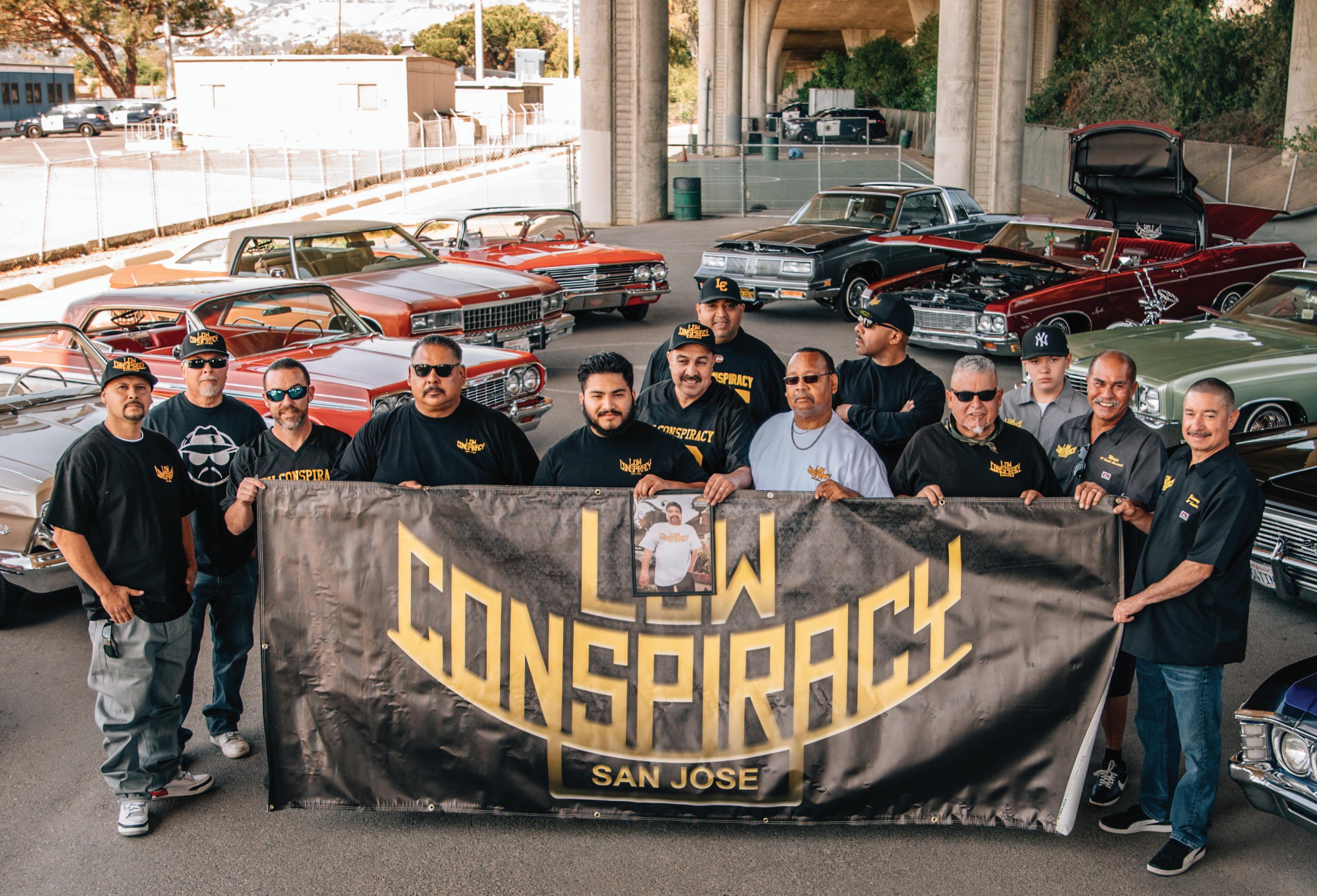
“It starts out as a hobby and turns into a lifestyle.”
41
Low Conspiracy Members
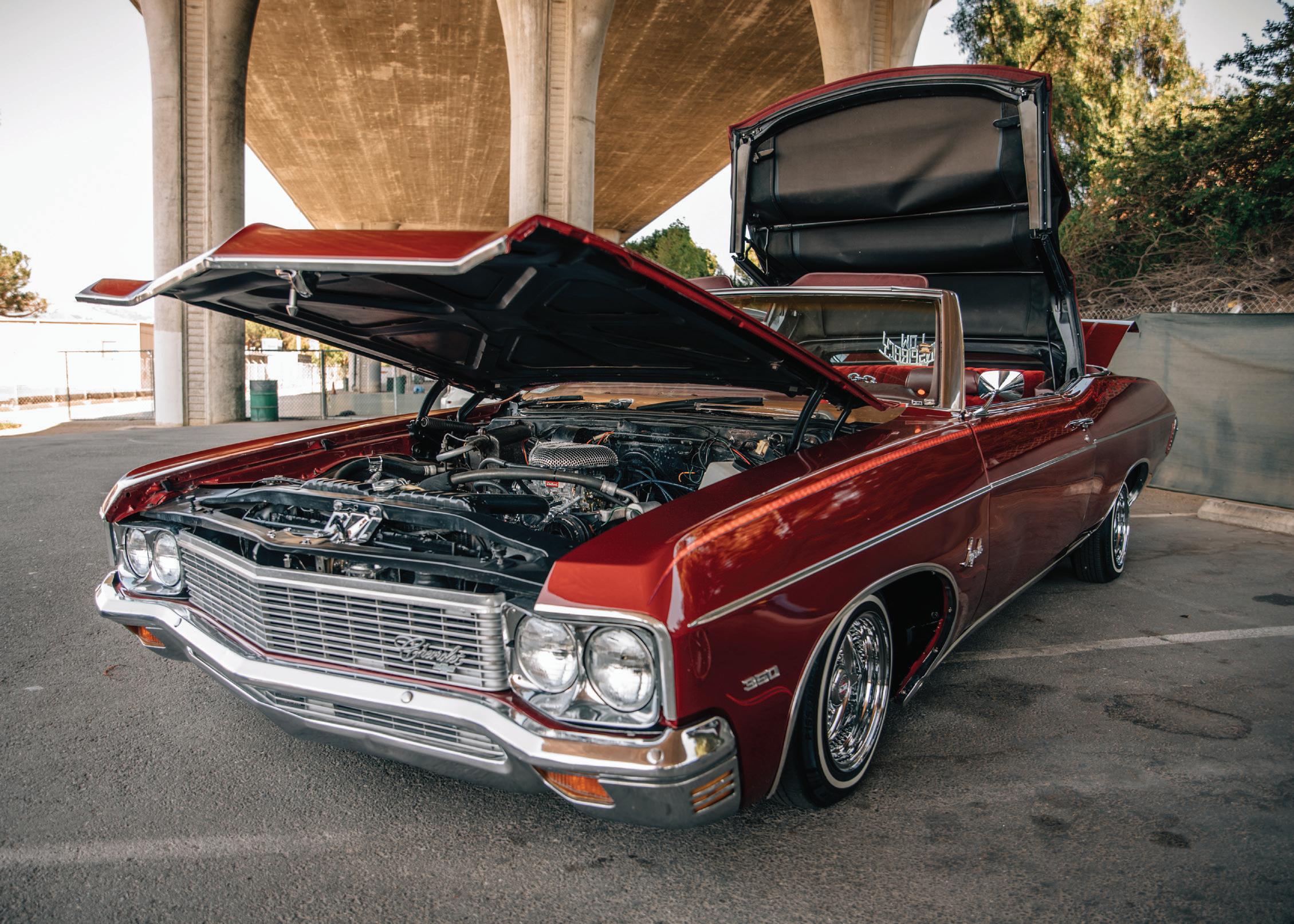
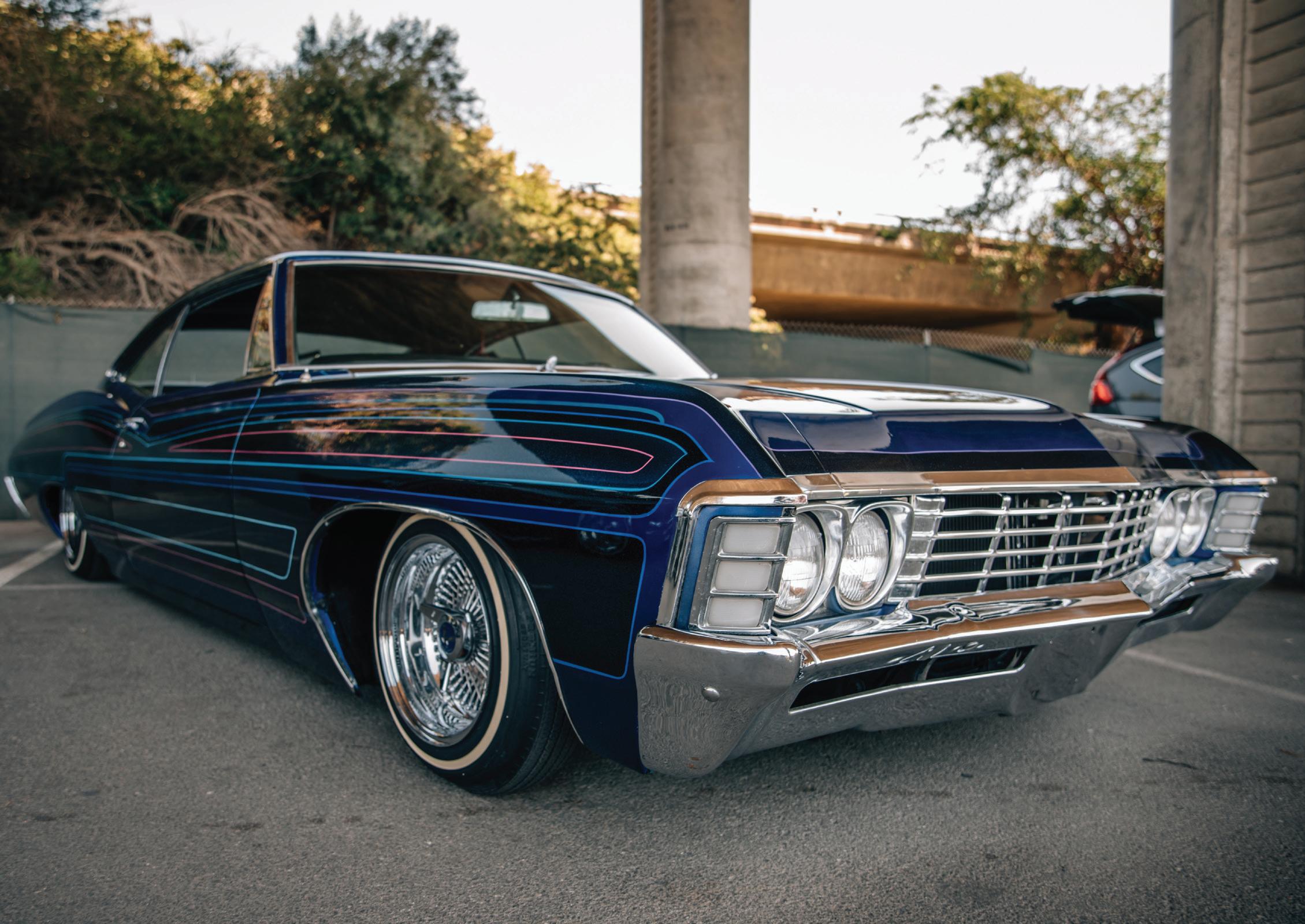
Profiles 13.4 42
Top: Jimmy Gonzales 1967 Impala; Bottom: Mario Navarro 1970 Impala




43
Clockwise: Mariano Alvarado 1966 Impala; Jimmy Gonzales 1967 Impala; Sergio Martinez 1978 Grand Prix; Ryan Gomez 1972 Monte Carlo
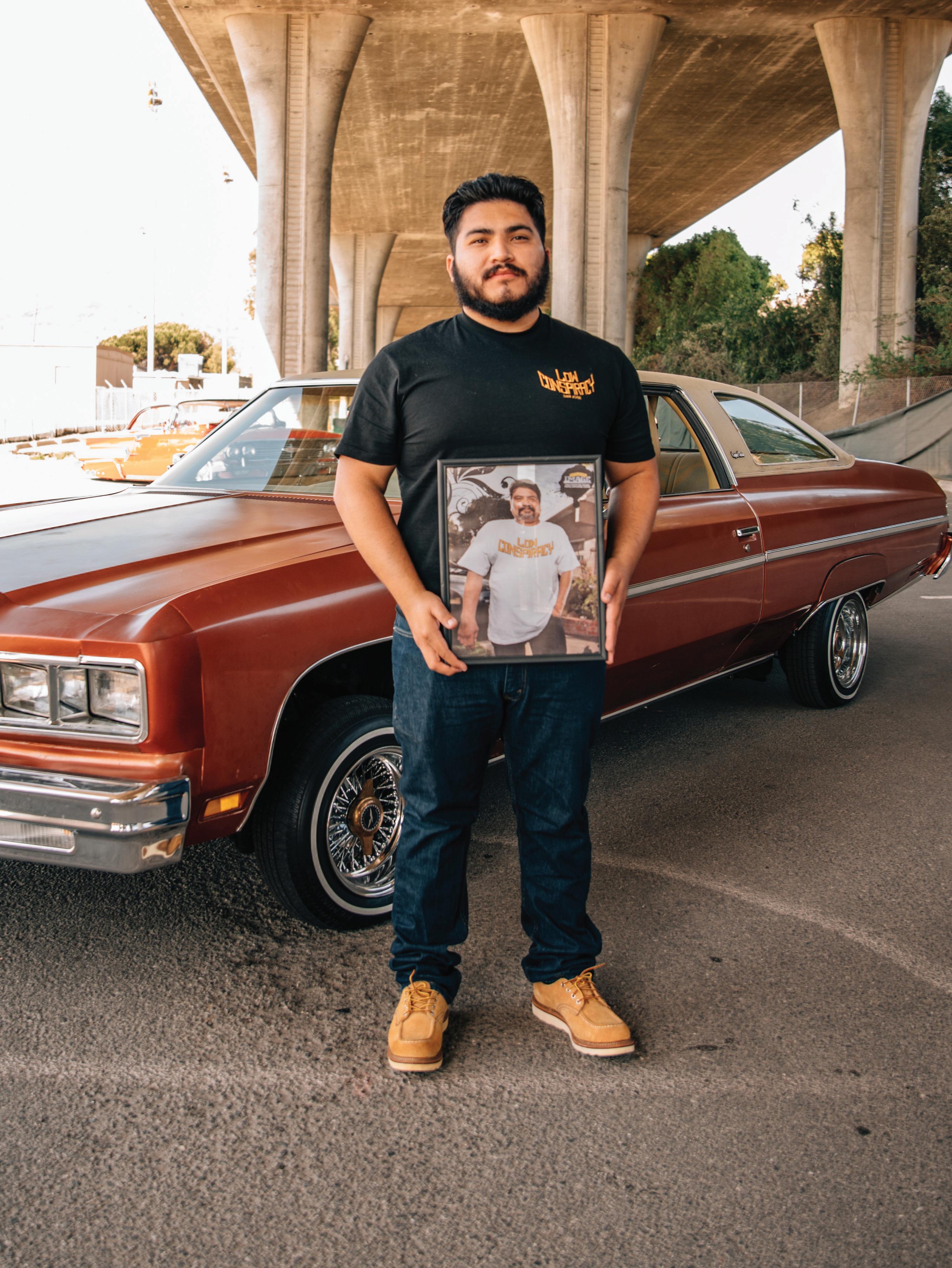
Profiles 13.4 44
Jose Martinez Jr. 1975 Impala holding photo of his father the late Jose “All Nighter” Martinez, co-founder and president of Low Conspiracy
the States, Mexican Americans expressed pride in their heritage with their own counterculture. So, in response to the nation’s obsession with speedy hot rods and raised trucks, Chicanos embodied their new motto, “Low and Slow,” by cutting coils, lowering blocks, and even adding sandbags or bricks to their trunks.
Unfortunately, apprehension of minorities ran rampant in the ’50s and the media stoked irrational fears of gangster ties. The result was police harassment as well as a 1958 California law that banned lowered cars. Rather than conform, lowriders met this with a cheeky response: hydraulics. Repurposing aircraft landing gear, they could now elevate their ride height to “appropriate levels” at the flip of a switch.
East San Jose was arguably the hub of the lowrider golden age during the late ’70s and through the ’80s, despite its LA roots—a period Abel refers to as the “King and Story Days.” From Friday to Sunday, Low Conspiracy (which was 80-members strong at its peak) cruised the boulevard with dozens of other clubs late into the night. Thousands of car enthusiasts milled around on the sidewalks and daydreamed themselves into many a driver’s seat.
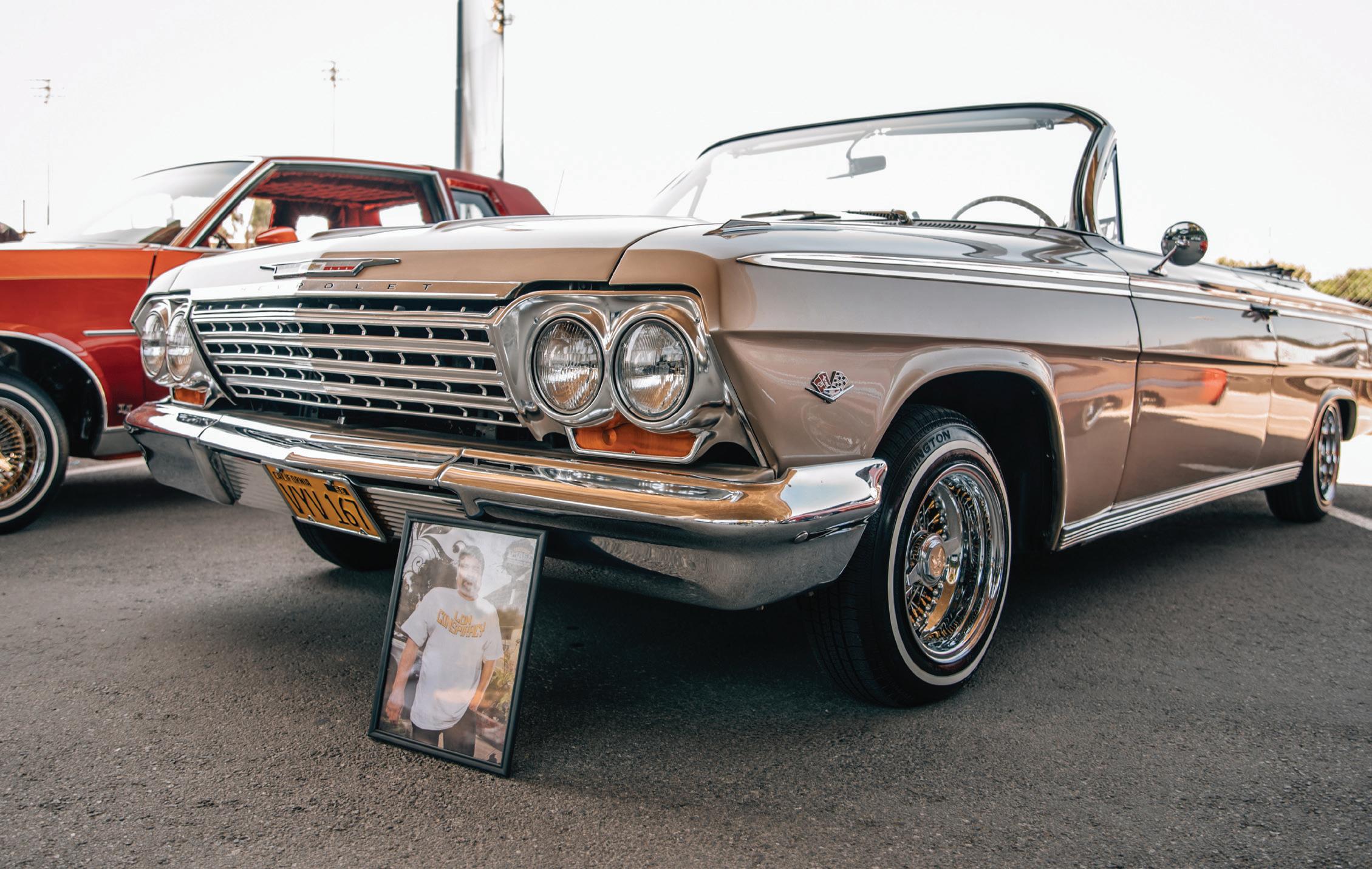
Cruising acted as a night club on wheels, as much a social staple of the time as spending your nights at the roller rink or the bowling alley. “Once you saw another car flying your plaque [in the rear windshield] you would follow him. Before you knew it, you had a dozen club members cruising together,” Sergio explained in an interview with Lowrider Network. “That
was how we met up back when no one had cell phones.”
It was the place to see and be seen. Drivers would showboat by hitting their hydraulics. They’d roll down the windows and blast Latin rock. “Good days when we were out there, huh?” Lisa says to the friend sitting beside her. “That’s when we were young. The guys were out there with their beautiful cars—looking at the girls— who were looking at the guys.”
Unfortunately, the assumption that lowriding and gangsters were somehow linked was still being made by public and police. “They always thought we were up to no good,” Abel recalls. Sergio nods in agreement, “They started fining people, and they were going after the nicest cars because they’re the ones that stood out.”
José, however, was determined to overcome that stigma. “He would approach the chief of police and say, ‘Yo, this is an event we want to do,’ ” Lisa recalls. “He didn’t want them to be hassled.” José and the club also collaborated with local firefighters on toy drives. The message was clear: we’re not here to cause trouble. “You have to give back to your community and show that you’re part of the community,” Lisa states. “You’re not the problem.” These gestures earned them respect among law enforcement.
“Some people are scared of [lowriders], but, nah, it’s all families nowadays,” Sergio verifies. “I’ve been doing it my whole life. I’m older and I got a couple of little grandkids too…the whole family gets into it!” In fact, on more than one occasion, the club has chauffeured young ladies and
their quinceañera courts to party venues. “They get a kick out of it,” Abel smiles.
At the end of the day, the club is one big family. Again and again, the Low Conspiracy guys refer to the special brotherly bond shared by members. “When I first started going with them, we happened to park all of the Martinez’s together, just coincidentally,” Sergio recalls, “and somebody noticed and said, ‘Hey, are you guys all brothers?’ And José pops up right away. ‘Oh yeah, we’re all brothers.’ ”
“And he loved being the big brother,” Lisa shares. “He was always referring to Abel as ‘my little brother.’ With everybody. Even the younger guys that were starting, he’d say ‘Oh that’s my son.’ And people thought he had all these kids!” She chuckles at that. Though José retired from the club for a time, it was Lisa who encouraged him to rejoin a few years at the end of his life.
As the group returns to the present from this trip down memory lane, conversation steers toward the upcoming car show at History Park. It’s going to be in July, just in time for the club’s 45th anniversary and will reward a scholarship to a kid who wants to go into auto painting (in memory of José, of course).
Sergio sits back and watches his friends refill their plates with pizza. He gives a contented glance around at his patch of paradise, brightened with tools and trophies. “I’ll be in the club forever,” he declares. “You’ve seen my garage. I’m not going nowhere.” C
45
Yvonne Diaz 1962 Impala


Profiles 13.4 46
Written by Michelle Runde
Photography by Peter Salcido
Artist Dominique Renteria Model Azita Bakhshi
aulala.design.com Instagram aulaladesign
Au La La Design
Born in San Jose. Handmade in Vietnam. Sold at Westfield Valley Fair.
When going to the mall for a new dress, you could spend hours combing through the racks of large retailers with seemingly endless inventory, and still leave without the right fit. But if you’re seeking something that blends modern chic with timeless style, look no further than Au La La Design located in Santa Clara’s Westfield Valley Fair shopping mall. A small, family-owned boutique, Au La La is proudly based and sourced in Vietnam, specializing in petite proportions. Owner and founder Au Nguyen took her personal passion for well-fitted and affordable clothes and turned it into a burgeoning business, translating the craftsmanship and quality of Vietnamese clothing into Bay Area style.
Au was born in Vietnam but moved at young age to Ha-
waii, where she lived until relocating to San Jose. In 2016, she returned to Vietnam for the first time since leaving and was inspired by the clothing and style. “Vietnam is known for great tailorship and also craftsmanship at affordable prices,” explained Au. “So I fell in love with that and the people there.” While visiting, she worked with local tailors and seamstresses to help build out her personal wardrobe. “I was doing custom pieces for myself because being [in San Jose], it was hard for me to find a dress that fit me properly because I’m pretty short,” said Au. She returned to the United States with a beautiful wardrobe, strong relationships with her favorite seamstresses, and an idea for a business.
Au opened her first brick and mortar store in July 2020 on San Pedro Street, selling
handmade dresses from Vietnam. This was made possible thanks to MOMENT, a program powered by SJMade to incubate small local businesses by subsidizing rent in booths outside of San Pedro Square. “I wasn’t concerned with my numbers or sales,” said Au. “It was more getting people in, trying on the clothes, how do they fit, is there a space for my brand, how can I change and revise to make it better.”
Working closely with her small team in Vietnam, Au began to understand some of the unique design challenges she would face in the United States market. “We started a real line, but we didn’t know our sizing very well because in Asia, sizing is limited to three sizes,” Au explained. “I know petite sizing well, and so we started a line with twenty pieces but only
Makeup
47




“I’m still learning from my customers what they want from me. They give me a lot of requests, and I actually put those requests back into our line.”
Profiles 13.4 48
–Au Nguyen
two sizes. Then we tested out a few pieces…Looking back now, my large [was] like a medium.” After many iterations, Au was able to offer more sizes, and her team began to better understand how to tailor for a variety of body shapes and sizes.
Although business was challenging with COVID-19, Au gained a loyal following. “I had a lot of regulars who were very supportive of our brand,” Au recalled. “[I]t’s a nonessential thing, you don’t have to shop or buy clothes with us, but they were actively supporting me and the small businesses around us. So we did really well considering the pandemic.”
In early 2021, Au found a leasing agent who helped her secure a permanent location in Westfield Valley Fair. Since opening in mid-March, Au has
seen an increase in both sales and feedback. “I’m still learning from my customers what they want from me. They give me a lot of requests, and I actually put those requests back into our line,” said Au. “So a lot of our customers would want pockets in dresses, and we try to do that in every dress that we possibly can. A lot of people want more adjustments in the bust area, and maybe a higher neckline for older demographics. So we listen and we try.”

While Au La La’s core focus is designing for petite frames, Au is constantly iterating to add more size options. “[M]y challenge is to fill that niche that I’m working with, but also be inclusive to everyone,” said Au. “So my challenge is how do I bring in some pieces that are for a taller person or for a curvier
person…So I bring in some separates and loose-fit pieces that are still pretty, but not so form-fitting.” Being in the mall, customers may not realize just how challenging it is to make design changes quickly. “I think people don’t understand our brand…we’re just super small. We’re definitely not a Zara or a Uniqlo, and they don’t understand that when walking into our store. So once they understand where we’re coming from, and that everything is actually handmade, then they are more likely to be understanding and have more patience with us.” For such beautiful designs and quality, there is no doubt Au La La Design will continue to expand as it gains more devoted customers. C
49
West Valley College
FASHION DESIGN AND APPAREL TECHNOLOGY
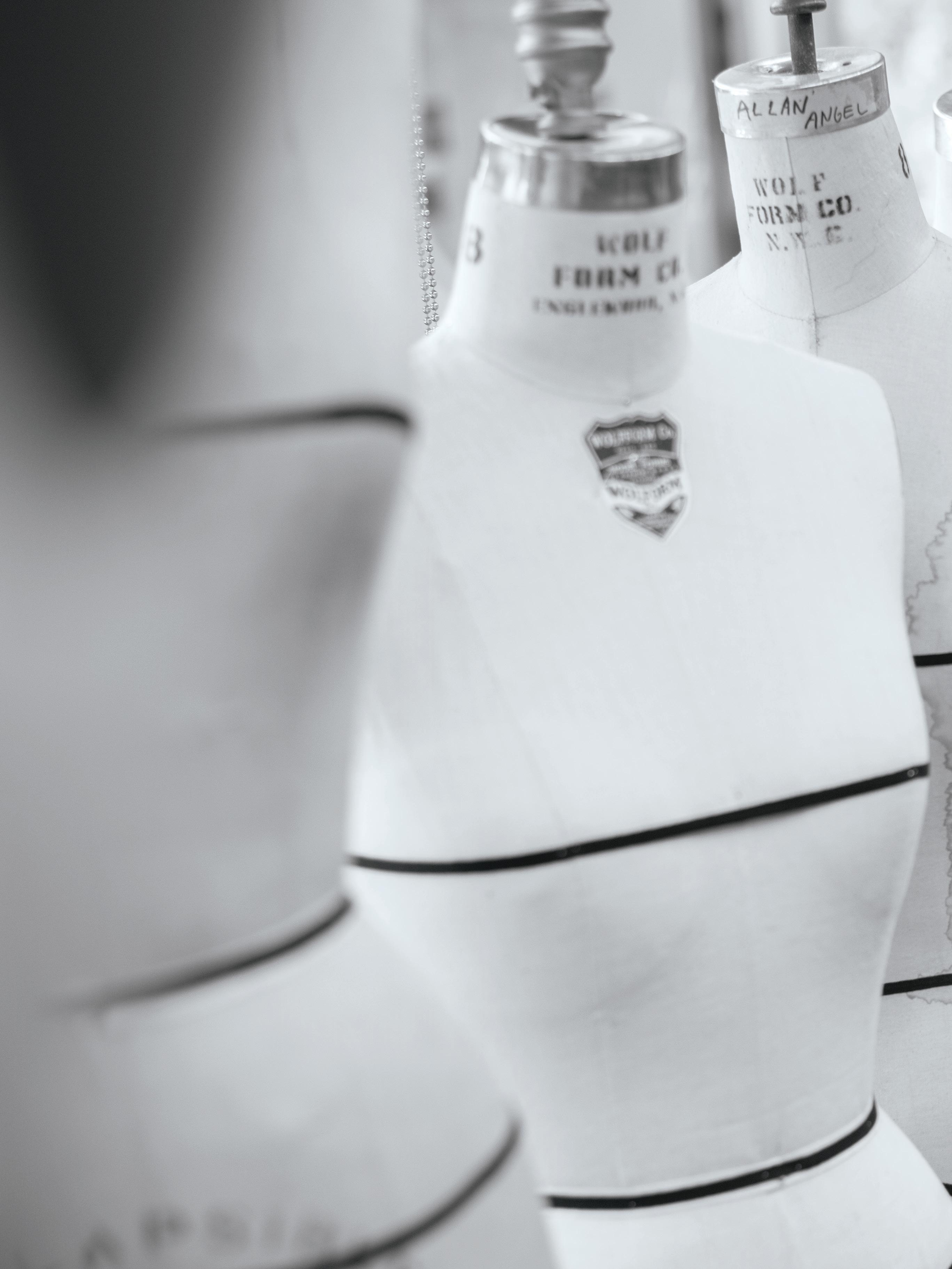 Intro Written by Anya Evfimiou Photography by Daniel Garcia westvalley.edu Instagram westvalleycollege wvcfashion
Intro Written by Anya Evfimiou Photography by Daniel Garcia westvalley.edu Instagram westvalleycollege wvcfashion
Profiles 13.4 50
2021

The Fashion Design and Apparel Technology (FDAT) program at West Valley College was established in 1985 by a group of industry professionals for the students who wish to gain knowledge and experience in the field of fashion. At the end of each year, we celebrate the accomplishments of our graduating students with a fashion show that represents their individual collection. The students showcase their own point of view through the garments they design and execute. The 2021 graduating students faced the challenges of Covid-19 that disrupted their learning when school shut down and the majority of classes moved online. They lost access to technology and equipment usually available to them and the collaborative learning environment was severely restricted.
Teachers and students had to adapt to extreme changes and rethink their learning strategies. Despite personal, emotional, psychological, and physical challenges, these students stayed focused, kept learning, and built their skills. This year’s Virtual Fashion Show on June 4th is the reaffirmation of their passion, dedication, and pure commitment to achieving the dream they choose to follow.
51


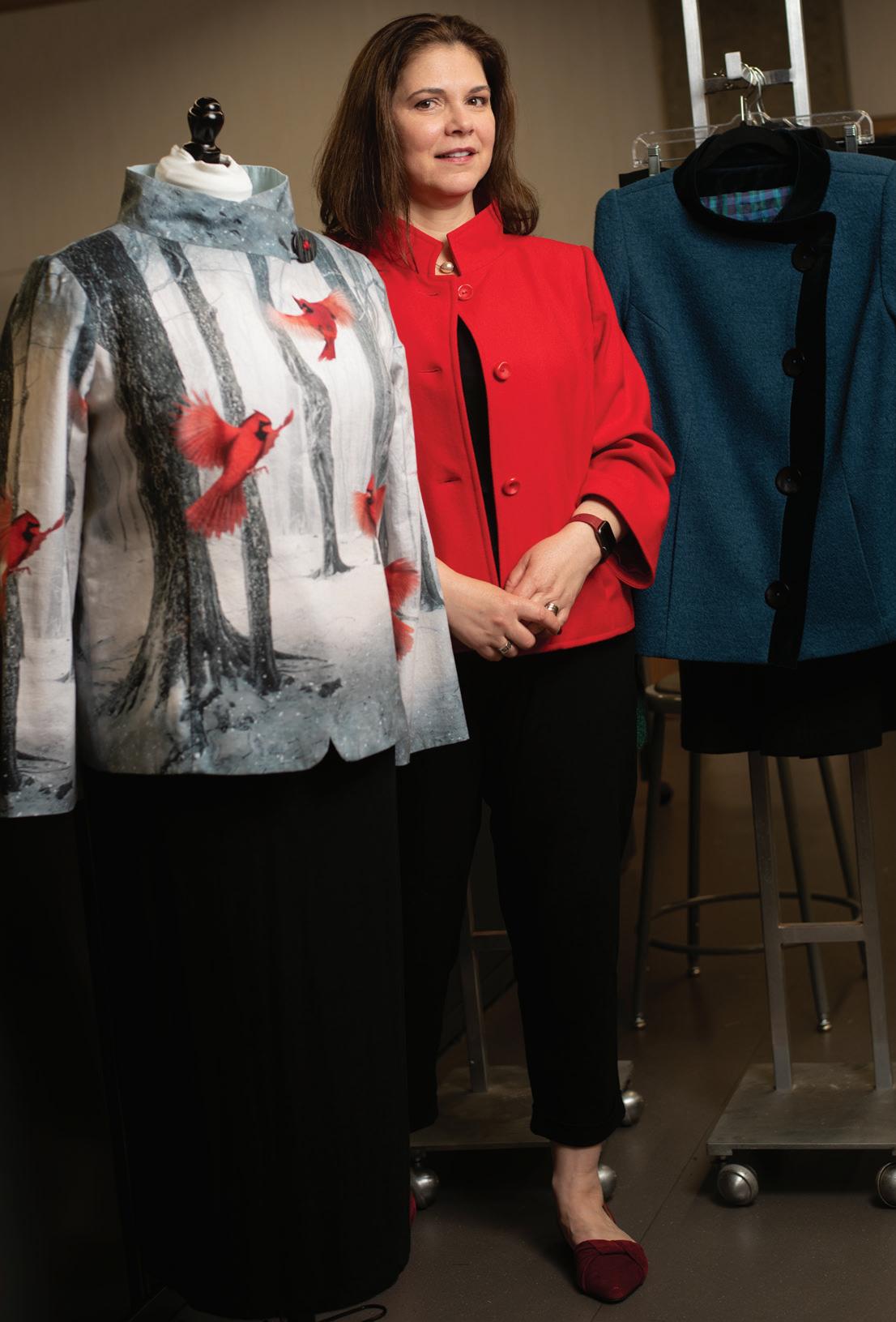
 Bonnang Kim
Maria Iordache
Bonnang Kim
Maria Iordache
Profiles 13.4 52
Crystal Hua Monique Perez
Bonnang Kim
Kim is interested in designing and creating, especially something 3-dimensional. Ever since she learned how to make patterns and sew garments in her early teens, she has always been with her sewing machines. During her 20 years as an interior, furniture, and architecture designer, she was particularly interested in the relationship between space and the human body and liked to play with architectonics and materials. As she continues her design path in fashion, she is looking at the human body even closer. Her tectonic design approach focuses on how the volume is constructed to fit to the body. She also constantly tries to push the limits of her imagination by creating experimental silhouettes with asymmetrical balance.
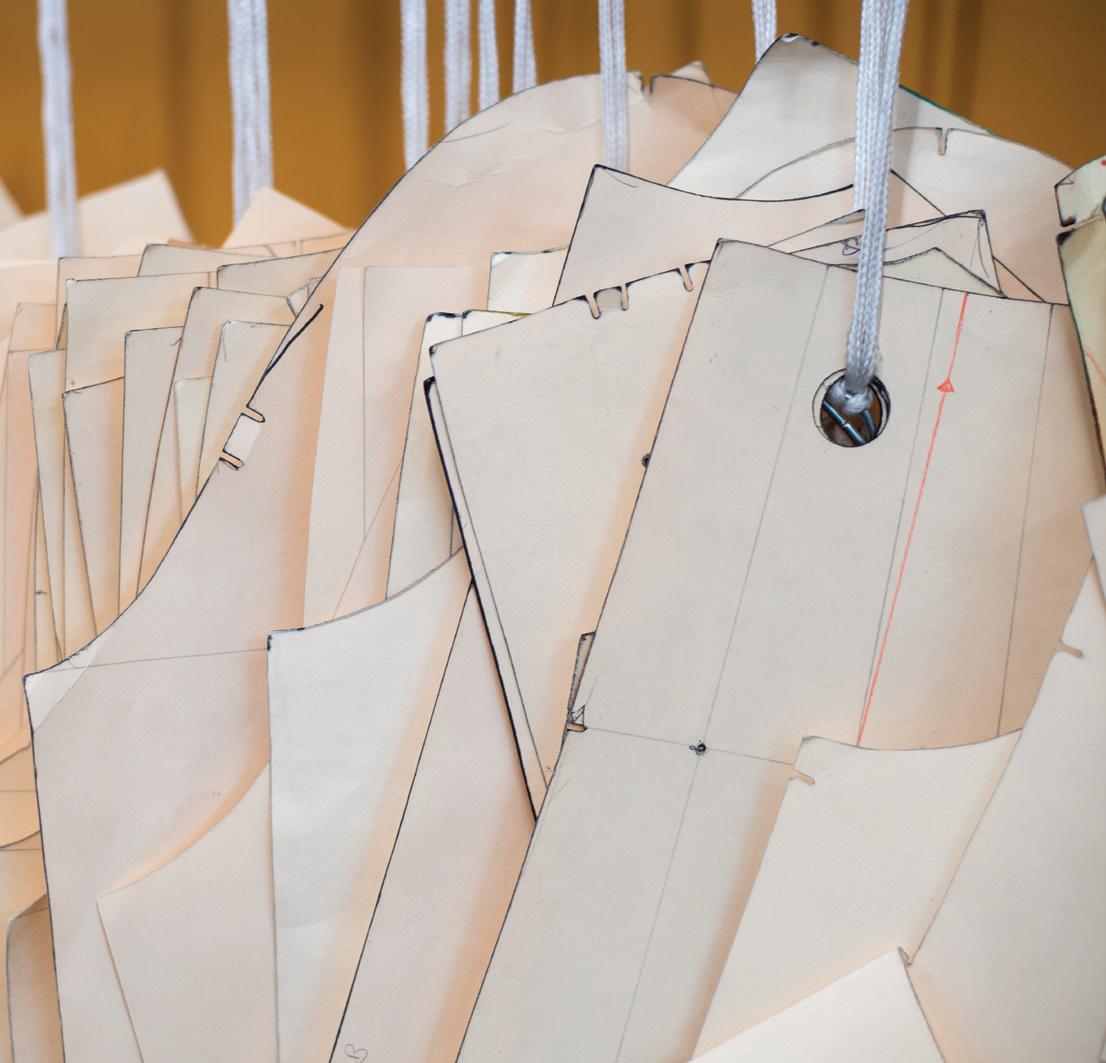
Instagram: bonnang.kim
Maria Iordache
Maria learned sewing and knitting from her grandmothers. She loves math, particularly 3D geometry and graphics. She studied bridge design, got a PhD in computational mechanics and an MBA. In parallel with her professional career, she continued learning about design and patternmaking and became particularly interested in fitting. She is intrigued that simulation and modeling technologies that existed for years in mechanical and aerospace engineering are hardly used in the apparel industry. She is on a mission to do just that and to create high-quality, perfectly-fitted, beautiful clothes for professional women.
Instagram: mariamiordache
Crystal Hua
Crystal wanted to be a fashion designer ever since she was little. Her first handmade piece was a costume from Sailor Moon, and she dreamed of making more clothes that give comfort and confidence, similar to how she felt when she cosplayed with her costume. Her inspiration comes from vintage garments from the 1940s to 1960s with a romantic and modern finish. She hopes to make pieces that are not only sustainable but also adjustable, with delicate embroideries and intricate designs, making each piece wearable for any occasion.

Instagram: by__chua
Monique Perez
Monique has found a passion for repurposing tired, unwanted clothes. She wants to bring an innovative reimagining of apparel to the world. With her designs, she plan to spark interest and creativity with her audience. She recognizes the need for sustainability within the fashion industry while also prioritizing the quality of her garments. Her vision showcases the potential clothing has to transform personal style and believing less is more , intends to create capsule-based designs. Monique is passionate about nurturing creativity and finding ways to express herself while inspiring those around her.
Instagram: mo_creativ

53


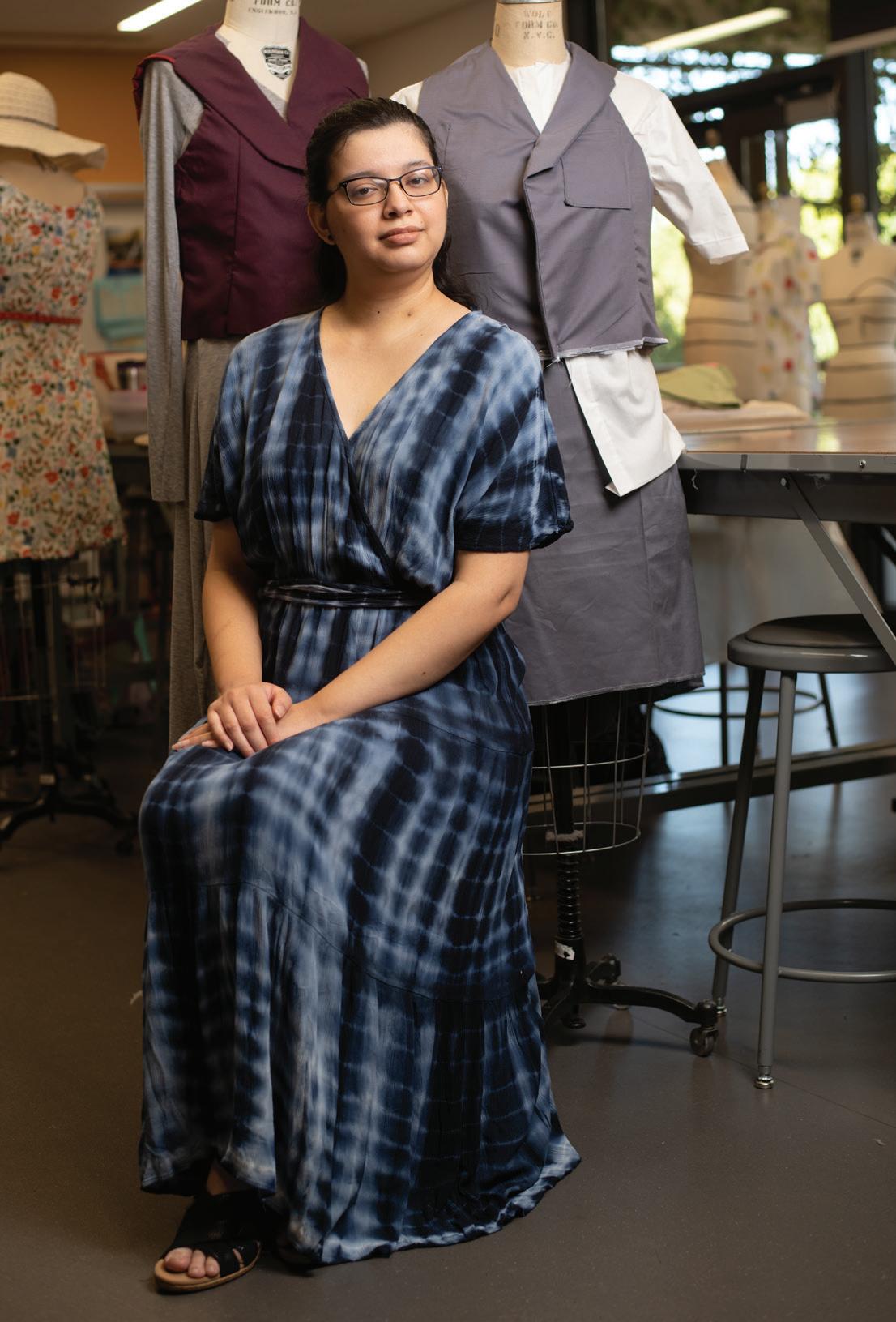
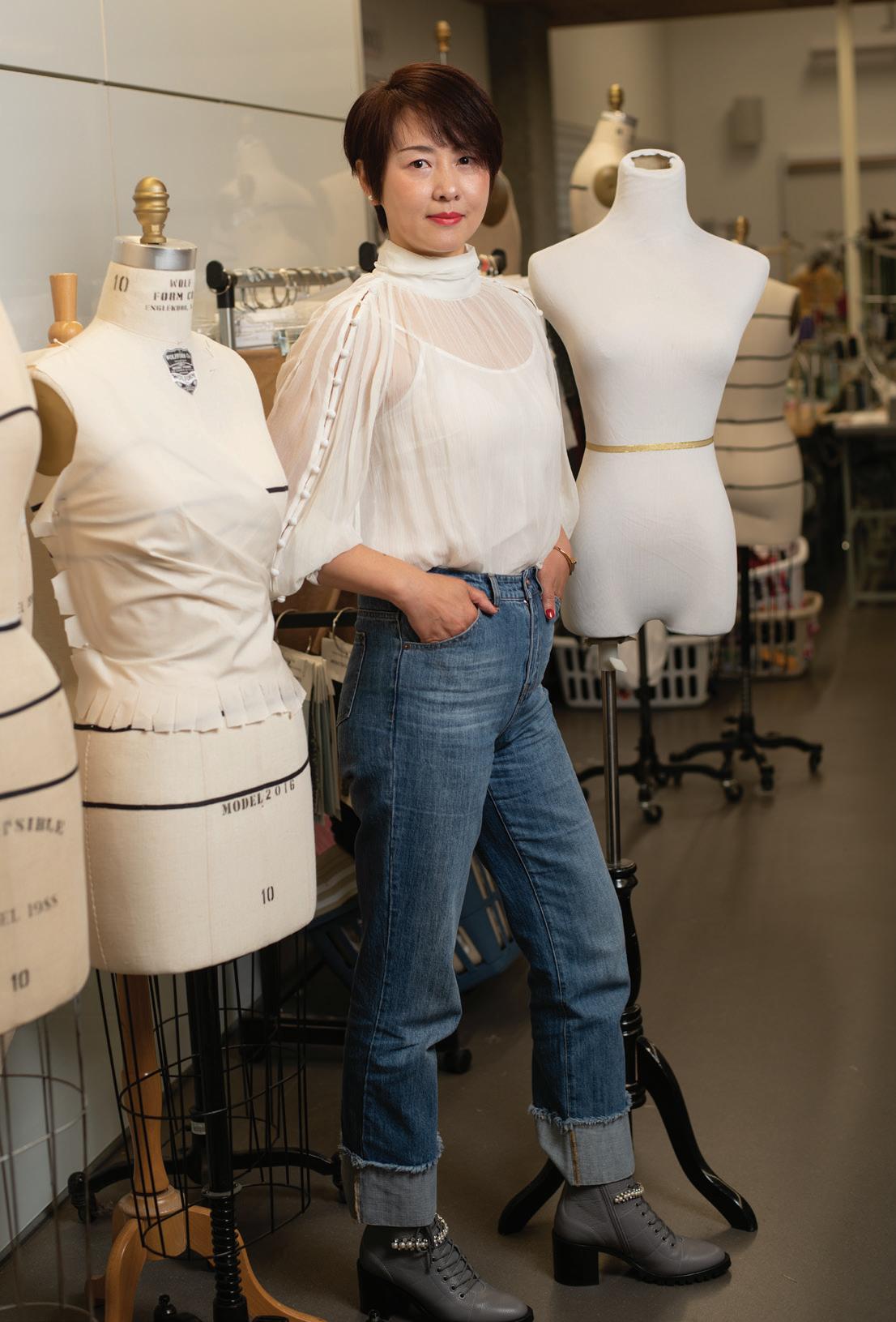 Nazrin Zamini
Rebecca Martinez
Nazrin Zamini
Rebecca Martinez
Profiles 13.4 54
Sirisha Gudimetla Wing Hung Flora
Nasrin Zamini
Nasrin grew up in Iran, with her talented parents, who made everything at home. She was influenced by her mother creating garments by knitting and sewing for the family. She started college in interior design. However, passing by the fashion lab, she was so mesmerized by the students working on draping fabrics on the body forms, she decided to continue in fashion. In school she learned about sustainable, environmentally friendly lifestyles. She likes to focus on bridge design and create high-quality, custom-sized garments for professional women. She also has a dream to bring vintage fashion back.
Instagram: Nzamini1
Rebecca Martinez
Rebecca is an ambitious upcoming designer. Coming from a humble background, she is driven to be successful. She believes it is in the fashion industry where she can achieve her dream. While a late bloomer in regard to the intricacies of the fashion world, she plans to create a versatile range of garments that are more suitable to the average-sized woman of today. She believes in designing color-neutral garments that are appealing to everyone. One day, she would like to be a costume designer for actors in the theater arts.

Sirisha Gudimetla
Sirisha’s interest in embroidery and fashion started at a very young age, her true inspiration being her mom. She grew up seeing her mom create beautiful outfits using a simple sewing machine, needle, and thread. She started doing hand embroidery on her clothes during her teen years. That is when her interest and passion for fashion began to blossom. Now, she wants to open a workshop, which mainly focuses on creating simple custom designer wear clothing with unique hand embroidery. She believes in using good quality and long-lasting fabric, while keeping sustainability in mind. Her goal is to use leftover fabric scraps wisely while designing and to bring awareness to people about environmentally conscious fashion.
Instagram: sirishag
Wing Hung Flora
Flora’s passion for haute couture developed organically in the bustling shopping hub of Hong Kong after moving there in her twenties from Hunan, China. Flora not only enjoyed what the metropolis had to offer but also parlayed all she observed and learned and, with partners, opened women’s clothing stores in Shanghai and Shenzhen. Since relocating to California, Flora has turned her interests to merchandising and hopes to either start a business of her own or work for a local fashion brand. In her free time, she enjoys shopping, events such as Fashion Week, traveling, painting, and sketching.
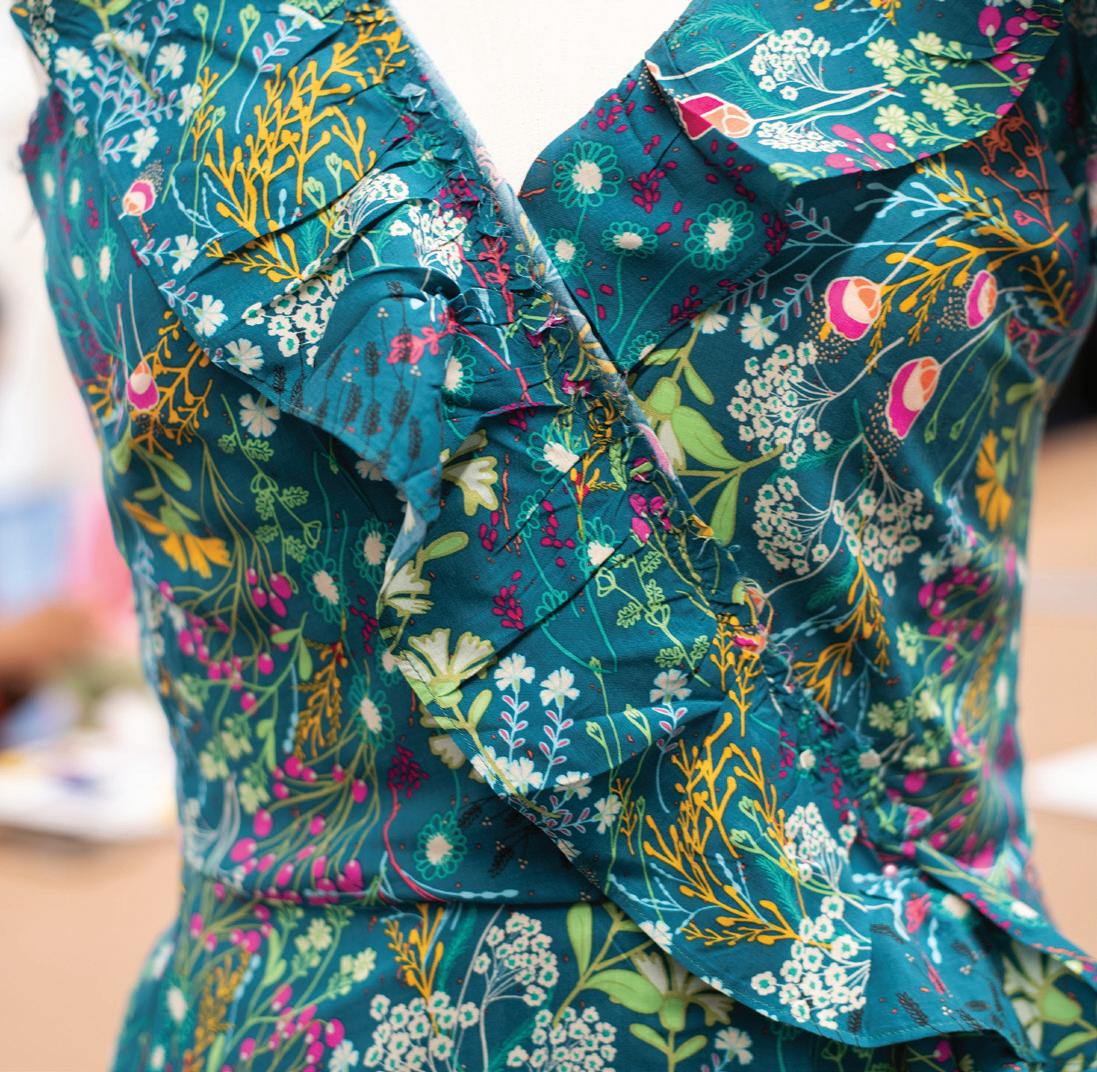
Instagram: floralo_fashion

C 55
West Valley Designs
Photographer: Mark J. Chua
Photo Assistant: Miles Caliboso
Wardrobe Stylist: Grace Martinez
Models: Gia for JE Model Management
Gabriella Mace and Michelle Leon for Stars Management
Hair: Ivo Skilj for Ivo Salon
Make-up: Renee Batres
Designers: Cilker School of Art & Design at West Valley College’s Fashion Design Students

Set Design: StageOne Creative Spaces
Location: Blanco Urban Venue
Producer: Kristen Pfund
Profiles 13.4 56
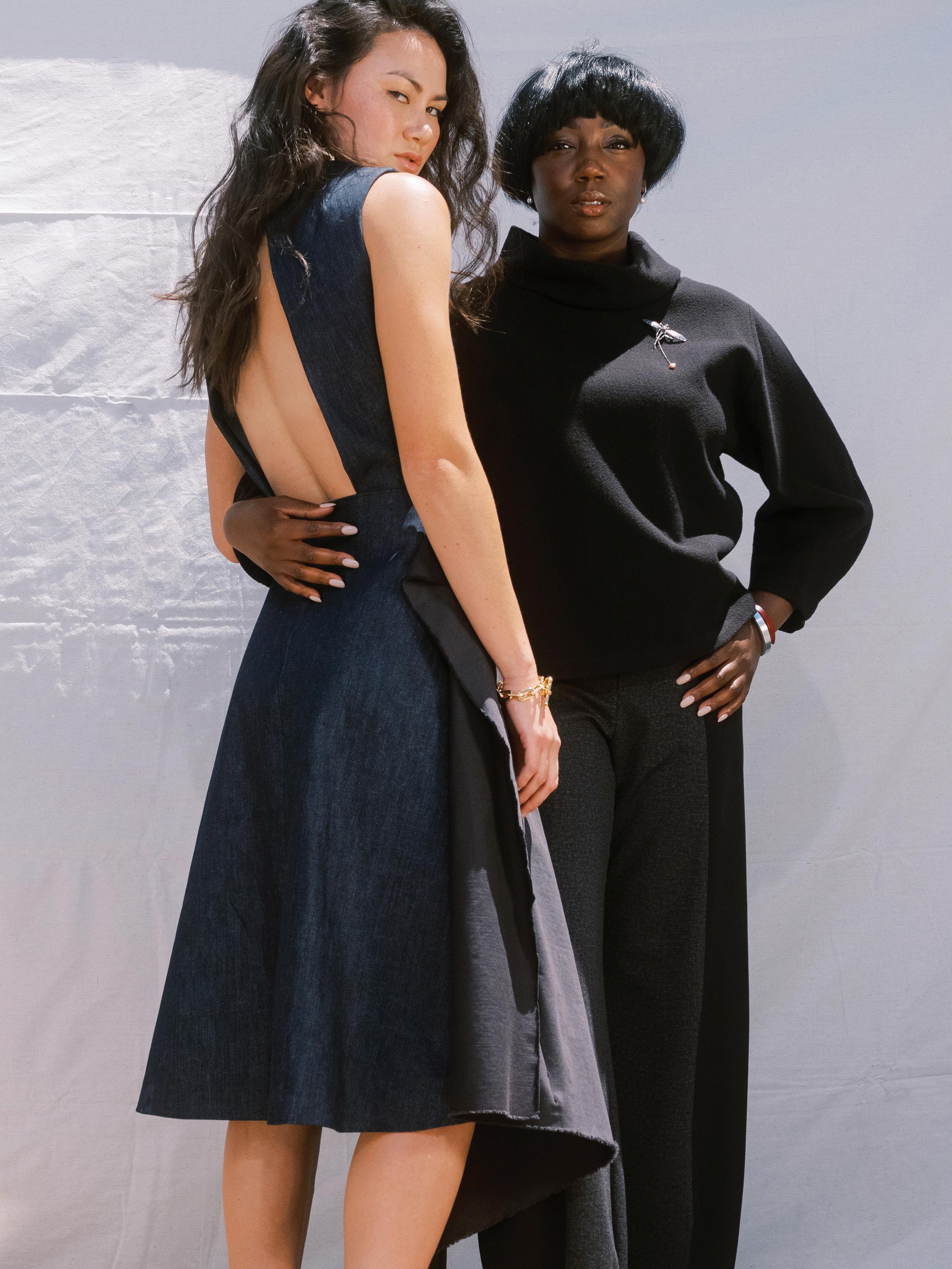
Maria Iordache
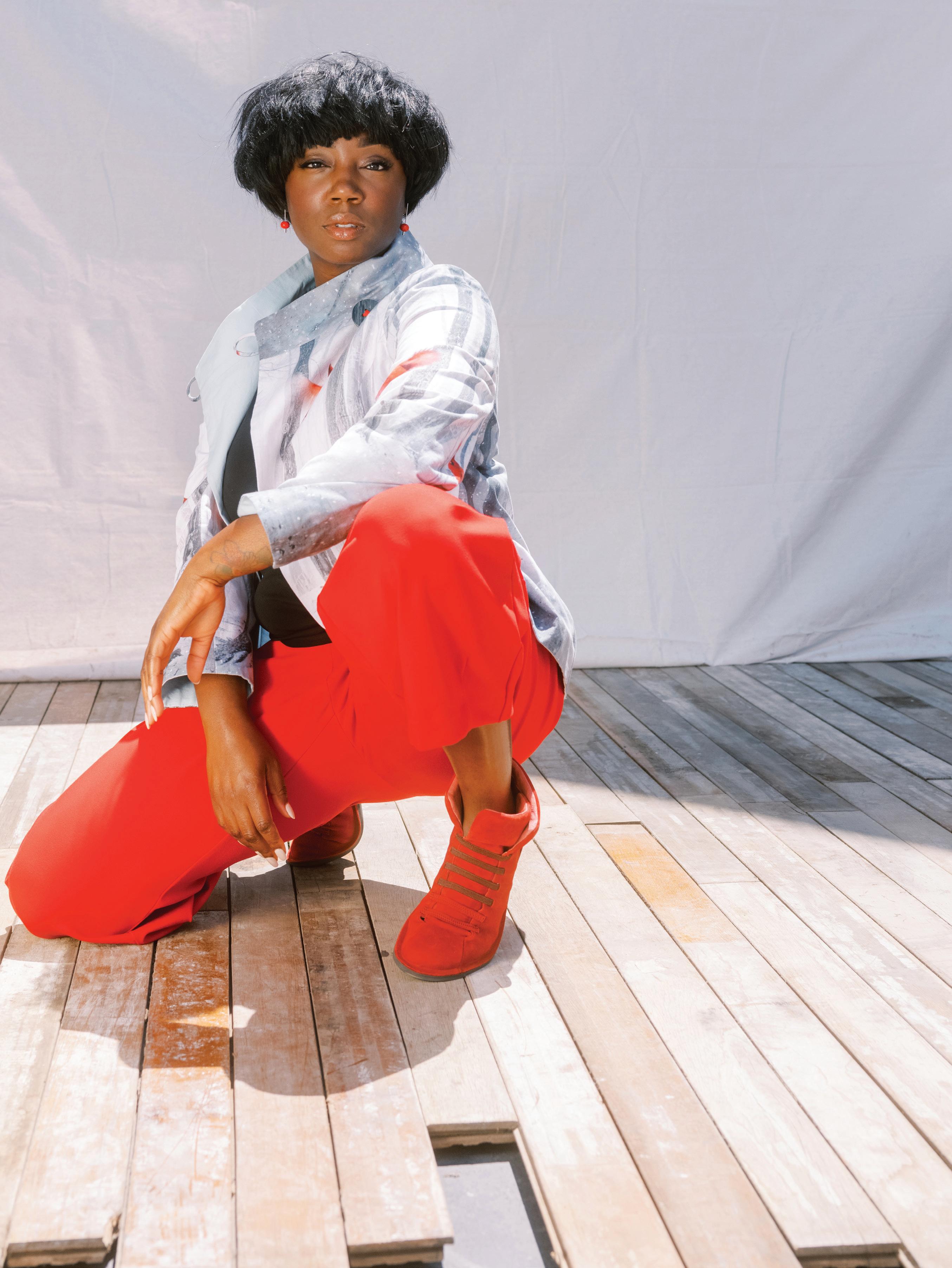
Bonnang Kim

Wing Hung Flora

Monique Perez

Sirisha Gudimetla


Rebecca Martinez
Crystal Hua
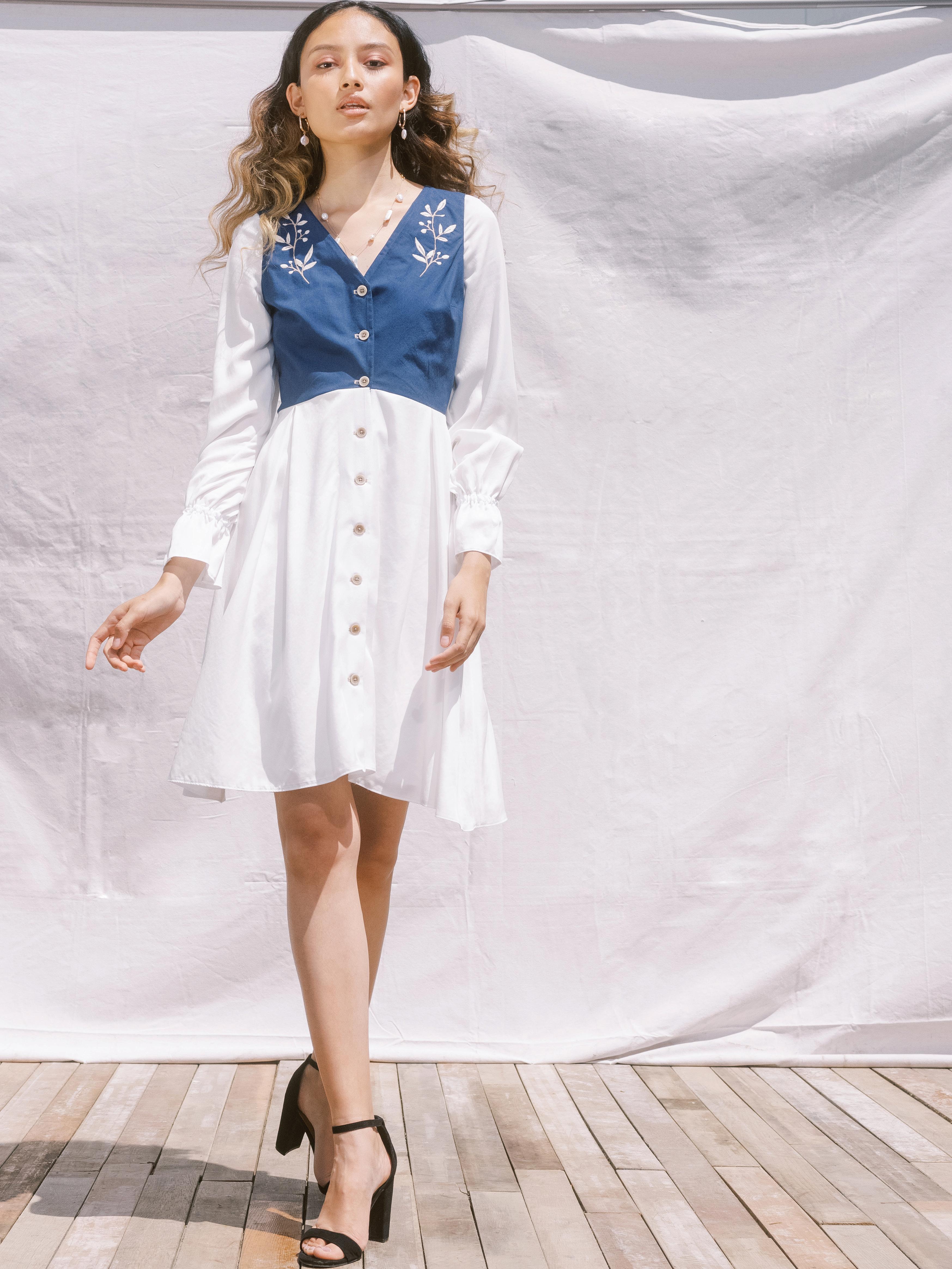
Nasrin Zamini
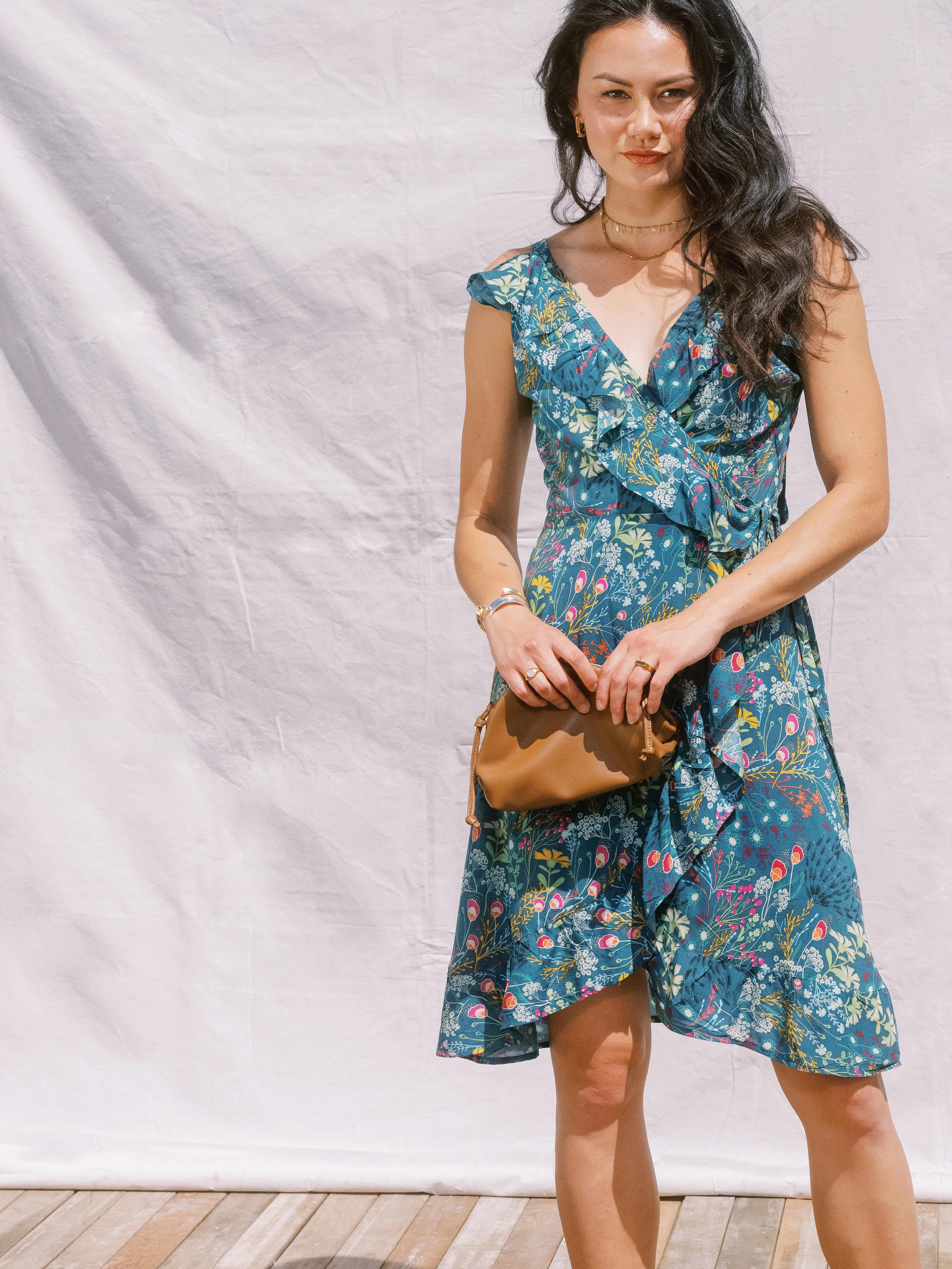

Profiles 13.4
Written by Brandon Roos Photography by Leopoldo Macaya Instagram headhunterscrew
Head Crew Hunters
As the six members of HeadHunters (HH) slowly trickle into the room, it becomes increasingly apparent that a conversation is not simply being observed, a family reunion has inadvertently been triggered. Eyes light up. Voices, steeped in joy, can’t help but rise in volume to greet one another. For some, it’s been years since they’ve been in the same room. The members present stretch over four “generations,” ranging in age from mid 20s through early 30s. All eagerly share their memories, which stitch together a story of how a group of kids from the East Side influenced a worldwide art form.
“Breaking in this crew is what gave me this voice to stand up for myself and have a backbone,” shares Joseph Felix, who goes by Scarface. At 25 years old, he’s the youngest HeadHunter, and first got on the crew’s radar at age 12. “I don’t
know of a single Hunter that didn’t struggle in some sort of way. We all came together, and those things all kind of went away. At least some of it.”
“That was our way to liberate ourselves and overcome all of those obstacles,” notes Eric Eugenio, an original member who goes by “Kerge.” “We don’t come from money, but this is something that makes us rich— our artistry through dance.”
Much like the early days of hip-hop, from which breakdancing is one of the four elements, the HeadHunters’ influence on break dance culture can’t be quantified by trophies or prize money. There was only one word that mattered— respect.
“If you go to a break dance competition, there will be the main show where there’s judges and an audience watching. While that’s happening, there will be cyphers among all the other b-boys,” explains Andre
Gonzalez, known as Dre Hood. “There’s no judges. It’s just me versus you, crew versus crew— pure recognition amongst my peers. That’s the rawest form of b-boying, and that’s what HeadHunters is known for.”
Formed by students from Piedmont Hills and Independence High Schools, HeadHunters started in 1999 as a merger of older b-boys from a crew called Trademark and a younger crew known as Innocent Bystanders. Their legacy began at a wellknown Bay Area jam in Palo Alto that year called Return of the B Boy, when members Naytron (Rene Abalos), Rob (Rob Davila) and Roland Bluntz (Roland Barnum) first competed under the HH banner.
“They took first place. From there, HeadHunters just stuck,” shares Kerge.
“It was the style too, because HeadHunters was just different,” adds second-generation member Roland Ibarra, known
W
Since forming on San Jose’s East Side over 20 years ago, HeadHunters Crew has gone on to gain worldwide notoriety and influence breakdance culture.
67

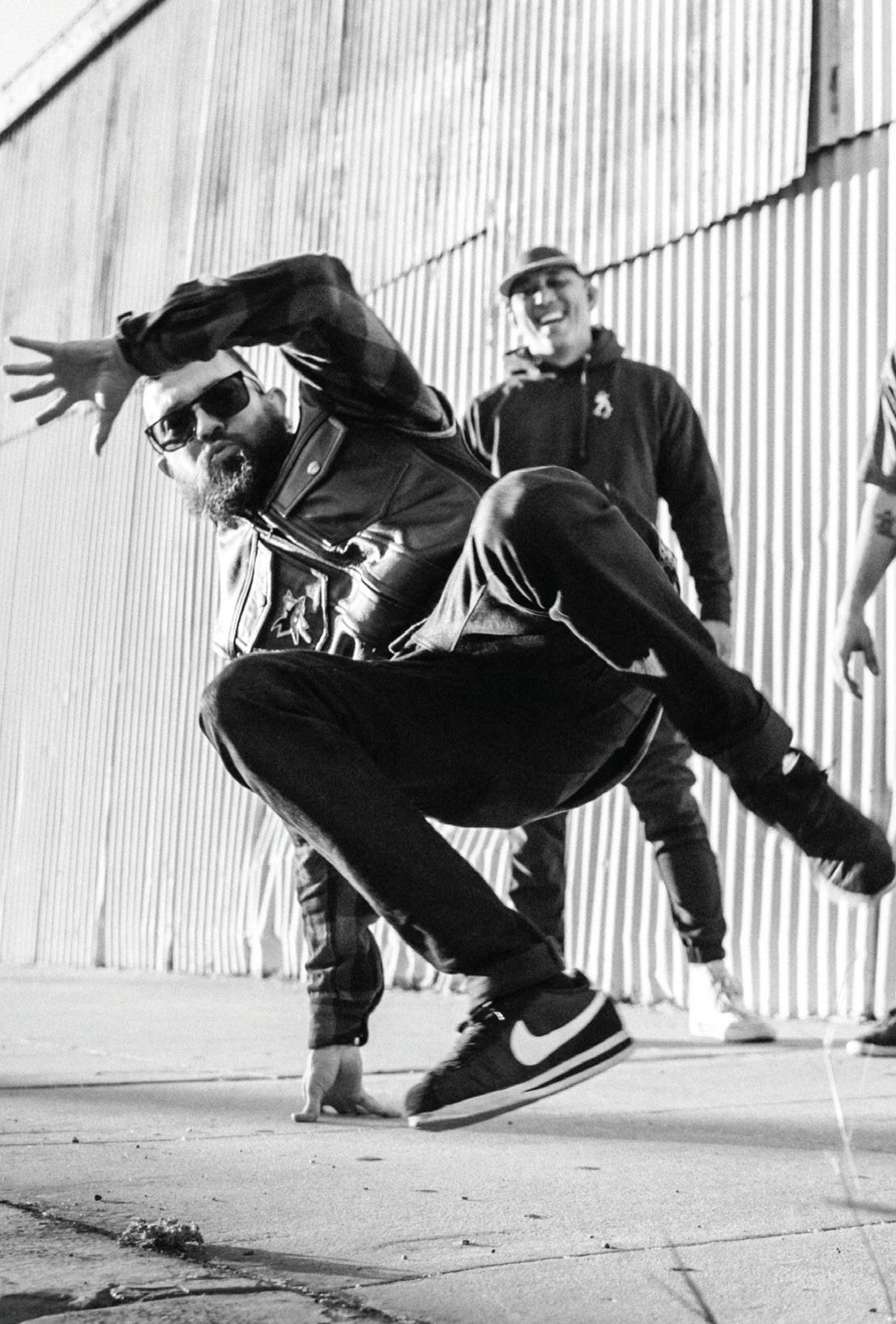


Scarface Adriaddict Dre Hood Adriaddict Dre Hood Kerge Scarface Profiles 13.4 68
Kerge
as B-boy Roe, when speaking on the crew’s early influence. “The way they did things, you were just captivated by it. It almost became known as the Bay Area style.”
In particular, members share that HH were known for being raw, aggressive, and unorthodox. Battling (i.e., directly competing) against another dancer or crew is a core part of breaking. However, HeadHunters cultivated their mentality by battling each other often. Kerge explains that the crew would regularly end practices by sparring until there was only one b-boy left standing. “That’s how we were bred,” adds second-generation member Adrian Vasquez, who goes by Adriaddict.
HeadHunters also carries a specific initiation ritual: any prospective member must battle into the crew. Typically, that would mean throwing down rounds (exchanging dance sequences) against one
person or a handful of opposing crew members. In this case, a new member must battle every member of the crew until they decide you’re finished. As Scarface recalls, with the caliber of the HeadHunters crew, new members would expect to go at least 20 rounds— all with a healthy dose of trash talk mixed in.
“It’s your blood, sweat, and tears. You leave it all on the floor,” notes Kerge of the initiation. It’s a marathon to test an incoming member’s mettle. But in the end, after being pushed to the limit, that member is then embraced into the fold like family.
Since they were early to adopt the Internet as a tool to share their skills, many of the crew’s battle videos, some of which stretch all the way back to the early 2000s, can still be found on YouTube.
“I think that’s really what brought us worldwide. We had guys that were active and really
competitive, and we posted it online,” notes Adriaddict. “Because of that [footage], we have that long tail.” He’s witnessed that influence firsthand while teaching breakdancing at Google. When their name came up, a student of his from Belarus mentioned he was familiar with the crew. In fact, he’d been watching their videos online for years.
Yet despite the great reach they’ve gained, HeadHunters still emphasize that the intent has always just been to prove that San Jose has something to say.
“We put our stamp in the scene, and it’ll stay there,” says Dre Hood. “Everyone will always know Naytron, Nasty Ray, Roland Bluntz, Deja Vu. Some kids from East San Jose made a statement, [and are] world renowned for the rest of the history of breaking. That’s the ultimate accolade.” C
69
“That was our way to liberate ourselves and overcome all of those obstacles. We don’t come from money, but this is something that makes us rich—our artistry through dance.”
-Eric Eugenio (Kerge)
Opposite page Kerge (Eric Eugenio), Scarface (Joseph Felix), Adriaddict (Adrian Vasquez), Dre Hood (Andre Gonzalez).
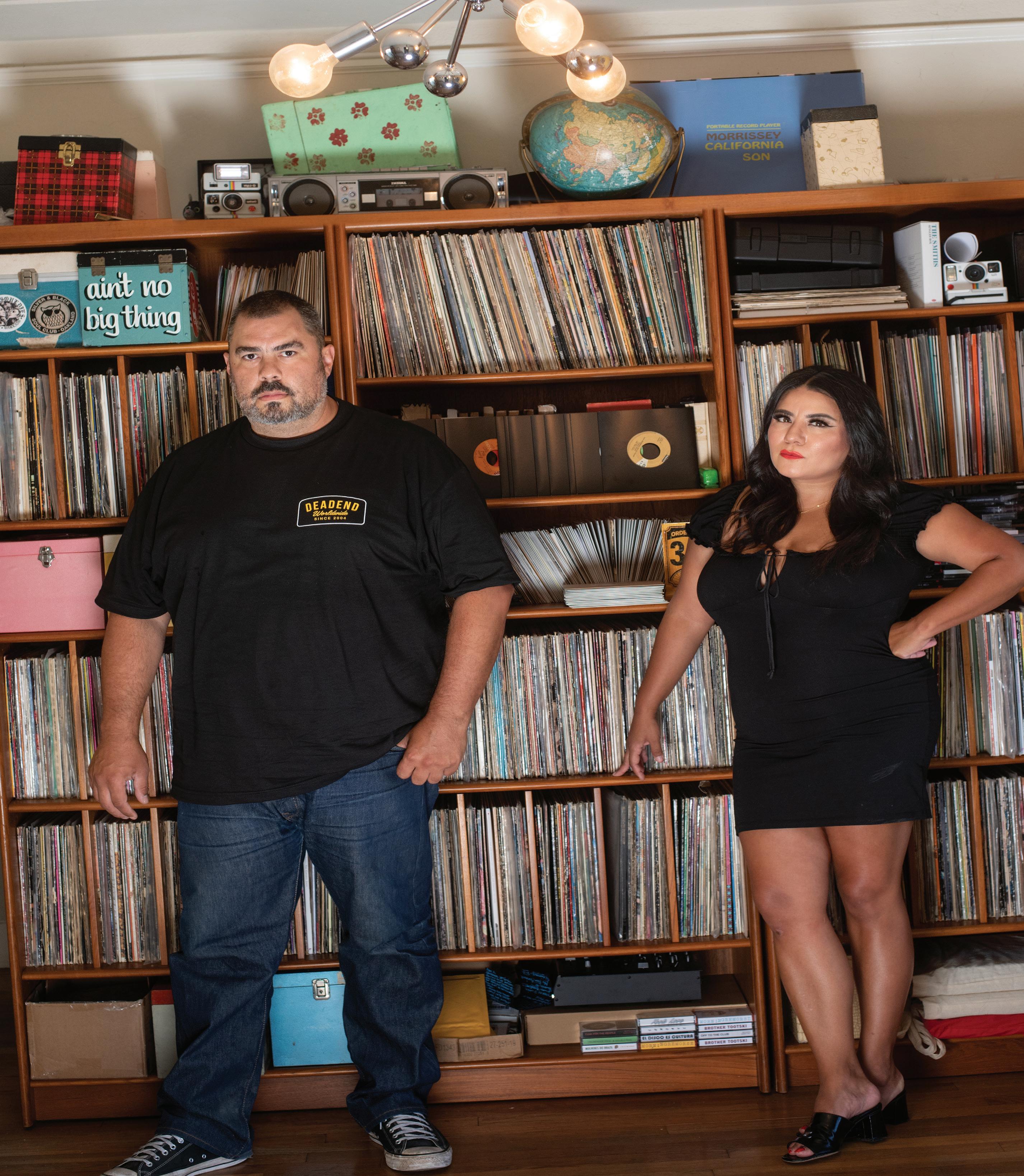
 Written by Brandon Roos
Photography by Daniel Garcia Instagram flipsidelovers akro1 ambitiousØutsider Youtube flipsidelovers
Written by Brandon Roos
Photography by Daniel Garcia Instagram flipsidelovers akro1 ambitiousØutsider Youtube flipsidelovers
FlipSide Lovers
The genesis of analog DJ duo Flipside Lovers can, coincidentally enough, be traced to a single 45 record.
Anthony Perez began playing “You’re Acting Kind of Strange,” a rare soul single by the Chappells, one evening while DJing at Caravan Lounge in downtown San Jose. Stephanie Ramirez, a regular at the soul and oldies nights where Perez played, was in the room and immediately approached the DJ booth, singing along. She asked how Perez knew about the record. He had the same response. This was a song you had to dig to find. How did she know it?
“I met Anthony collecting records,” shares Ramirez, known on the decks as Ambitious Outsider (she’s a gigantic Morrissey fan). While they had orbited similar circles, it was their deep mutual passion
for collecting vinyl that kickstarted their connection, and eventual relationship.

In the years since that first encounter, they’ve built a reputation for their deep collection of sweet soul 45s. Some of those records have traveled the world with the couple, helping them share the famous West Coast sound with listeners in Paris, northern England, Mexico, and throughout the US.
Asked if they classify their sound as oldies, both are quick to say yes. Defining that sound, however, can be tricky to those not familiar.
“To me, ‘oldies’ is specific to California. It’s not defined by a genre, or even a decade. Call it a collective playlist that’s been growing since the 1950s,” explains Perez. “My dad listened to these same songs. I can’t think of another genre or movement where it’s so con-
nected generation after generation. The classics are the classics, and we never get tired of them.”
The two pay tribute to that distinct tradition through the records they collect and play. They also take part in events where oldies are still a staple, cruising around San Jose with other lowriders as they show off their recently purchased white 1962 Chevy Impala named Blanquita.
“That’s inherently a San Jose culture— Lowrider magazine, King and Story,” points out Perez. “We’ve traveled the world and been able to show that culture to other people. I feel it’s important for us to try to do that.”
Their individual stories as collectors start at San Jose’s flea markets. While in elementary school, Perez remembers driving up from Gilroy
W
71
First united by a single rare song, Anthony Perez and Stephanie Ramirez, known as Flipside Lovers, are on a mission to share California’s oldies story with the globe.
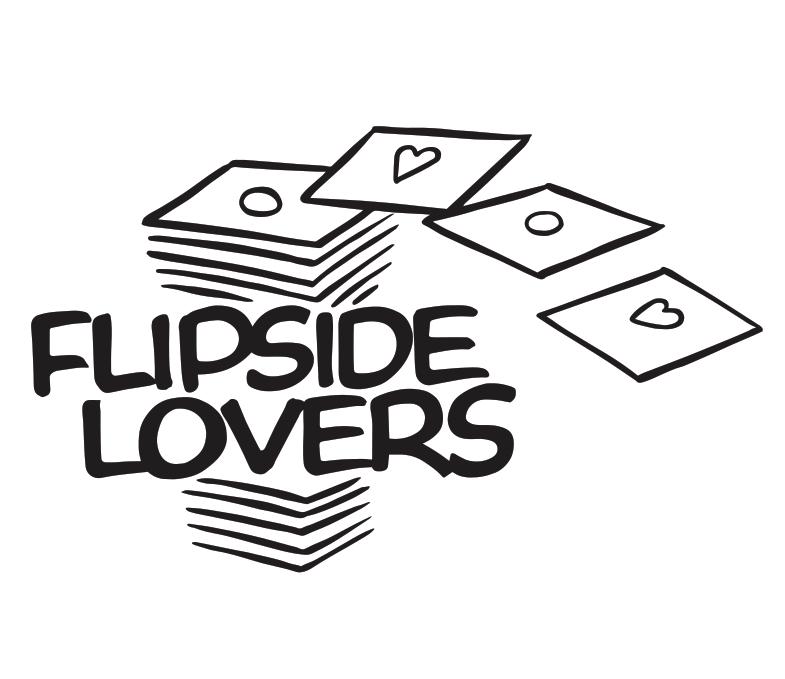



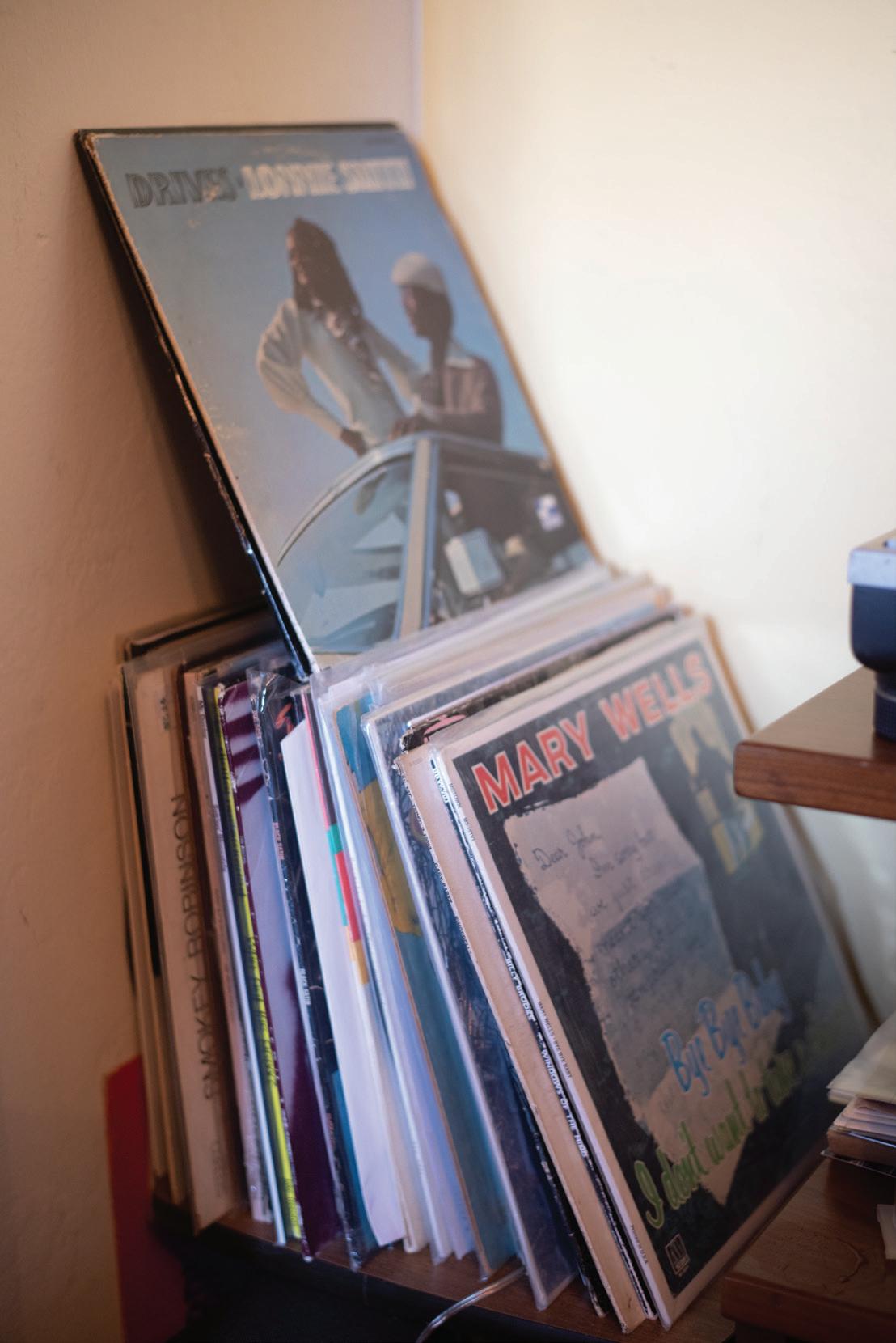
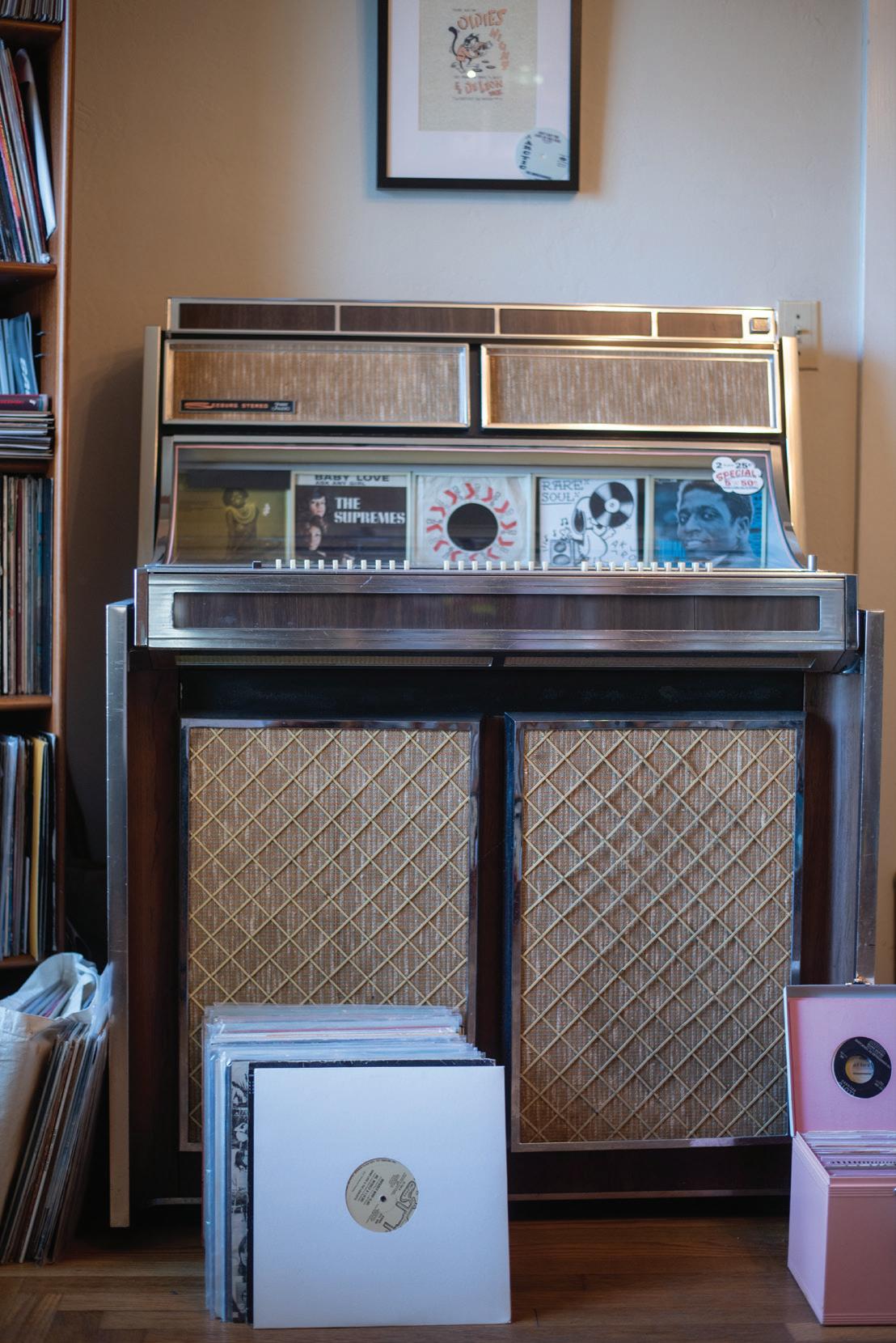
Profiles 13.4 72
and begging his parents to buy him rap tapes. His DJ name, Akro1, stems from his days as a graffiti writer.
Ramirez started her collection by picking up records, five dollars a box, from people who were simply trying to get rid of them at the Capitol Flea Market. “I never knew collecting people’s trash would later be something you played out for people,” she shares. “I feel very lucky, because if I tried to start collecting records now, there’s no way I would get a lot of stuff I have.”
“I’ve had the bug since I was very young,” notes Perez. “I would take anything and everything that anybody was giving away.” When his dad noticed his collecting habits, he gave Perez lists of records to track down. Once he did, Perez would record tapes for his father to play in his car.
Surprisingly, both admit they never collected records with the goal of becoming DJs.
“I always just bought records because I loved records,” Perez says, though he adds “eventually it almost becomes a responsibility to share them.”
After a few sets on local college radio, knowledge of his collection spread, and his gigs picked up.
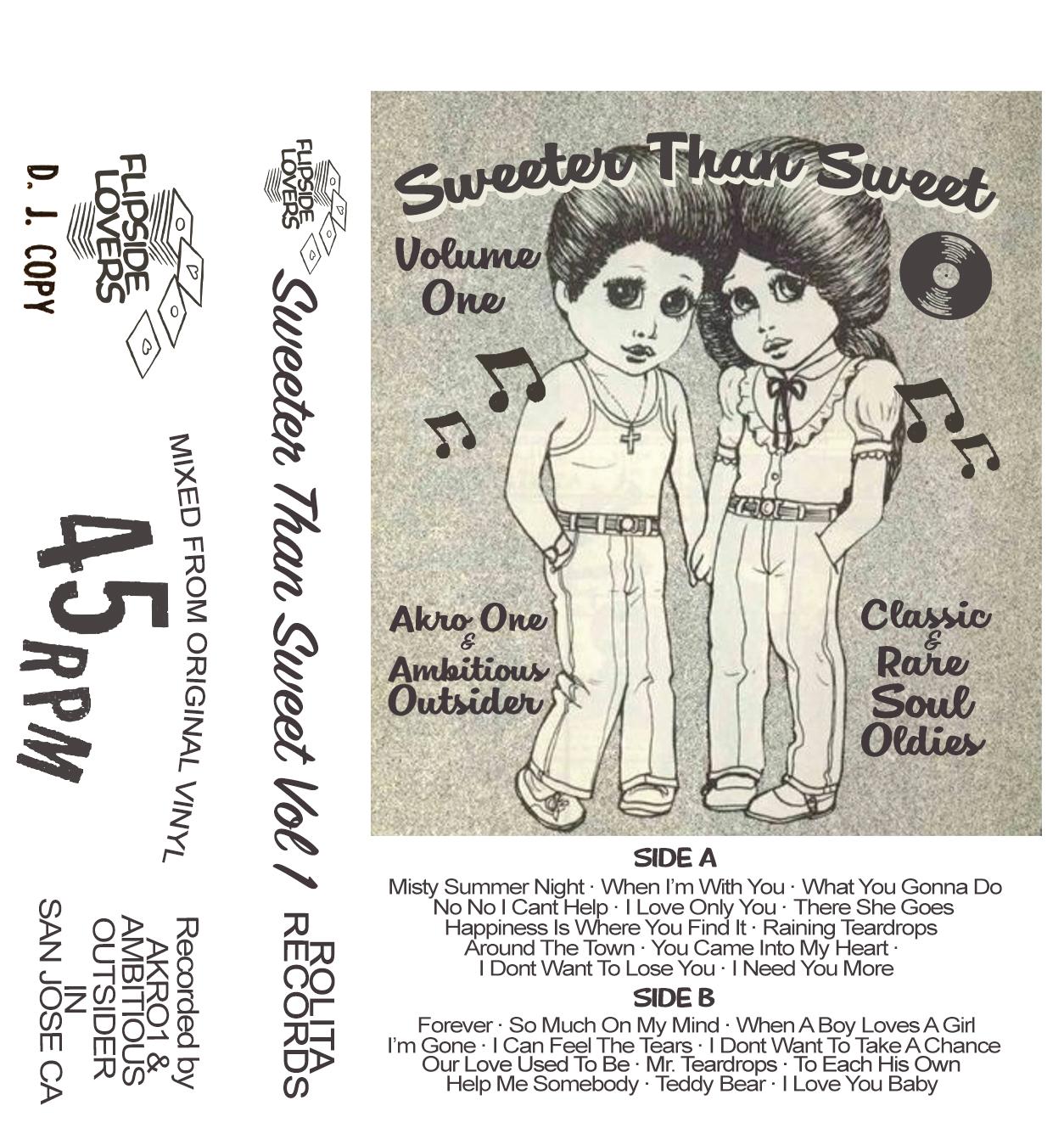
Ramirez started by recording vinyl mixes purely to share her music collection with others. “For me, every single 45 that I own means something to me. It’s very personal, which
is why I don’t like saying I’m a DJ. I’m a collector at heart,” she admits.
While they’ve performed together under their individual names for years, a few years back they coined themselves Flipside Lovers, an ode to the often slower “flip side” of a 45 record single. The two recently returned as resident DJs at Park Station Hashery, where they perform twice a month as part of the restaurant’s Two Wheel Tuesdays. They also play monthly at True Brew along The Alameda.
Their drive to share history and celebrate San Jose’s local culture seems to ground their pursuit of the next elusive 45 they’ll add to their collection. It also inspired an idea to upload some of their rare records to YouTube during lockdown. That gesture allowed them to directly connect with the families of those artists, some of whom had never even heard the music before.
“It’s like a piece of history we own,” says Ramirez when speaking about her reverence for the records in her library. “We’re archivists. We care about what’s out there,” concludes Perez. “You might just die tomorrow, and it could be trash, but I feel some weird responsibility to build this library. At this point, we’re 20 years in. Hopefully there’s another 20 or 30 to go.” C
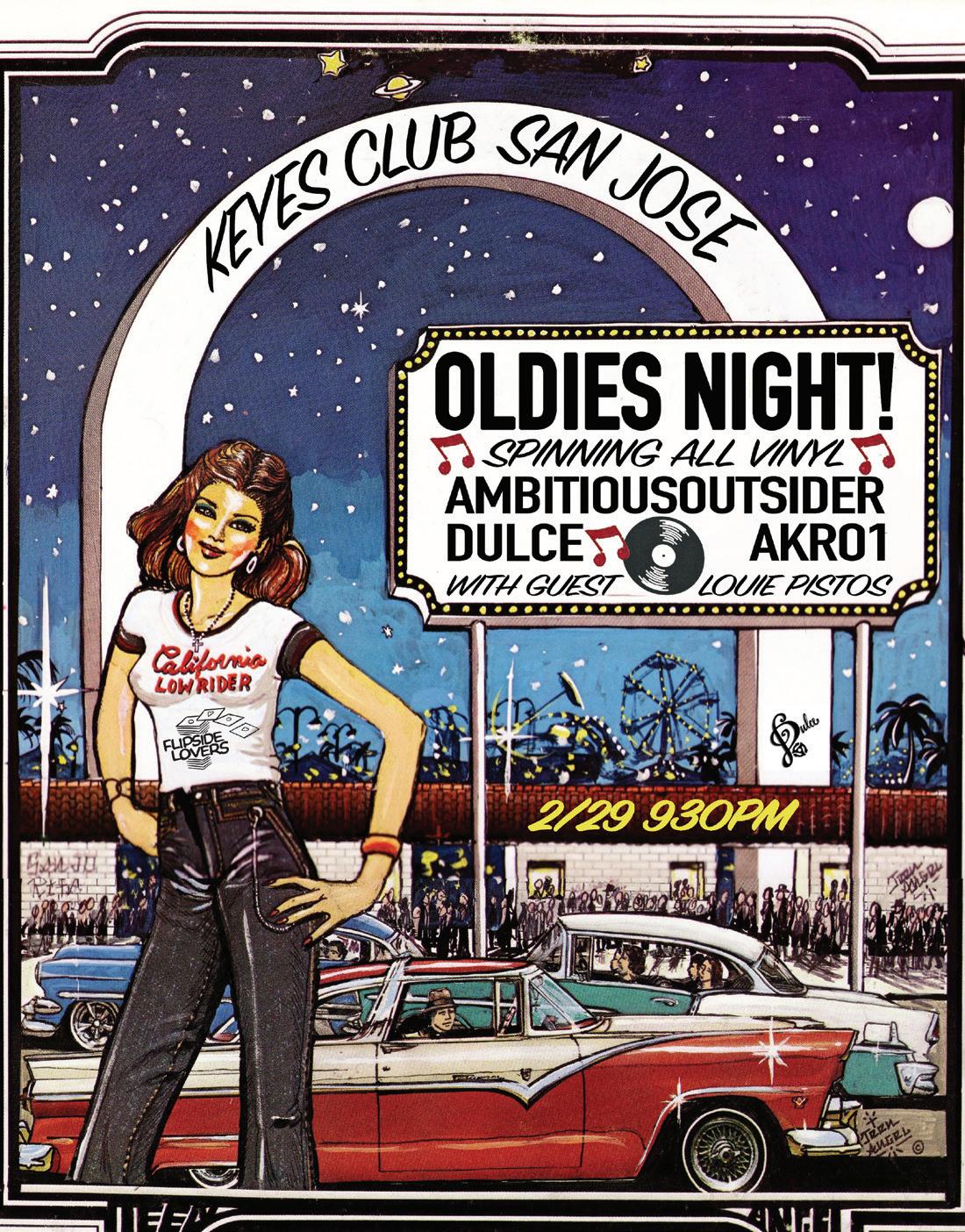
73
“I always just bought records because I loved records. Eventually it almost becomes a responsibility to share them.”
-Anthony Perez (Akro1)

Profiles 13.4 74
L to R: Pops, Hanz, Shakila, Lysn and J-Fed
Barely
Funktional
In person, Barely Funktional is a conglomerate of frantic kinetic energy. In dialogue peppered with jokes and laughter, group members share scraps of their origin story in bursts of fervent joy. Trumpeter Duhran and bassist J-Fed are not present, but the group’s core four sit in: keyboardist and producer Hanz; Lysn, the group’s emcee; drummer Shakila Zangeneh; and guitarist and secret weapon Mark Richards, known to most as Pops.
Our lively exchange is an apt reflection of their live sets—loose yet focused. A live video of “Dip Move” from last year’s San Jose Day provides a vibrant preview, with a spare, brooding bassline and hyper, double-time cymbals establishing a fertile sound bed for gymnastic lyricism.
Befitting their informal tagline, “we’re a lil’ weird,” the group blossomed out of a chance meeting at a dog park in Mountain View.
As Hanz vividly recalls, he first spotted Lysn while he was surrounded by eight canines (he worked at a dog daycare at the time). Striking up a conversation, he learned Lysn was a rapper studying at SAE Expression College. Hanz had been trying his hand at FL Studio and soon was eagerly sending over batches of beats for a hopeful collaboration. After several exchanges, Lysn finally came across a beat that spoke to him, resulting in their first collaboration, “Wack Rapper.” In that moment, the group Ability was born. “It’s really jazzy,” explains Hanz of Lysn’s process. “That’s what initially interested me in him. Not only was he able to rap and write pieces, but he would freestyle it first then record it.”
Lysn’s connection to hip-hop culture is deeper than most because rap’s building blocks literally taught him how to communicate. He learned how to read and write as a sophomore in high school by scrawling his freestyled lyrics before he forgot them. In the years since, his keen ability to rhyme at will has become a crowd-pleasing highlight of Ability’s sets.
Ability’s first shows involved Lysn rapping over instrumentals
 Written by Brandon Roos Photography by Stan Olszewski Instagram barelyfunktional akro1
Written by Brandon Roos Photography by Stan Olszewski Instagram barelyfunktional akro1
Assembled as if through serendipity, Barely Funktional’s origin story is a testament to music’s inclusive spirit.
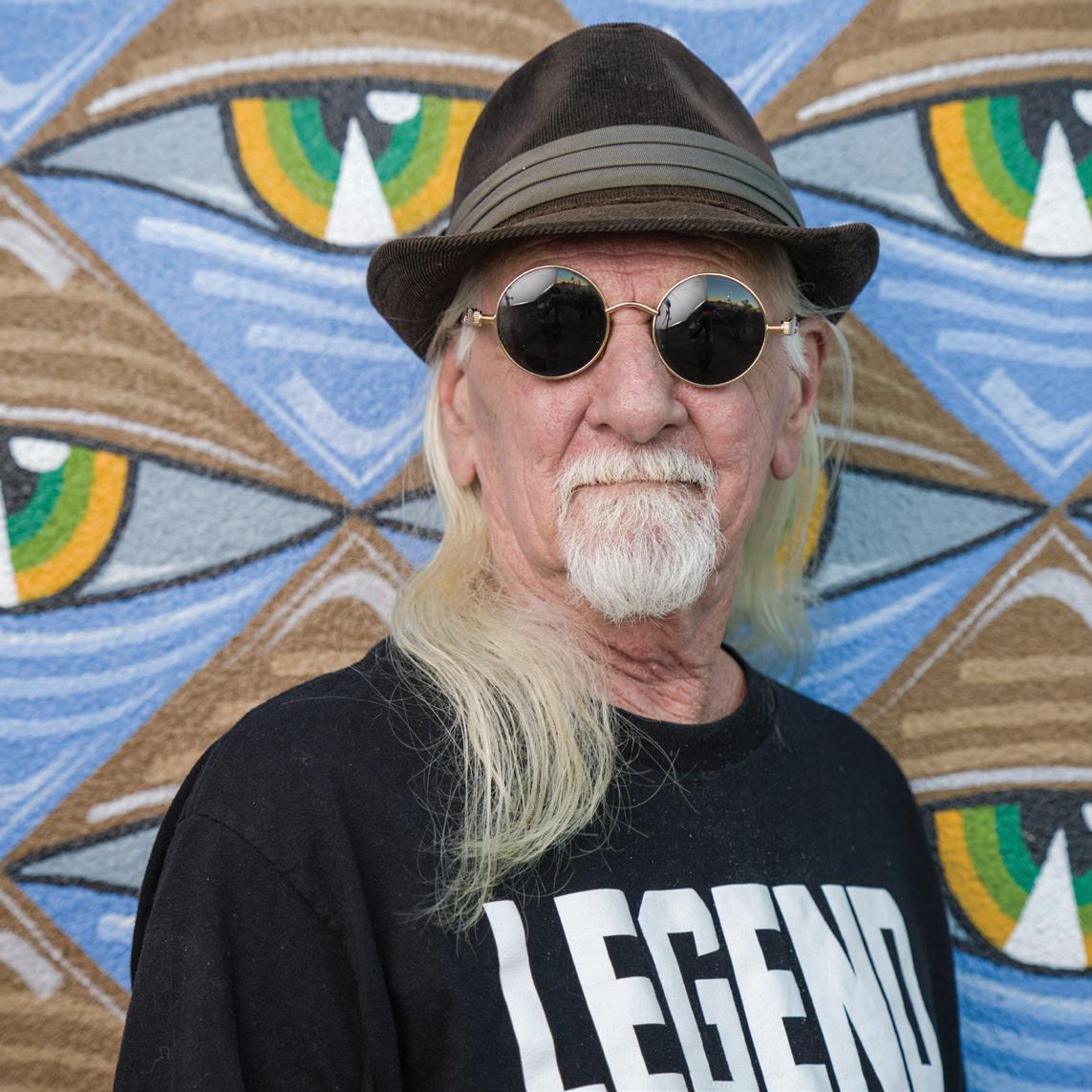




Profiles 13.4 76
with keyboard accompaniment, though in time, their sonic vision slowly integrated more live instrumentation. That shift did create a learning curve for Lysn. He was used to music software’s perfect metronome, which his human counterparts couldn’t replicate. Since then, the group’s learned to let his lyrics lead the way.
Pops, father of Hanz, may be the ringer of the group, but he’s always quick to counter that he’s just another musician in the collective. “I’ve made a career, some 50 years now, of learning new music, new styles, new ways of playing,” notes Pops, whose resume includes stints with metal bands, country groups, and even touring revues. “This group of people gives me an opportunity to experience hip-hop from a personal level.”
Shakila’s inclusion came purely by chance, though in retrospect the band sees serendipity in their first encounter. After performing a set with another band on the bill, she was asked to fill in for their absent drummer last-minute and played her first set completely unaware of her bandmates and their material. She’s been their permanent backbeat ever since. “Everything around me was built for it,” shares Shakila of her decision to pursue music. Though she bought her first drum set at 18, she grew up in a musical household and even recently started teaching aspiring young musicians how to play drums.
Fearful that the name “Ability” was just too cocky, Barely Funktional arrived as a humorous remedy. Through a weekly residency at Sunnyvale bar the Office in 2017, the group gained a space to sharpen their live chops. Those reps led to a banner 2019, which included performances at Cafe Stritch, the Continental, a headline gig at the Ritz, SoFA Street Fair, Taylor Street Night Market, Garden at the Flea, and San Jose Jazz Summerfest.
This year is setting up to be a year of tackling new frontiers. Having secured new equipment, the band is finally ready to start recording their material, though there’s no plan for release just yet. There’s also a 30-foot boat trailer they recently turned into a stage, meaning there’s no limit to where they might perform next. C

“This group of people gives me an opportunity to experience hip-hop from a personal level.”
77
- Mark Richards, AKA Pops, guitarist
ALBUM PICKS
St. Vincent Daddy’s Home (Loma Vista)
Release date: May 14, 2021
Written by Taran Escobar-Ausman
On the surface, St. Vincent’s new album, Daddy’s Home, is wrapped in early ’70s nostalgia, evoking the sounds of Sly Stone, Pink Floyd, and Bowie, among others. St. Vincent, aka Annie Clark, saw to it that everything—from the sound, songwriting, marketing, and videos—was steeped in the early ’70s. The angular, warped noise-pop of recent albums is traded in for warm, soft chord vamps that hug slinky bass lines. The album is more than just an homage, however, and framing it deep in the early ’70s speaks to the album’s conceptual arch.
Clark’s new persona for the project was inspired by Candy Darling, who was part of Andy Warhol’s inner circle before she passed away in 1974, becoming a transgender icon since. Clark pays homage to her in the track “Candy Darling,” where Candy is “wavin’ from the latest uptown train,” alluding to Candy’s symbolic train rides from her home in Long Island to Manhattan. Clark intertwines Darling’s journey with her own experiences in the shuffling funk of “Down and Out Downtown,” singing, “Last night’s heels / On the mornin’ train / It’s a long way back downtown.” Clark herself has been both forthright and ambiguous about the album’s meaning. While it’s obvious that the title track refers to her dad’s release from federal prison, Clark asks who this “Daddy” really is.

The early ’70s saw the second wave of the feminist movement challenging societal expectations of women, with a host of court victories that brought both the legalization of abortion and birth control for unmarried women. In “Melting of the Sun,” the lyrics are a “thank you” to the inspiring women who came before her who were brave enough to challenge, or melt, the seemingly unmovable power structure of the patriarchy.
The depth of the inconclusive and dubious nature of each song is what makes the whole album so rewarding and further establishes St. Vincent as one of our strongest songwriters.
Favorite Track: “…At the Holiday Party”
ILOVESTVINCENT.COM
Instagram: st_vincent
The Egyptian Lover 1986
(Egyptian Empire Records)
Release date: February 5, 2021
Written by Albert Jenkins
Performing music of a bygone era in 2021 isn’t for the faint of heart. Current aesthetics are so intriguing to young enthusiasts that nearly anything new that sounds old gets quickly dismissed. The Egyptian Lover breaks all those norms and remains the authentic, first-generation artist he is.
In 2014, Egypt reignited his career with his breakout LP, 1984, named after the year of his first LP, On the Nile. The new generation was salivating for the ’80s electro sound, and he followed up with 1986 in 2018. His newest LP is the third in the series and is a continuation of his entire vibe—feel-good underground electro. The backbone of each song is a Roland TR-808 drum machine, and he does a masterful job complimenting each piece with electrifying synth arrangements, performed by Brian Ellis.
The LP 1986 is twelve songs deep, each over four minutes long, with the intention to grab you and force you onto the dance floor. “Lose Control” is an epic party jam with a whirlwind of stabs, drones, sound effects, and a hypnotic beat that rides for seven-and-a-half minutes. Another standout is “Freaky Girl,” the type of beat you hear when it’s time to go, but the party keeps going, and you have to stay for another drink. This one is clearly for the DJs, from the opening drum beat and synth hits to the jam-packed breakdown.
The ’80s birthed the artist Egyptian Lover and, luckily for us, he never left. His subdued vocals go perfectly over his massive production, and he uses vocal effects like vocoders and pitch shifting to keep it dynamic. Egypt is producing the hardest hitting 808 beats and tripped out vocals and synths better than anyone else in the game. Hats off!
Favorite track: “Lose Control”
THEGYPTIANLOVER.BANDCAMP.COM
Twitter: thegyptianlover

Profiles 13.4 78
Curated by Needle to the Groove Instagram: needletothegrooverecords
Dawn Richard
Second Line: An Electro Revival (Dawn Richard)
Released: April 30, 2021
Written by Brandon Roos
On her sixth full-length studio album, and her first signed under celebrated indie Merge Records, vocalist and producer Dawn Richard continues to build on her resume as a bona fide solo artist. Second Line, with its assured merger of pop vocal sensibility and club-ready beats, furthers Richard’s case as one of the leading lights in electronic R&B.
Richard gained her first taste of the spotlight in the mid 2000s after auditioning for the series “Making the Band 3,” which led to her joining girl group Danity Kane. From there, she became a member of Diddy–Dirty Money before going solo in 2011. Rather than follow the pop path, she turned electronic. A series of EPs and albums in the years since have paired her with celebrated producers like Machinedrum and Kingdom.
The 2019 album new breed marked a transition. Richard’s New Orleans heritage became an artistic focal point, and Second Line continues that tradition, featuring informative snippets with her mother speaking on the spirit behind NOLA’s famous second line dancing and the tenacity of Louisiana girls. “I don’t need a genre—I am the genre,” Richard defiantly states in the opener “King Creole” before the album slides into the contemplative pulse of “Nostalgia.”
There’s a surprising versatility to her sound. “Boomerang,” with its ascending chorus, wouldn’t be out of place on top 40 radio. Standout “Bussifame” works house-ready keyboard chords into a party starter full of boasty double-time lyrics (“They tell me slow down // Bitch, never me”). “Pressure,” with its deep sub-bassline, carries a quick rhythm reminiscent of Miami bass-inspired ’90s electro R&B. Interludes “Pilot” and “FiveOhFour” pair whisper vocals with massive 808 kick drums.
Ten years into her solo journey, it feels like Second Line may be Richard’s watershed moment. Features from the likes of The New Yorker and The New York Times, and a recent live appearance on Good Morning America, show signs of Richard breaking back into the mainstream on her terms. Thankfully, that moment arrives alongside her most complete work yet, an eclectic electronic outing that, while exploring a variety of sub sounds, never strays too far from the soul of its creator.
Favorite Track: “Bussifame”

DAWNRICHARD.BANDCAMP.COM

Instagram: dawnrichard
Bruiser Wolf Dope Game Stupid (Bruiser Brigade)
Release date: March 29, 2021
Written by Demone Carter
When you listen to as much rap music as I do, you come to understand the deep degree of homogeneity that exists in the genre. Successful approaches to making rap music are ruthlessly copied, to the point where almost everybody sounds a little bit like somebody else. This is not to say there are not interesting amalgamations of styles and sounds in the art form, but true originality is difficult to find.
This is why Detroit rapper Bruiser Wolf’s debut album, Dope Game Stupid, is such a breath of fresh air. Released on Danny Brown’s Bruiser Brigade imprint, Dope Game Stupid is a hilarious introduction to the semi-pro football-player-turned-rapper. What makes this album such a standout release is Wolf’s voice and relentless commitment to landing punchlines. As the title suggests, Dope Game Stupid deals with tales of street life and drug dealing—not terribly original tropes for rap music—but Wolf’s approach makes the subject matter come alive.
Case in point, on the album’s title track, Wolf spits lines like “The Detroit streets is hot you could cook coke in a pothole” and “The game starts where it ends so if you got caught don’t you talk like imaginary friend.” Wolf’s punchlines are delivered with a slick double-time attack, but it’s his voice that truly sets Wolf apart. There is a cartoonishness to his flow that might take a second to catch your ear, but once it does you are hooked. This is one of the reasons he is such a perfect addition to Danny’s Brown Bruiser Brigade label and why the two pair nicely on “I’m an Instrument,” one of the album’s standout tracks.
Production for Dope Game Stupid is handled by Raphy, whose sparse sample-based beats create the perfect canvas for Wolf’s street life illustrations. During an interview with the Dad Bod Rap Pod, he cited the Beastie Boys as one of his key influences. This is an unexpected but apt corollary as Wolf demonstrates that creating a compelling character is not a lost art in hip-hop.
Favorite track: “Dope Game Stupid” BRUISERBRIGADERECORDS.BANDCAMP.COM Twitter: coabigwolf

CONTRIBUTORS
The production of CONTENT MAGAZINE would not be possible without the talented writers, editors, graphic artists, and photographers who contribute to each issue. We thank you and are proud to provide a publication to display your work. We are also thankful for the sponsors and readers who have supported this magazine through sponsorships and memberships.
Be a part of the CONTENT community.
Contact us at:
Editor@content-magazine.com
Veronica is an artist from San Jose who specializes in music and portrait photography.
Instagram: visforvice
Mark is a San Jose based photographer and stylist. He shot promotional social media post, seasonal lookbooks for fashion brands and featured web blogs such as Hypebeast and Highsnobiety. He focuses on highlighting the products to provide storyboard editorials.
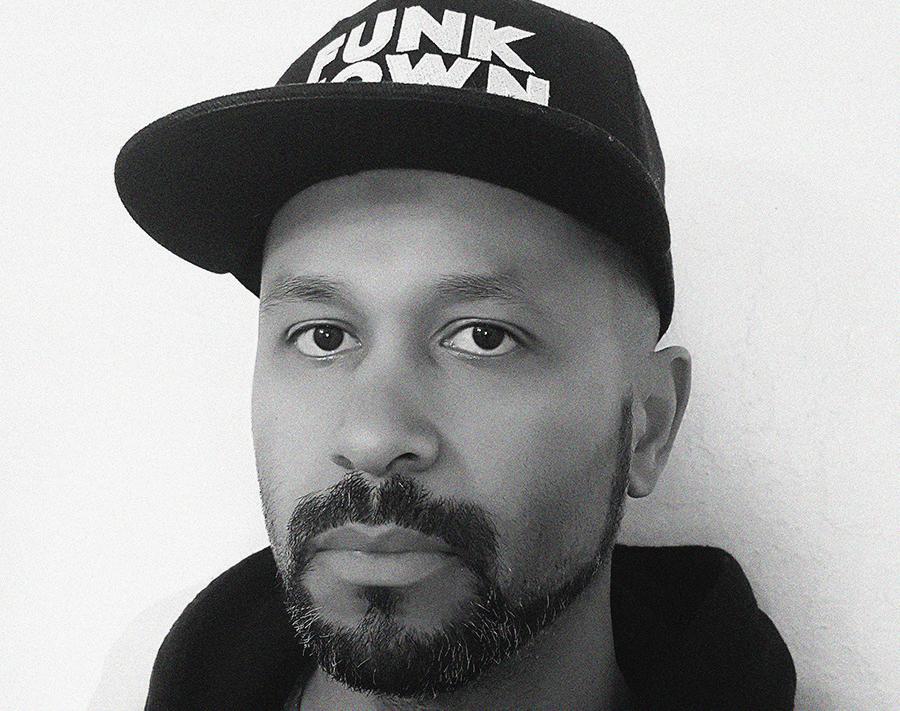


instagram: mark_j_chua
Albert is a music producer, record shop owner, DJ, graphic designer, and co-founder of Needle to the Groove Ent. As an in-house producer, he’s currently working with Casual, Diamond Ortiz, and Valley Wolf, among others.

Instagram: djalbertjenkins
SONYA
Sonya is a San Jose reporter whose work has appeared in the Silicon Valley Business Journal, San Jose Spotlight and Metro Silicon Valley
Twitter: smhsoftware

BRANDON
Brandon is 408 born and raised. He has covered music and local arts for nearly a decade. When not writing, he dreams up ideas for new mixes and accumulates too much vinyl.
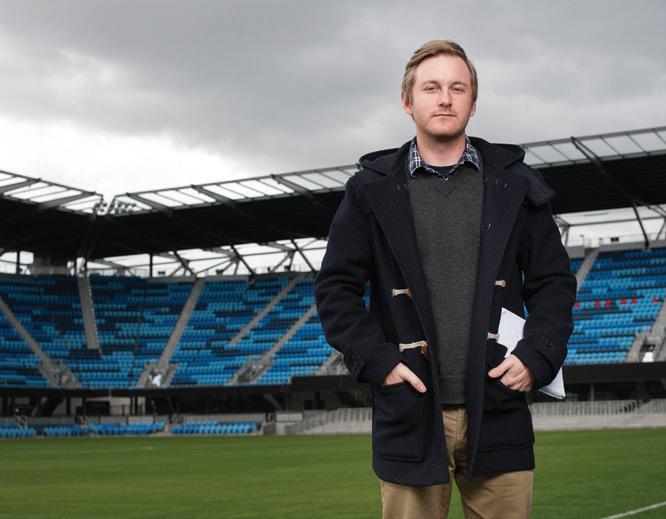
Instagram: brandiathan
MICHELLE
Part-time writer, full time tech worker, Michelle spends her free time with her partner, dog, and cat. She is always cooking up vegan recipes, listening to audiobooks, and enjoys going to the gym whenever possible.
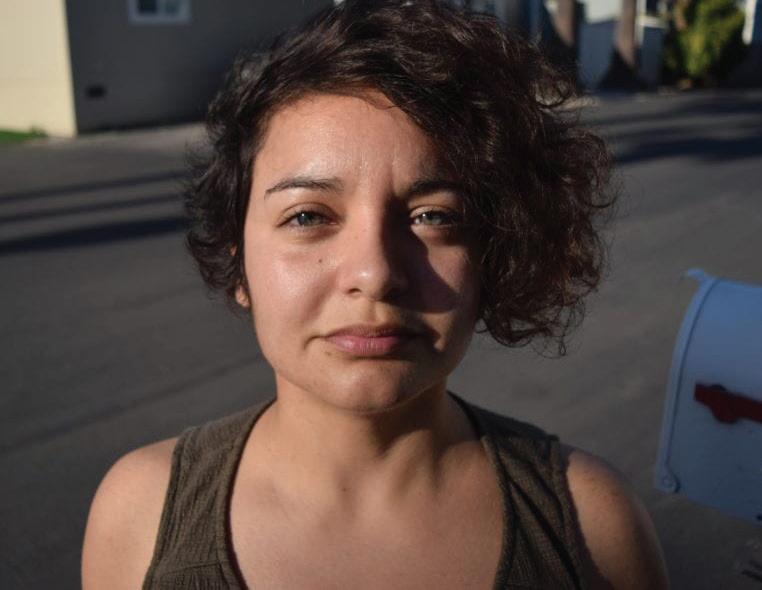
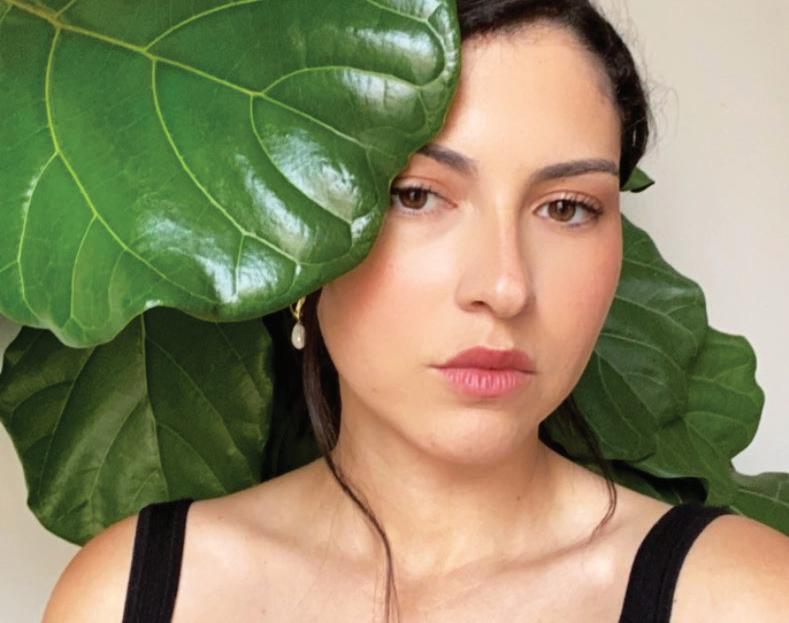
instagram: michrun13
Instagram: jrgphotography
KATHERINE
Katherine is a freelance copyeditor and practitioner of the healing arts. She offers people pockets of rest and rehabilitation through Yin yoga, Restorative yoga and Yoga Nidra. She finds much freedom and play within the world of words and sound ~ check out her meditations on Insight Timer.
Instagram: katherinehypes
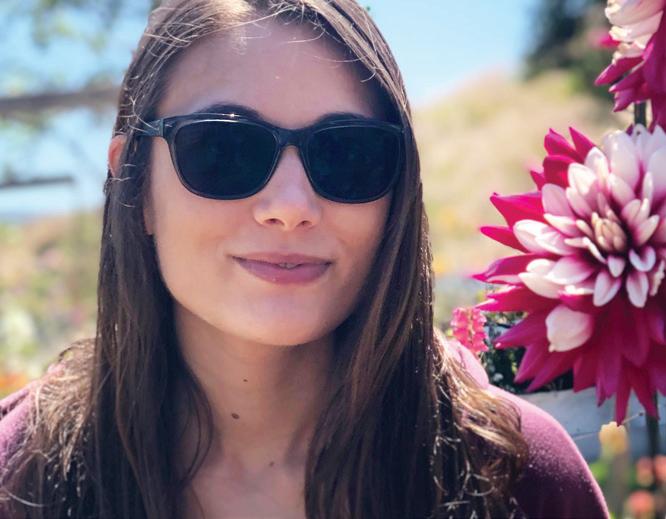
SEEK 10.0 80
VERONICA LECHUGA
RUNDE
C
MARK J. CHUA
HERRERA
ROOS
ALBERT JENKINS
HYPES
JAMES GARCIA
A San Jose native, James has photographed genres from lifestyle to product for 16 years. Outside of photography, James drives his classic car, rides his motorcycle, or spends time with family.
Profiles 13.4 80



IN ASSOCIATION WITH PRESENTED BY IN ASSOCIATION WITH PRESENTED BY IN ASSOCIATION WITH PRESENTED BY IN ASSOCIATION WITH PRESENTED BY IN ASSOCIATION WITH PRESENTED BY MAY 7 - DEC 17 SOUTH FIRST STREET between San Salvador & William streets Building Better Communities A SAN JOSE DOWNTOWN ASSOCIATION PRODUCTION sjdowntown.com Park in the Second & San Carlos Garage. Parking is free for the first 90 minutes. ParkSJ.org LP / CD / Cassette / Digital www.needletothegroove.net / @thegroovesj / needletothegroove.bandcamp.com Limited Merch Available Now! SUNDUR - Somewhere There’s Music
Save the date for Hope Services’ largest fundraiser of the year, benefiting programs and services to more than 3,200 Bay Area individuals of all ages with developmental disabilities and co-occurring mental health needs.
Hope Services is grateful for over 45 sponsors and partners, * that represent a vital investment in helping bridge the gap from state funding.










For additional information or sponsorship opportunities: concert@hopeservices.org or 408.284.2862
*For a complete list, visit hopeservices.org/concert

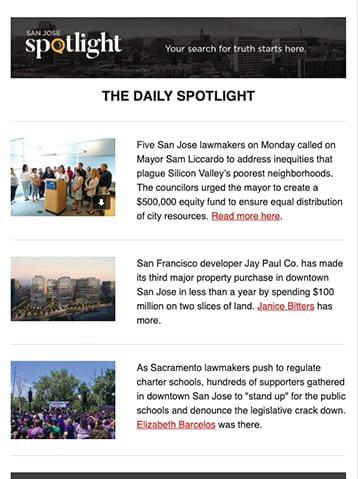
5X GRAMMY WINNER


2020 ROCK & ROLL HALL OF FAME INDUCTEE





SA TURDA Y , OCTOBER 2, 2021
VIRTUAL BENEFIT CONCERT FEATURING
Michael McDonald
MULTI GRAMMY NOMINATED ARTIST
San Jose’s fi rst nonprofi t news site dedicated to independent, truthful news Follow our award-winning coverage: SIGN UP FOR OUR DAILY NEWSLETTER: @spotlightsj | @sjspotlight | @sjspotlight www.sanjosespotlight.com
Mindi Abair
NEXT ISSUE Discover 14.1 Next Pick-Up Party Depending upon County Health Ordinances SAN JOSE 2021 WWW.CONTENT-MAGAZINE.COM social media: contentmag ANNUAL MEMBERSHIP- $42.00 SINGLE ISSUE- $14.95 SUPPPORT www.content-magazine.com SILICON VALLEY’S INNOVATIVE & CREATIVE CULTURE made in san jose, ca

































 Top Left: Head in the Clouds
Top Right: Saint Honey, Patron Saint of Hot Chips and Choking Above: Be my BB
Top Left: Head in the Clouds
Top Right: Saint Honey, Patron Saint of Hot Chips and Choking Above: Be my BB

 Written by Taran Escobar-Ausman
Photography by Avni Levy Instagram tranquilpurple
Written by Taran Escobar-Ausman
Photography by Avni Levy Instagram tranquilpurple





 Written by Katie Shiver
Written by Katie Shiver





































 Intro Written by Anya Evfimiou Photography by Daniel Garcia westvalley.edu Instagram westvalleycollege wvcfashion
Intro Written by Anya Evfimiou Photography by Daniel Garcia westvalley.edu Instagram westvalleycollege wvcfashion




 Bonnang Kim
Maria Iordache
Bonnang Kim
Maria Iordache






 Nazrin Zamini
Rebecca Martinez
Nazrin Zamini
Rebecca Martinez



















 Written by Brandon Roos
Photography by Daniel Garcia Instagram flipsidelovers akro1 ambitiousØutsider Youtube flipsidelovers
Written by Brandon Roos
Photography by Daniel Garcia Instagram flipsidelovers akro1 ambitiousØutsider Youtube flipsidelovers










 Written by Brandon Roos Photography by Stan Olszewski Instagram barelyfunktional akro1
Written by Brandon Roos Photography by Stan Olszewski Instagram barelyfunktional akro1









































